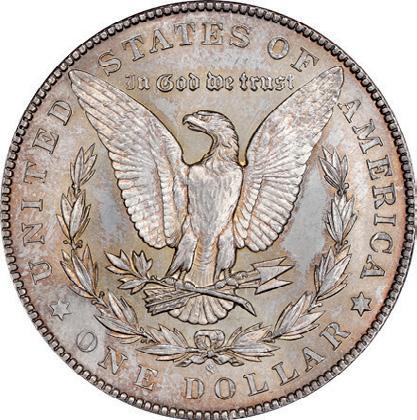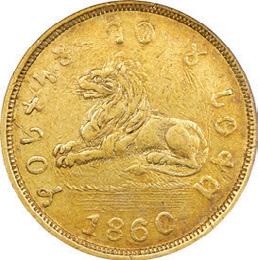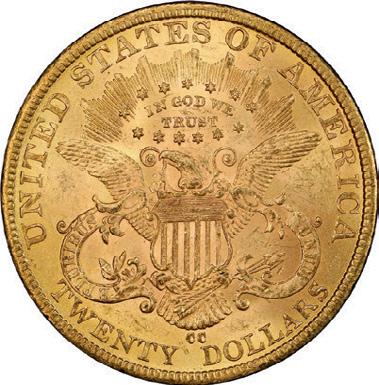






































A Collectors Universe Company www.PCGS.com
Editor-in-Chief Joshua McMorrow-Hernandez
Director of Advertising & Marketplace Taryn Warrecker
Content Manager Arianna Tortomasi
Lead Designer James Davis
Cover Artist James Davis
Distribution Coordinator Ronald Burnett
Subscriptions:
Single Issue: $14.95
One-Year Subscription (6 Issues): $79.99
PCGS Market Report is offered as a premium to PCGS Authorized Dealers and PCGS Collectors Club members.
To become a PCGS Authorized Dealer, contact:
Dealer@PCGS.com
To become a PCGS Collectors Club member, go to www.PCGS.com/join
Printed in the United States. Copyright 2024 Collectors Universe, Inc. All rights reserved. Reproduction of any kind without written permission of the publisher is prohibited by law. PCGS Market Report is published bi-monthly by Collectors Universe, Inc. at P.O. Box 9458, Newport Beach, CA 92658. Postmaster, send address change to Market Report c/o PCGS, Publication Department, P.O. Box 9458, Newport Beach, CA 92658.
Publication of this magazine is not a solicitation by the publisher, editor, or staff to buy or sell the coins listed herein.
Advertising, articles, and other contents of this magazine sometimes contain inadvertent typographical errors, a fact readers should bear in mind when encountering pricing quoted at a fraction of prevailing market values. The publisher is not responsible for actions taken by any person because of such errors. Advertising prices are subject to change without notice.
It’s springtime already, and we sensed from the busy pace at the Florida United Numismatists Convention in January and Long Beach Expo in February that the hobby has plenty of panache in 2024. Heading into the second quarter, the numismatic scene flourishes with many opportunities ripe for the collector’s picking, including a host of major coin shows across the country and a lineup of exciting auctions to boot.
Much of the action spills over onto the pages in this issue of PCGS Market Report. Let’s start with the 50 State Quarters program, which many of us will remember back in the day was about the hottest thing this side of Bicentennial coinage. As the state quarters turn 25, we revisit some of the incredible highlights of this coin program, which turned a page on a whole new era of modern American coinage.
Next, we’re dialing it back to 1865, the year the U.S. Mint produced some very rare Liberty Head Quarter Eagles. Doug Winter goes into detail on what makes these coins so difficult, and the challenges buyers must consider when adding one to their collections. Treasure coin expert Sean M. Scott takes us on an eerie exploration of the Saint Lambert skull tokens, and Chinese coin guru Peter Anthony will take us to the bourse floor of a major coin show in Beijing.
While overseas, we’re going to meet up with Sophie Welch, a 20-year-old British collector making a name in the numismatic auction world, and Speedysquirrel will show us their stunning collection of wildlife coins spanning the globe. Error specialist Jon Sullivan of Sullivan Numismatics talks clipped planchets and off-center errors, and Charles Jonath from Vegas Coin Dealer pays tribute to some special dollar-coin patterns bearing designs by famed U.S. Mint chief engraver James B. Longacre. You’ll also find the usual variety of insightful columns from all your favorite PCGS experts!
Finally, we’re proud to showcase a true national treasure in our Coin of the Issue column. Stack’s Bowers Galleries is offering a magnificent George Washington Funeral Medal, graded PCGS MS65, that is encased in jewelry housing from 1800. This is exactly how this specific medal was intended to be displayed. As one original advertisement proclaims, it was made “for the ladies” and designed to be worn by those mourning the death of the Revolutionary War hero and first United States president. All I can say is this piece is simply stunning – it’s amazing it’s even still intact after more than 220 years. I think you’ll be fascinated by the story behind this ultra rarity.
Let me take this opportunity to also remind you that there are some great coin shows coming up as we head into spring. PCGS will be at the American Numismatic Association National Money Show in Colorado Springs, Colorado, March 14-16, and Whitman Expo in Baltimore, Maryland, March 21-23. Then, April 2-6 is the PCGS Members Only Show in Oxon Hill, Maryland, and you won’t want to miss that. We at PCGS hope to see you there!
With warm wishes,
Joshua McMorrow-Hernandez Editor-in-chief, PCGS Market Report





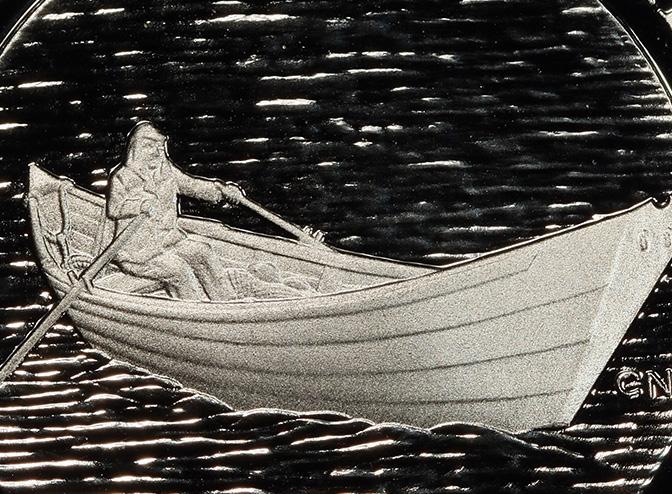



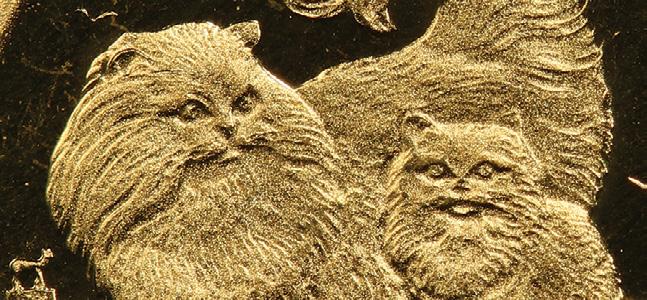


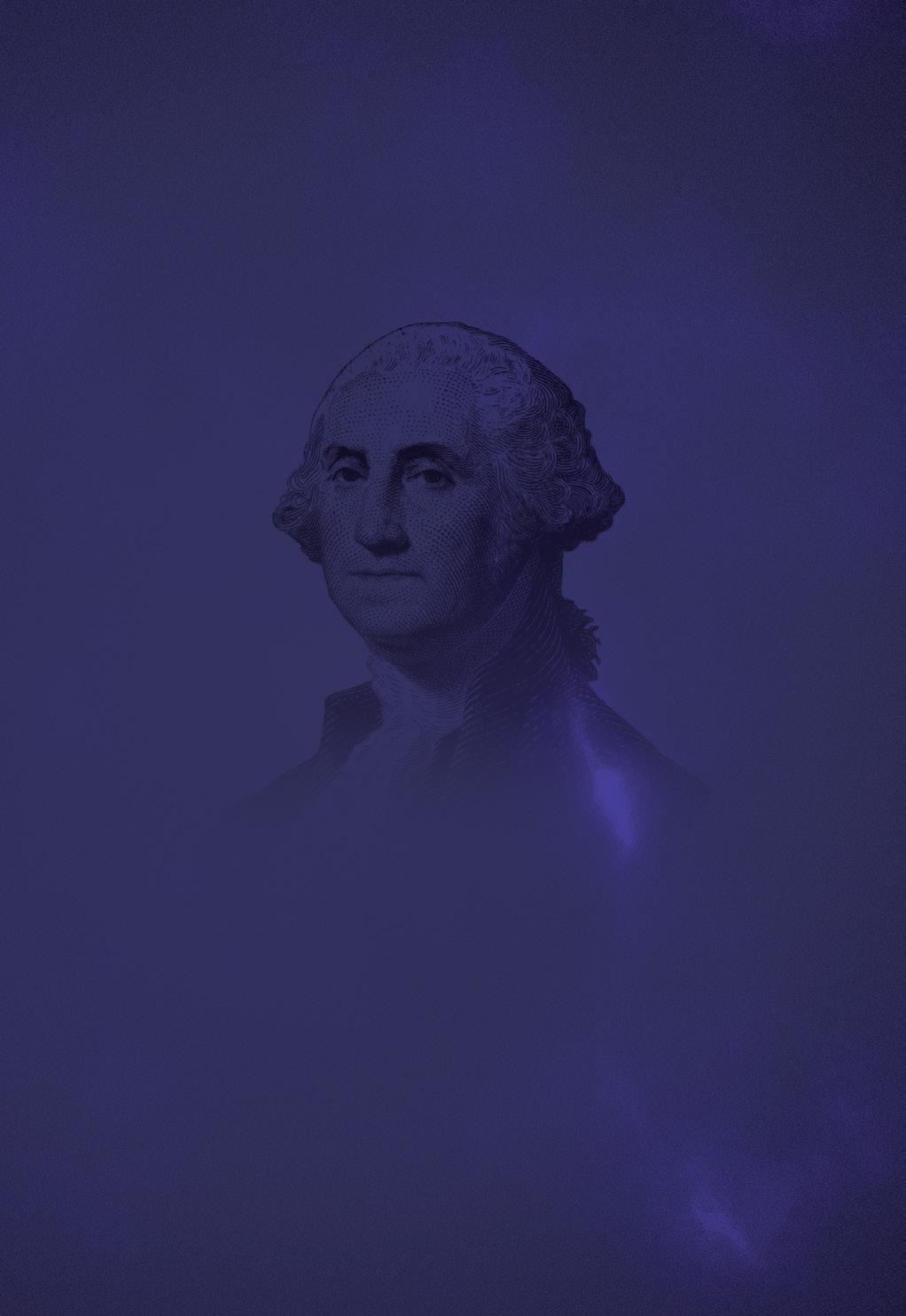
Circa 1800 Washington
Funeral Medal PCGS MS65A Unique National Treasure
Pg 48 –



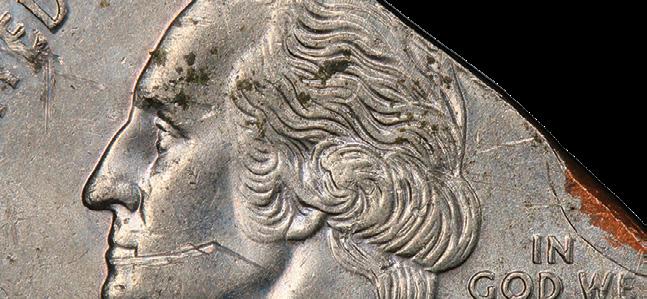

A Quarter Century: Statehood Quarters Turn 25
Joshua McMorrow-Hernandez reviews highlights from the 50 State Quarters program, which debuted 25 years ago in 1999.
Memento Mori: The Skull Tokens of Saint Lambert
Treasure coin expert Sean M. Scott tells the tale of Saint Lambert’s Communion Tokens, replete with skulls and crossbones!
The Curious Case of the 1865 Quarter Eagle (Or, A Collector's Dilemma)
Gold coin expert Doug Winter discusses the enigmatic 1865 Liberty Head Quarter Eagle, a deceivingly rare coin that perplexes many buyers.
PCGS Set Registry: Republic of India Proof Sets of the 1970s
World coin expert Sanjay C. Gandhi explores the many collecting opportunities ripe for the picking among the India Proof Sets from the era of big cars, bigger bellbottoms, and boogeying Bee Gees.
Two Exciting Options for Collecting Off-Center Coins
Jon Sullivan examines two popular modern U.S. sets that can be built with off-center errors.
Collector Spotlight: Speedysquirrel Goes Nuts for Wildlife Coins
Animal-themed coins count many fans, including Speedysquirrel, a PCGS Set Registry collector with a furry, feathery flock of wildlife coins from around the world.
Many Happy Returns
Modern Chinese coin aficionado Peter Anthony offers a glimpse of the gala numismatic festivities at the Beijing International Coin Exposition.
YN Corner: A Young Numismatist with a Taste for Idenumia
Meet 20-year-old Sophie Welch, a passionate coin collector building a successful career in the exciting world of numismatic auctions.
Collecting Clipped Planchet Error Coins
Jon Sullivan reveals the fascinating world of clipped planchet error coinage.
The PCGS Members Only Show Goes to Washington – D.C., That is!
Vic Bozarth takes on a journey to the nation’s capital, where one of the next PCGS Members Only Shows will soon be held.
Unveiling the Timeless Legacy of James Longacre's Indian Princess Dollars
Charles Jonath reveals 19th-century U.S. Mint dollar coin patterns carrying iconic designs by chief engraver James B. Longacre.
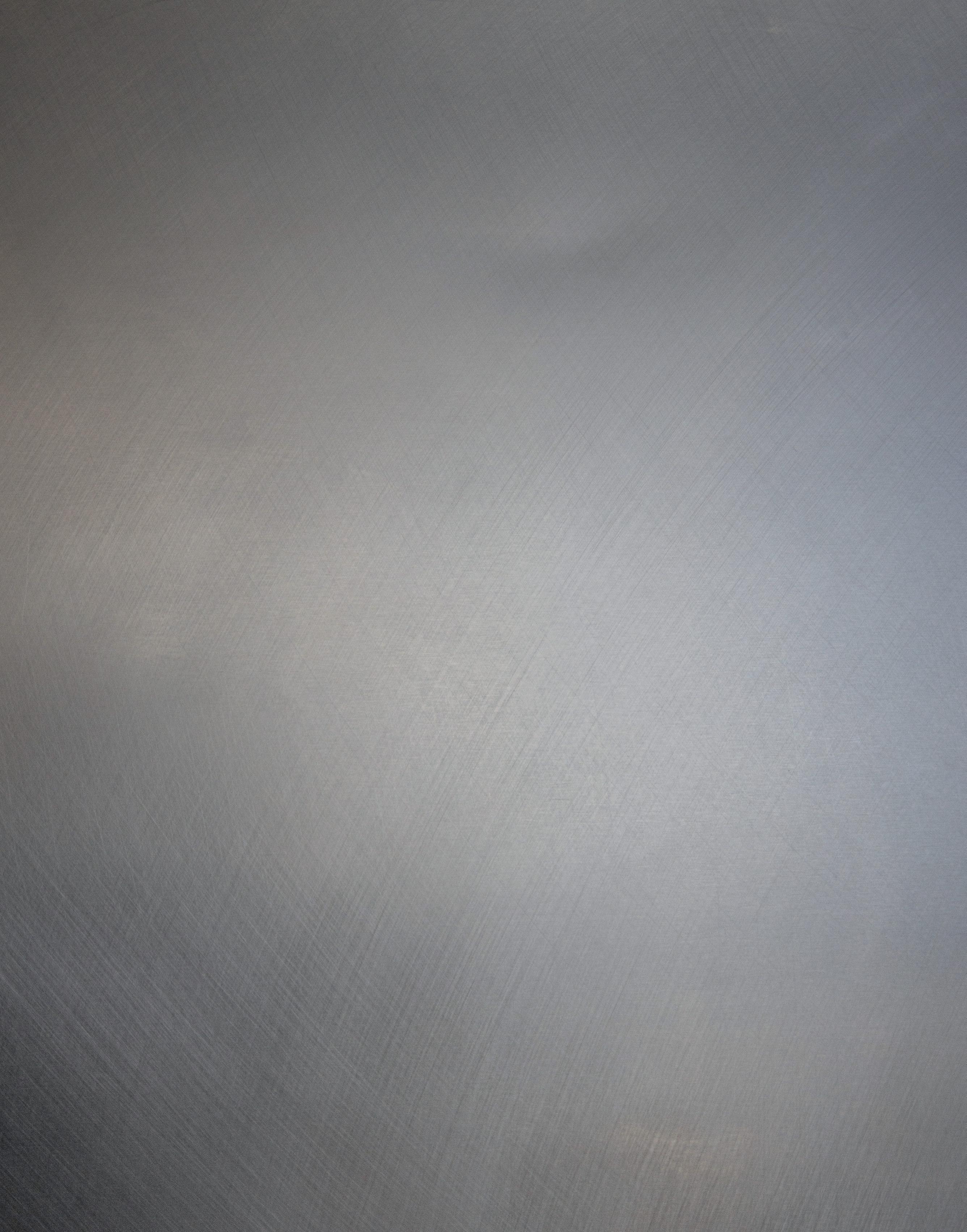





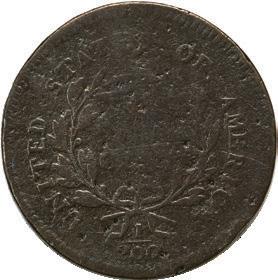















were unlike anything the United States Mint had ever struck. They arose at a time when the U.S. Mint was admittedly producing very little in the way of new circulating coins –except for some recent though minor die enhancements on the circulating coins of the era.
The Delaware Quarter was the first coin out of the gate, riding into history with its reverse depiction of Founding Father and Caesar Rodney astride his horse. On July 2, 1776, he rode more than 70 miles overnight in a thunderstorm from Dover, Delaware, to Philadelphia to cast a deciding vote in the Continental Congress favoring national independence. Delaware was chosen as the first state honored on the quarter, given it was the first state to join the nation. The series wrapped up in 2008 with Hawaii, the last state to that point admitted to the Union.
Those two coins and the other 48 quarters that came along in between catalyzed much numismatic fervor for a full decade. During that time millions of new coin collectors were minted, and for a good decade the hobby benefitted from a flurry of media attention that many would say has not been matched since.
While the 50 State Quarters was a very American concept, it was inspired by a successful circulating coin program that the Royal Canadian Mint endeavored upon in the early 1990s. The 1992 Canada 125 Quarters honors each of the nation’s then-12 provinces and territories and were released into circulation over the course of the year that marked the 125th anniversary of the country’s confederation.

One of the 1992 Canadian Quarters commemorating Canada’s 125th anniversary of confederation and the nation’s various provinces and territories. Courtesy of PCGS.
The program spurred millions of Canadians to check their change for the new quarters, bringing a new interest to the hobby throughout the land widely known as “The Great White North.” This compelled numismatic advocates on the United States side of the border to consider a similar initiative.
Many members of the Citizens Commemorative Coin Advisory Committee (CCCAC), which had been established
by law in 1992, were opposed to the idea of a state quarters program as proposed by numismatic author and expert David Ganz. However, as time went on more CCCAC members warmed to the ambitious idea, with the committee formally endorsing the proposal in 1995.
But who would be their voice in Congress, whose approval was necessary for moving a state quarter program from vision to reality? Delaware Representative Michael Castle was the chairman of the House Banking subcommittee at that time, and getting his support was key for moving any legislation authorizing such a coin program before a vote in Congress.
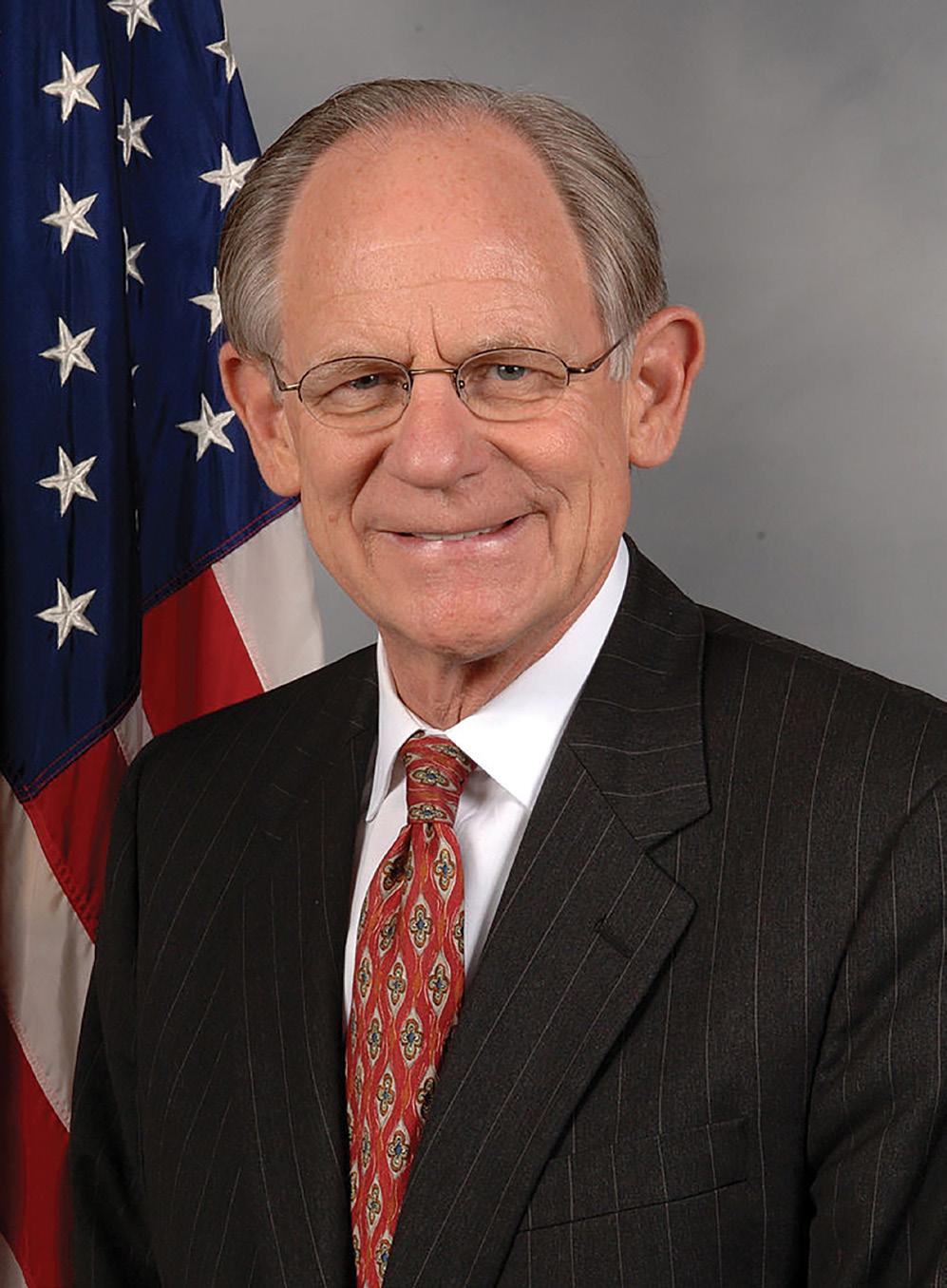
legislation for the state quarters.
Still, there were many legal and logistical obstacles to overcome. Namely, there were concerns about the sheer immensity of a circulating coin program commemorating all 50 states. Nothing like the state quarters had ever been proposed before, let alone enacted. Besides, other commemorative programs from years earlier had led to financial abuses and other shortcomings. What would ensure a different outcome this time?
Diehl and Castle posed well-researched models suggesting a state quarter program could yield well over $2 billion in government profits, though even this failed to move Treasury officials closer to offering their blessing. Eventually, Treasury officials acquiesced by proposing that a feasibility study be conducted to determine whether such a macroscale coin program could even be executed. Language authorizing such a study was built into the framework of the United States Commemorative Coin Act of 1996, which was signed into law by President Bill Clinton on October 20, 1996.
The findings of the study resoundingly pointed to successful outcomes for the state quarters if they were authorized into law, though the Treasury remained unconvinced that the coins would ever generate the profits or public interest pitched in the findings of the feasibility study. The matter was taken up by Congress again, which formally legislated a circulating state quarters initiative. The 50 States Commemorative Coin Program Act was approved by Congress and signed into law by President Clinton on December 1, 1997.
The 50 State Quarters were released during one of the most numismatically colorful periods of the past six decades. The debut of the state quarters marked the launch of a first-ofits-kind commemorative coin program. It went on to spawn several similar multi-year commemorative coin series, some of which continue to this day – among them the American Women Quarters, the Native American Dollars, and American Innovation Dollars.
Castle became supportive of the idea after United States Mint Director Philip Diehl proposed such a program would unfold with each state being honored in the order they were admitted to the Union. This means that Delaware, the first state to ratify the United States Constitution, would therefore become the first state recognized on the proposed quarters. It wasn’t long before Castle moved forward in preparing
Not only did the 50 State Quarters emerge in 1999, but so, too, did a one-year revival of the Susan B. Anthony Dollar. The mini cupronickel dollar, originally struck from 1979 through 1981, was re-released to meet increasing demands for dollar coinage one year before the U.S. Mint could legally distribute the Sacagawea “Golden Dollar,” which itself was much ballyhooed months ahead of its early 2000 public unveiling.
Numismatics was on fire during the dawning of the 21st century, and leading the charge were the 50 State Quarters. During the height of the program, the U.S. Mint estimated



The American Women Quarters, Native American Dollars, and American Innovation Dollars are ongoing multi-year commemorative coin series that likely wouldn’t have happened if not for the incredible success of the 50 State Quarters Program many years ago. Courtesy of PCGS TrueView.
that 147 million Americans were collecting the state quarters. That figure is most likely far greater than the number of active collectors today, but many of them stayed on with the hobby even after the excitement around the 50 State Quarters subsided by the end of the program in 2008. We know this because so many collectors today – and not just “the kids” – recount coming into the hobby during the hubbub of the 50 State Quarter program and reported the state quarters as among the very first coins they ever collected.
Leaving a Legacy
Many people don’t remember or may not realize the unprecedented influence the 50 State Quarters had on the
hobby until looking at the number of collectors today who still hold cherished memories of finding “their” state’s quarter in circulation for the first time. Many were in grade school – others were enjoying retirement. All were touched by one common thing – the 50 State Quarters. These coins were themselves largely common in the numismatic sense, yes. But they were also unlike anything the American public had ever seen in their pocket change.
Many collectors who built 50 State Quarters using folders or coin boards more than 20 years ago have since moved their collections into PCGS Registry Sets. And many of these collections have advanced beyond date-and-mintmark representations of the 50 different designs. The 50 State

Quarters yielded an astounding number of varieties, with the 2004-D Wisconsin High and Low Leaf Quarters and various 2005-P Minnesota Doubled Die Reverse Quarters the most widely collected among these.
Some of these coins are decidedly rare and valuable, while others are relatively affordable curiosities. Yet, all add an exciting dimension of challenge to collecting the 50 State Quarter series, and they offer collectors a pathway into an even deeper level of the hobby that keeps the numismatic multitudes wanting more.
More is what so many collectors wanted a generation ago, and more is exactly what the 50 State Quarters have provided the hobby since 1999. One of the beautiful things about the 50 State Quarters is that they continue circulating today, offering millions of non-collectors an accessible gateway into the hobby. They also serve as a springboard toward other areas of the hobby, bridging the chronological gap in many respects between the modern “now” of our hobby and a notso-distant but decidedly different “then” – that period before the quarters, an era that now seems vintage to so many.
As the pop-culture milieu of the 1990s and 2000s now itself becomes retro in the eyes of Millennials and Generation Z, who are increasingly shaping the direction of today’s world, may we also see a revival of interest in the 50 State Quarters? It’s hard to say… The quarters were about as
ubiquitous at one point as flip phones and Blockbuster. Video rentals haven’t yet staged a comeback, but flip phones are all the rage once more. Could 50 State Quarter nostalgia be all that far behind?

Joshua McMorrow-Hernandez has won multiple awards from the NLG and ANA for his work as a numismatic journalist and editor. He has been a coin collector since 1992 and enjoys all areas of United States coinage and U.S. minting history.
World Regular & Economy Grading Special:
through Economy or Regular


Variety Attribution Special: Save $8 for each coin that receives a variety and $4 for each that does not.


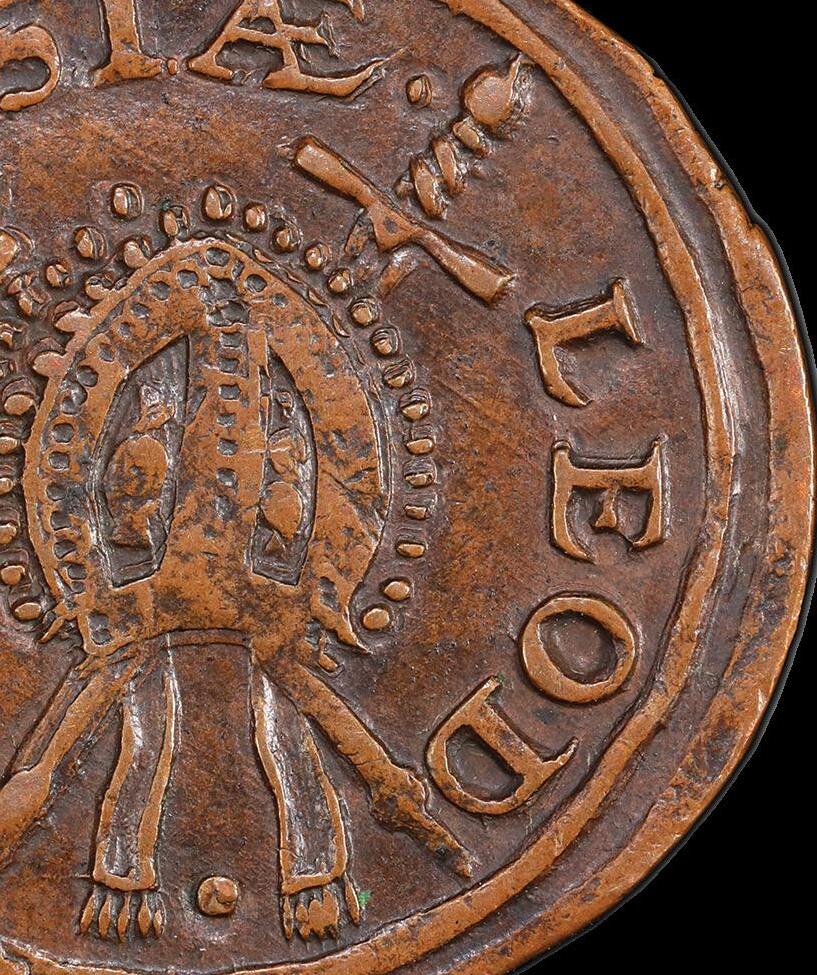
At first glance, one might suspect that these tokens could have an occultic meaning or some affiliation with pirate lore. However, this is not the case. To fully appreciate these tokens, one needs to know a little bit about European church history, what the symbols represent, and why these pieces were made. So, let’s dive in and investigate the fascinating history of Saint Lambert’s Communion Tokens!
Lambert of Maastricht, commonly referred to as Saint Lambert (circa 636 A.D. through circa 705 A.D.), was born in Maastricht, a city in the province of Flanders (The Netherlands). He was the bishop of Maastricht-Liège from about 670 A.D. until his death.
While few details of Saint Lambert’s life are known, historians and religious scholars have agreed that he was murdered as a result of admonishing the Merovingian Duke Pepin II (Pepin of Herstal) for adultery with a noblewoman named Alpaida. Saint Lambert is said to have been killed with a javelin while conducting Mass in Liege’s Chapel of Saints Cosmas and Damian by soldiers under the command of Alpaida’s family.
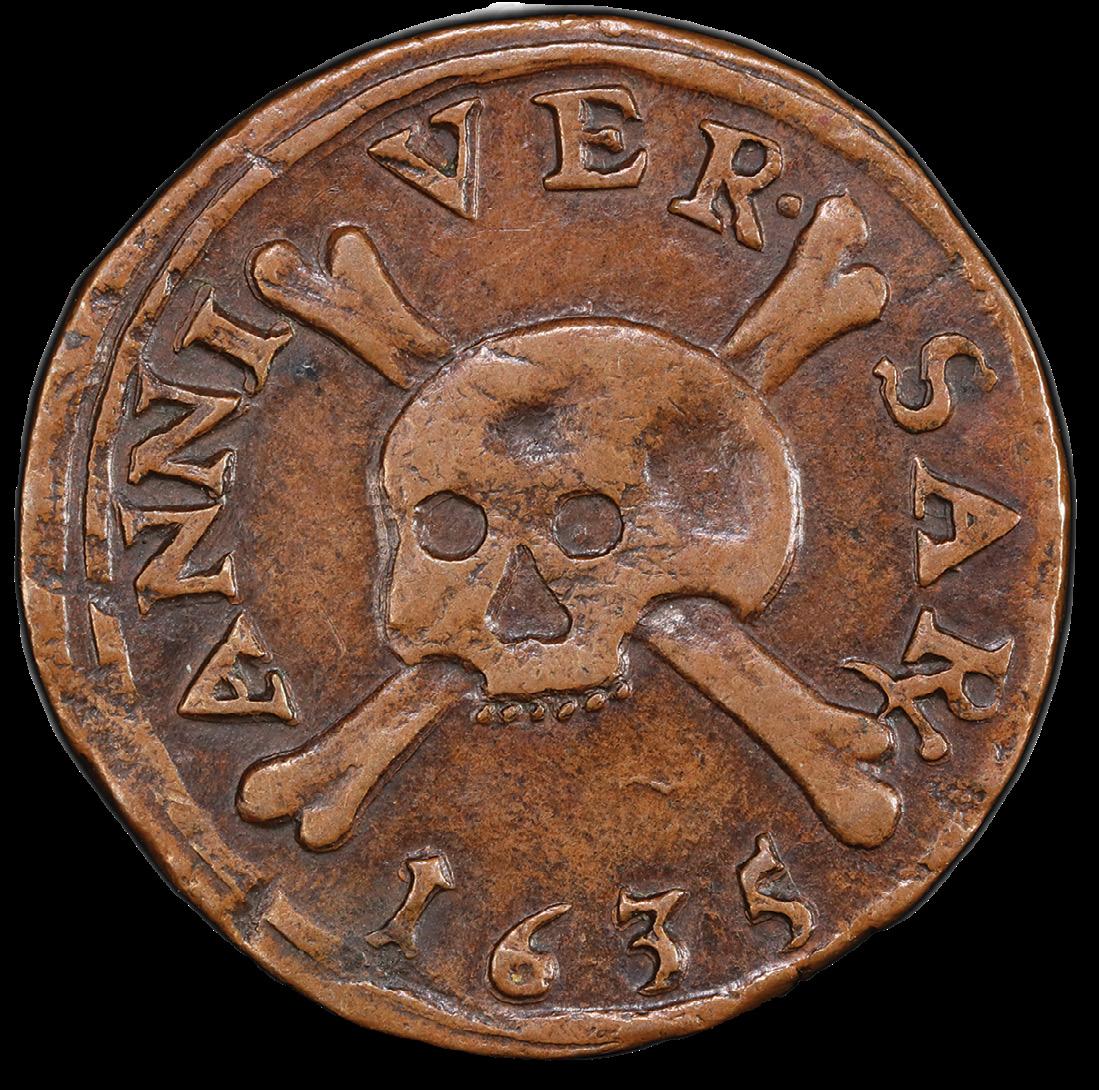

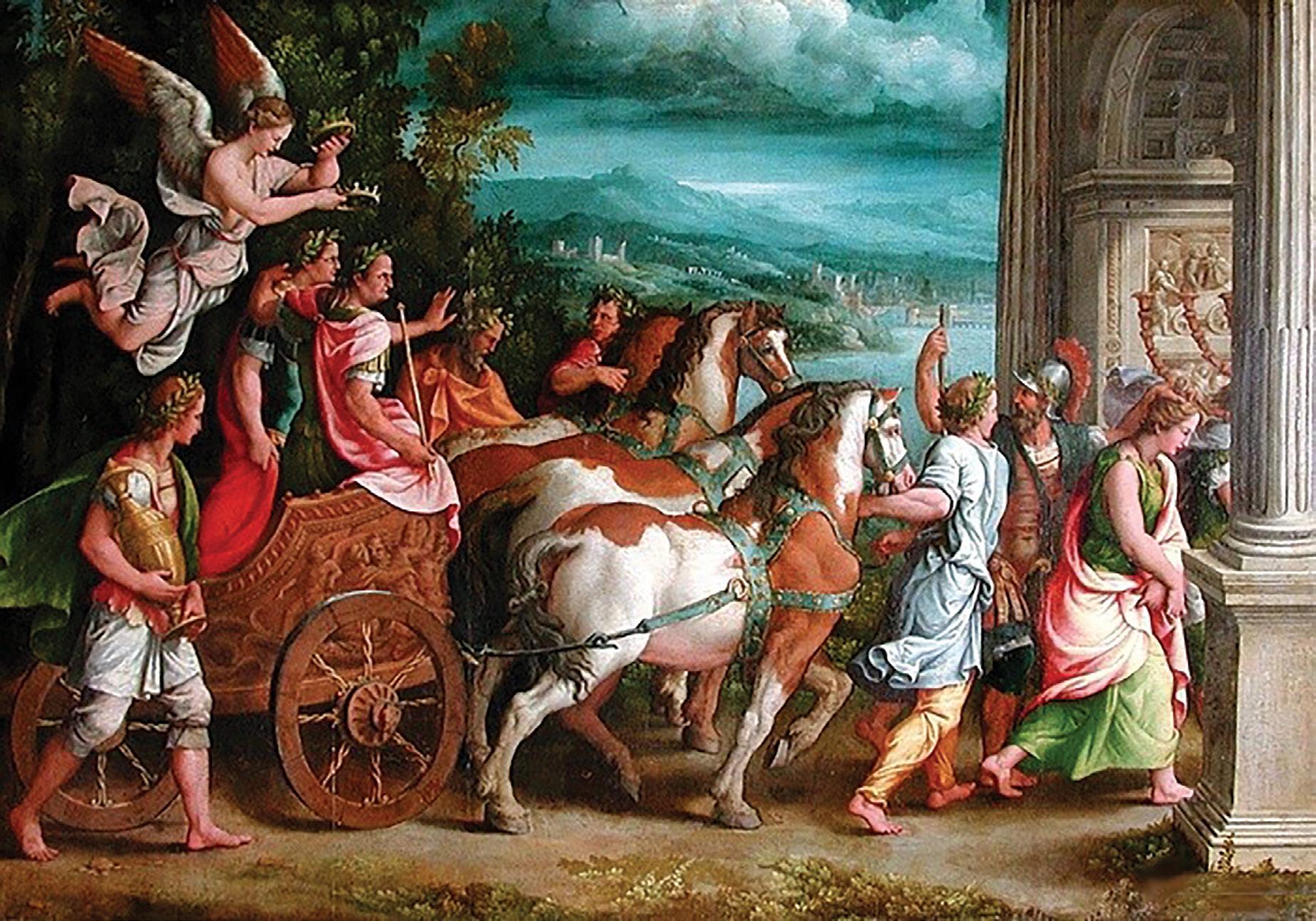
Many believe that Saint Lambert lost his life and obtained sainthood as a result of his deep conviction to defend Holy Matrimony, similar to the example set by John the Baptist when he confronted King Herod as narrated in the Book of Matthew 14:3-14 of the Christian Bible.
Saint Lambert’s body was entombed at Maastricht and later, it was moved to Liège, in the eastern part of modern Belgium, where his relics are honored to this day.
In the mid-1500s, French Huguenots and Scottish Presbyterians began implementing the use of communion tokens. Known in old French as “méreau” or “méreaux,” the word “méreau” comes from the Latin word “merere,” which means to deserve or deserving. Parishioners needed to pass a personal spiritual examination of their life prior to taking communion.
Before taking communion, the elders of the church would interview each person and distribute the tokens to those who prepared their hearts to receive it. Prior to taking the communion elements (typically bread and wine), the believer would give the token to the minister. In addition to being used for communion, these tokens were also likely used during the
Most will agree that the design of Saint Lambert Communion Tokens is quite striking and mysterious. The symbol of the skull and crossbones was used for well over a thousand years by the Romans as “memento mori,” which is a Latin term for “remember death” or “remember you must die.”

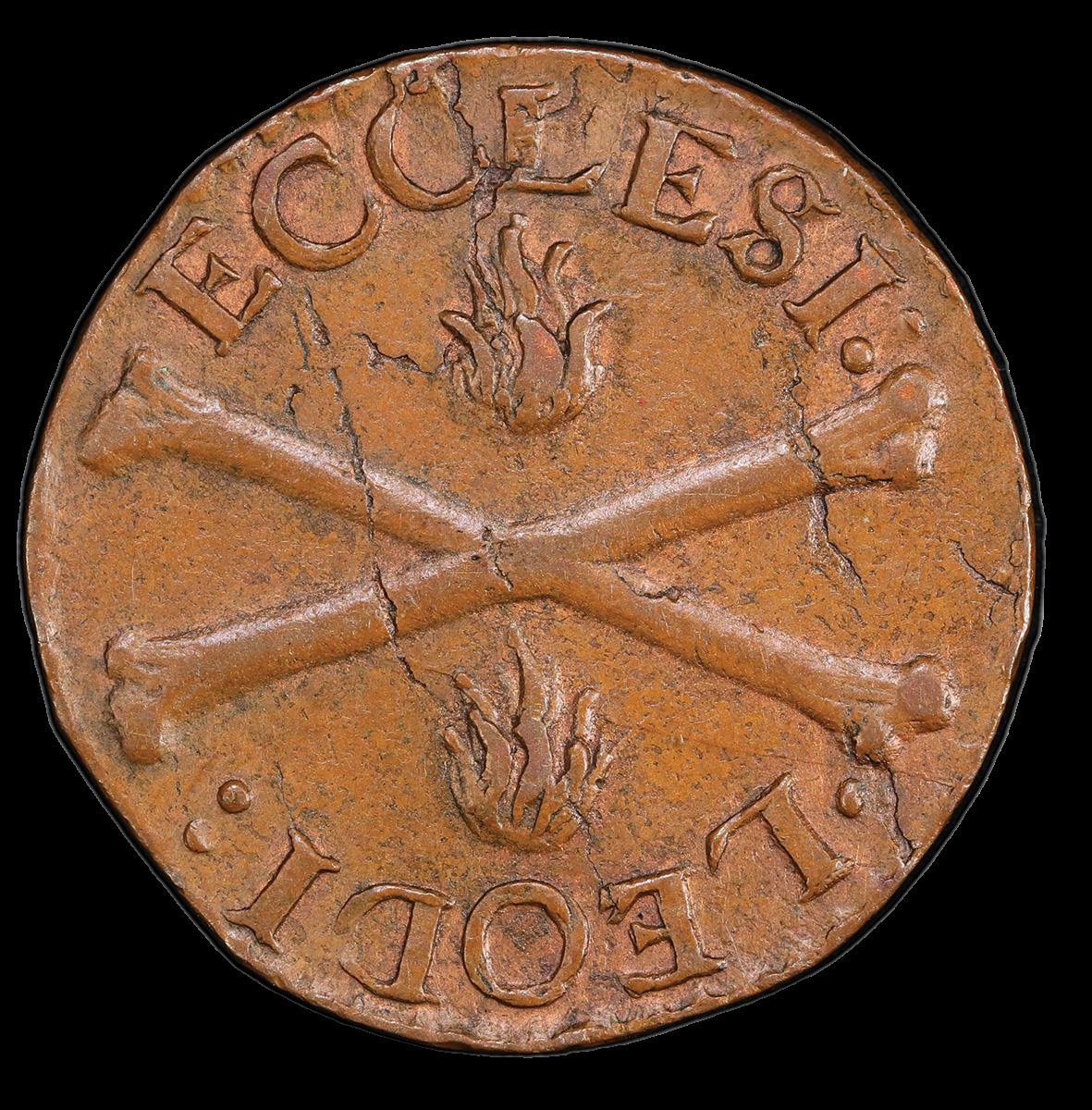
In ancient Rome after a major military victory, the triumphant general, known as a “triumphator,” would be cloaked in royal purple and ride in a golden chariot drawn by four horses. He was then paraded through the streets in a grand procession with his army, prisoners, and the spoils of war.
The general was idolized, viewed as divine by his troops and the public alike. Riding in the same chariot, standing just behind the worshiped general, was a servant. The servant’s sole responsibility for the entirety of the procession was to whisper in the general’s ear continuously, “Respice post te. Hominem te esse memento. Memento mori!” “Look behind you. Remember, you are human. Remember, you must die!” The servant served to remind the victor at the peak of glory, this god-like adoration would soon end, while the truth of his mortality remained.
Memento mori symbols can be seen on some Roman and early Christian tombs. The Knights Templar commonly used it around the 13th century. Most notably, pirates used variations of it on their flags during the golden age of piracy.
Whether these tokens were used to participate in communion, anniversary feasts, funerals, or other church functions, the message they convey is that we are all mortal and need to consider where we will spend eternity.
To get a better feel of what may have gone through the mind of the designers of these tokens, one must remember that these were specifically made for the Cathedral of Saint Lambert in Liège, roughly a thousand years after the saint’s death.
The flame symbols on the reverse of some of the tokens have biblical significance and most likely represent the lifetransforming power of the Holy Spirit mentioned in the Book of Acts. The flame images may also represent Moses’s encounter with the burning bush found in the Book of Exodus.

There are five different varieties of Saint Lambert’s Communion Tokens, each having a different style of skull and crossbones on the obverse.
On the obverse of the first variety, dated to 1635 (which is by far the rarest), you see the typical skull and crossbones, only here, the skull is superimposed over the crossbones in a saltire or Saint Andrew’s cross pattern. The other four varieties show a skull placed above crossed bones. The reverse of the 1635 shows a bishop’s miter (a headdress worn by Roman Catholic bishops) in front of a crosier (a hooked staff carried by a bishop as a symbol of his pastoral office) and a sword.
The legends on the obverse of these tokens vary slightly, but their meaning is the same.
“ANNIVERSARIUM,” “ANNIVERSAR,” and “ANNIVERSARIVM” are Latin variations for the word “anniversary.” The legends on the reverse “ECCLESIAE LEODI,” “ECCLESI LEODI,” or “ECCLE.SIÆ.LEOD” are Latin variations for the phrase “The Church of Liège.”
These tokens were likely commissioned by the church and minted by a local blacksmith on a screw press rather than being hammer struck. There are a number of die variations for each issue, and each piece has its own unique and subtle characteristics.
Here are images of the other four varieties:

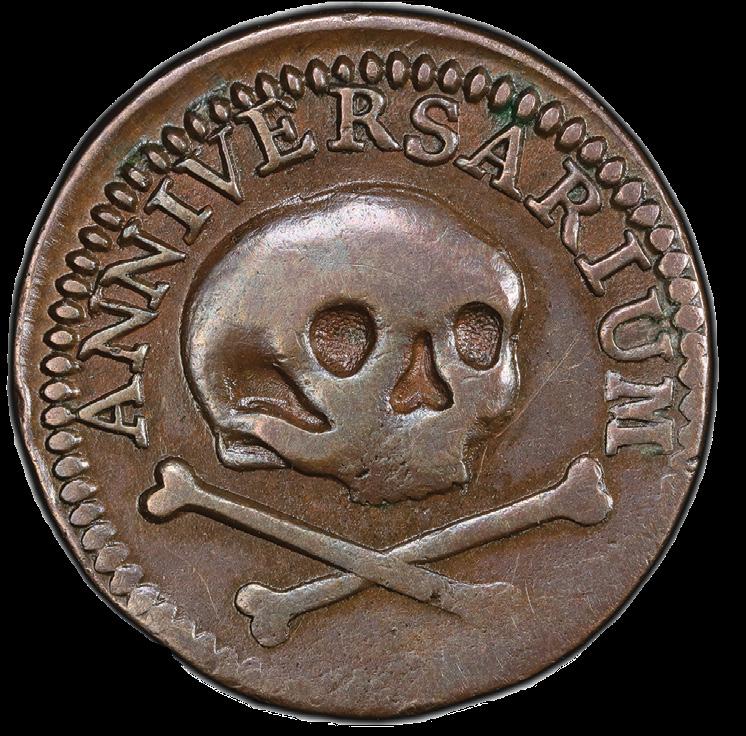

Although Saint Lambert’s tokens are becoming very popular, they are extremely difficult to find in higher grades of preservation. Completing a set of all five will prove to be very challenging, to say the least, and often will be like finding a needle in a haystack!


Sean is President of Commodore Coins & Collectibles, Ltd., located in San Diego, California. He offers a wide range of rare coins and artifacts from the 16th through 18th centuries. For more information, feel free to contact him at Sean@CommodoreCoins.com or visit his website at www.CommodoreCoins.com.

Fo l lo w u s f o r e x c i t i n g n u m i s m a t i c n e w s , e d u c a t i on a l c o n t e n t , a n d th e c h a n c e t o w i n p ri z e s !





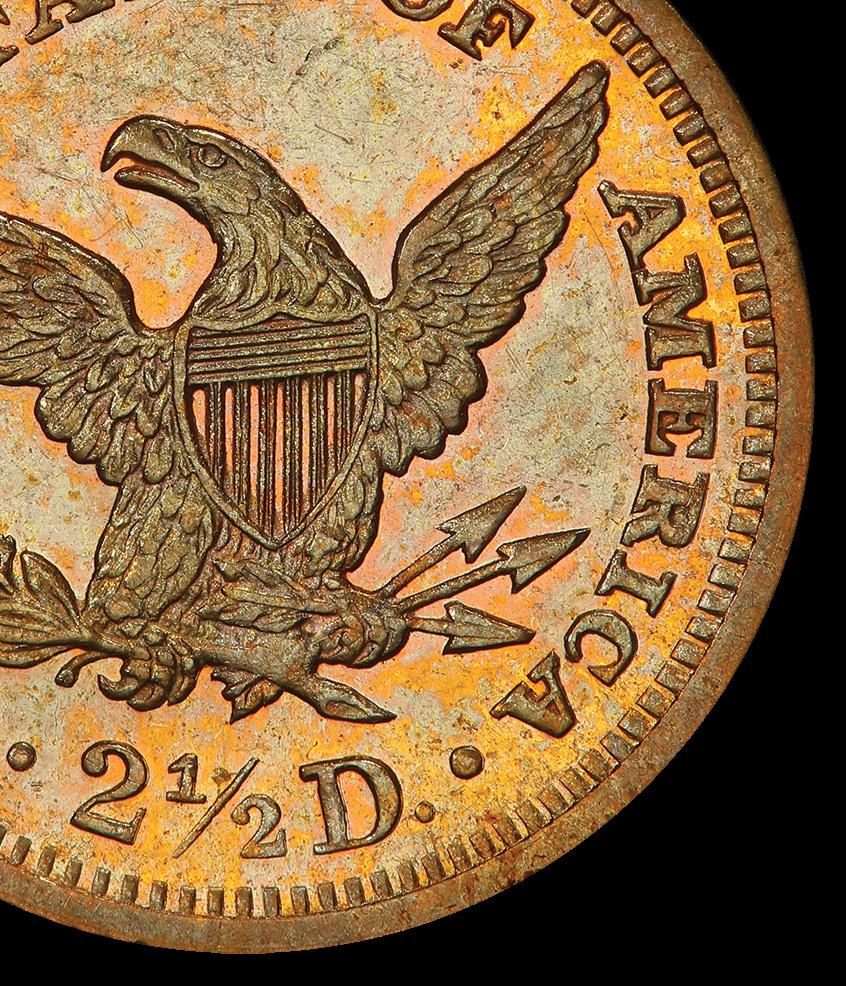



At the February 2023 Long Beach Expo, a client came up to the table and asked if I would look at a coin for him. The coin in question was a PCGS XF45 1865 Liberty Head Quarter Eagle. This seems like a fairly mundane coin if you don’t know the series, but this is actually a rare issue with an original mintage of just 1,520 business strikes and a surviving population of less than 50.
As he placed the coin in front of me, he asked a simple
question. “Should I have bought this coin?” He informed me that he was assembling a complete set of regular-issue 1865-dated U.S. coinage, and this was a coin for which he had been searching in vain for over a decade.
I wasn’t overly fond of the coin as it had a funky orangegold color, which, in my opinion, limited the eye appeal. My first reaction was to tell him, “No, you should have passed.”
Then I began to think when the last time was that I handled
a decent 1865 Quarter Eagle, let alone a nice one. It seemed like a looooong time.
I went onto the PCGS website to search for recent sales. There were only seven sold at auction since 2016, but two were No Grades. There really weren’t many I liked. In fact, the only one that I cared for that had crossed the block in recent memory was an example graded PCGS AU58 that fetched $45,600 at a 2020 Heritage Auctions sale. Cool piece — but way out of this collector’s budget. I should note here as an aside that I sold the finest-known example of the 1865 Quarter Eagle, an amazing PCGS MS63, back in 2002 to the Kansas Collection.
I was intrigued enough to further my search for examples of this coin that had sold at auction and was compelled by what I found.
In just five minutes, I had changed my mind about this collector’s purchase. While I wasn’t crazy about the actual coin, it was entirely possible that if he had passed, he might have had to wait a decade or even longer to even have a shot at a nice XF/XF+… And that’s if such a coin even existed!
And this brings me to the point of this article. If you collect a very challenging series or a specific set, the chances are good that you will be forced to buy at least one coin — maybe a
lot more — which you really don’t like. And you’ll probably have to pay too much for it, to add insult to injury. In the case of the 1865 Quarter Eagle, the collector made a difficult decision, but it was 100% the right one.
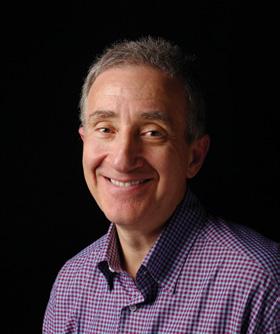
Doug is an award-winning author of over a dozen numismatic books and the recognized expert on US gold. He can be reached at 214675-9897, at dwn@ont.com or through his website, www.raregoldcoins.com.



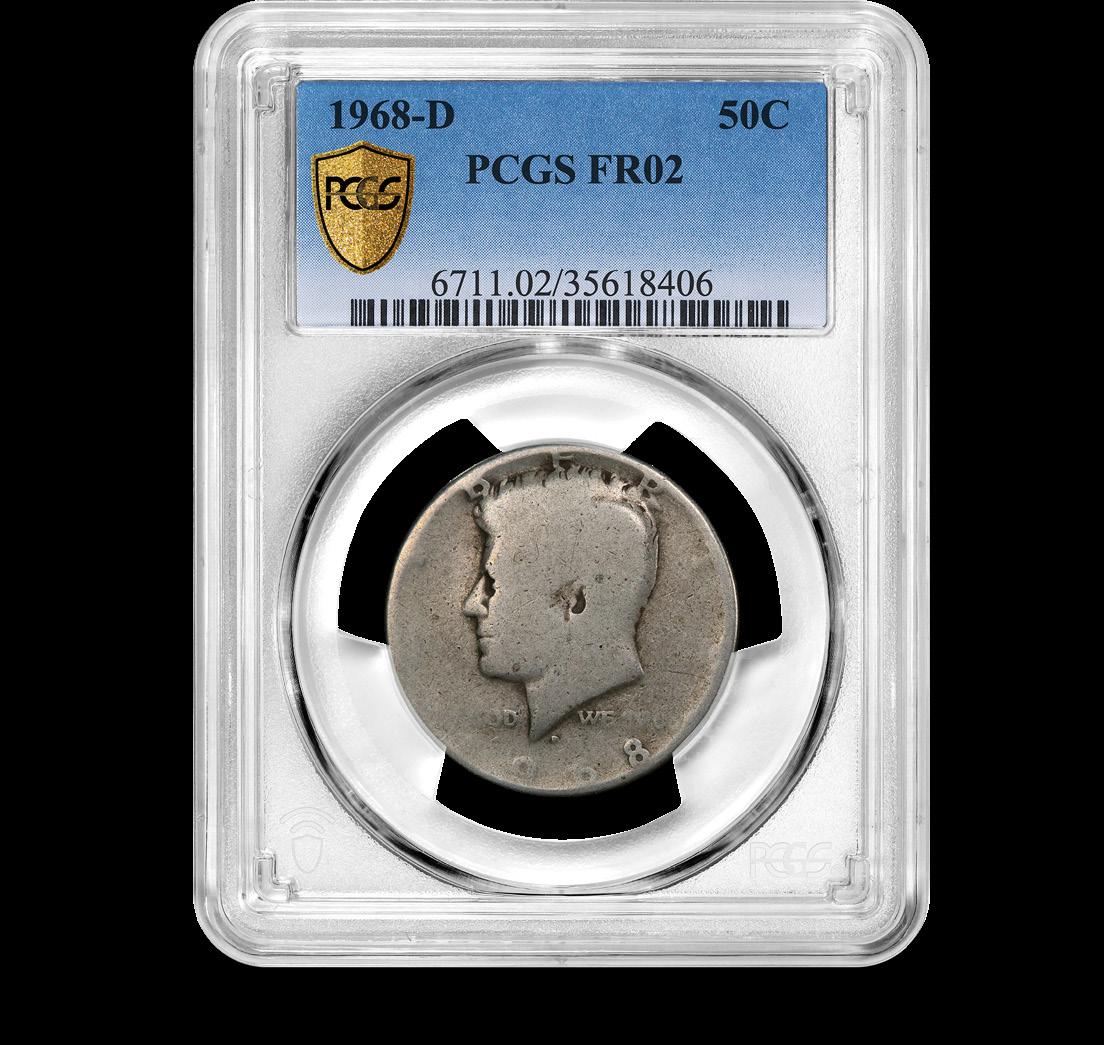




Don’t break the bank. The lower your grade, the higher your rank.
Check out Low Ball Sets here.
Scan here w/camera app on your phone.



boy could get into at the age of eight. One day, my grandfather gave me a large old copper coin. I was mesmerized by its look, and he told me it was old. It wasn’t until 2008 that I had purchased my first coins of India from eBay. About a year later, I started buying proof sets of India and concentrated on the 1970s.
After World War II, the Food and Agriculture Organization (FAO) was founded on October 16, 1945, by the United Nations to combat hunger and improve food nutrition worldwide. The FAO logo, which displays a wheat stalk within a circle, also shows the words fiat panis within the logo, which, from Latin, translates into “let there be bread.” The FAO theme had been used for multiple years within the proof sets of India during the 1970s.
One of the most interesting designs in the proof series is the 1974 50 Rupees depicting two wheat stalks flanking a family of four holding hands. During Indira Gandhi’s tenure in Congress in the 1960s, she teamed up with Lal Bahadur Shastri to spark the Green Revolution, which increased the technological development of wheat that virtually eliminated fungal diseases within farmers' crops. This led India to become the number-two wheat producer globally in 2023.
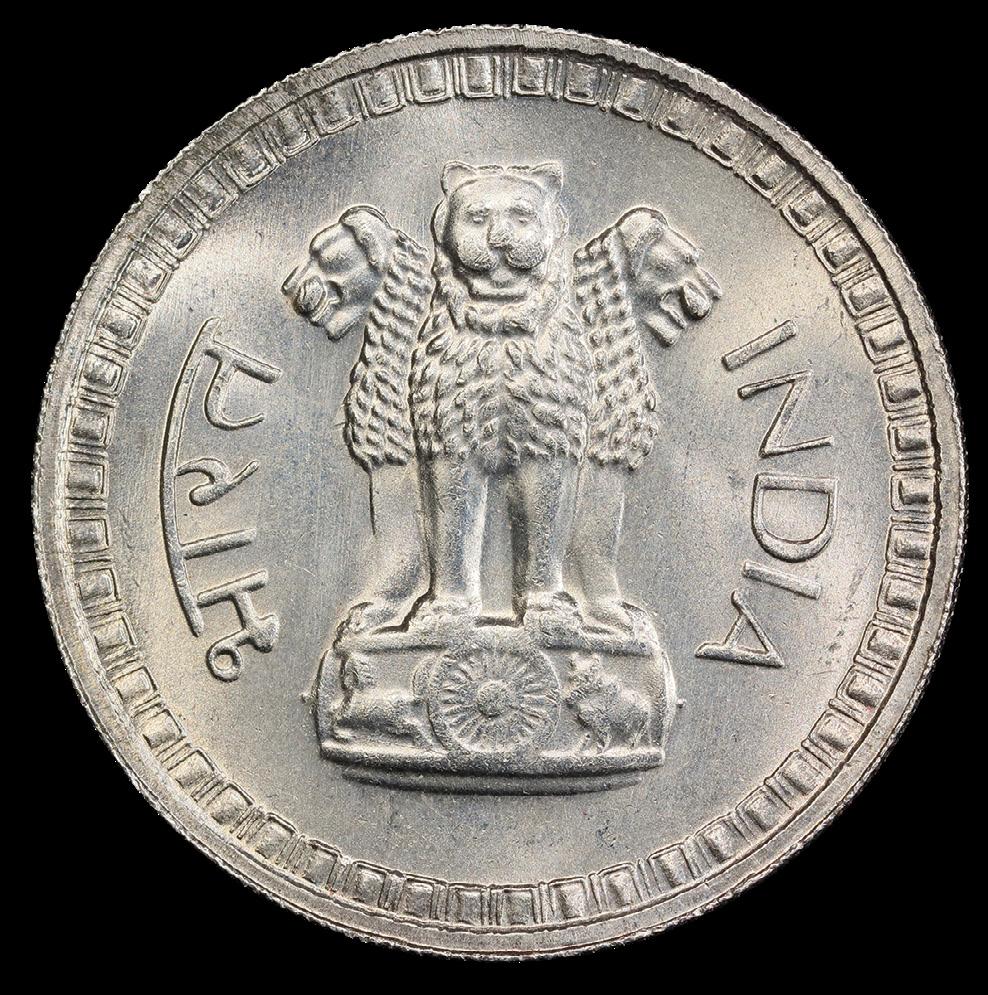
Decimal coinage was first introduced in India in 1957, but it wasn’t until 1962 that the first one rupee coin was struck, and it was composed of 100% nickel. The second one rupee coin produced for circulation was the 1964 Jawaharlal Nehru coin to commemorate India’s first prime minister shortly after

his death. Years passed before a newly dated one rupee coin was struck for circulation in 1970, and this piece is somewhat difficult to find. The scarcity of the coin may have been due to a global nickel shortage. In an article titled “The Big Nickel Shortage” dated November 21, 1969, Time magazine wrote, “On the London Metal Exchange, the main international market, a pound of nickel last week brought $7.70 — about five times more than a year ago. The price was bid to incredible levels by the worst global shortage since World War II.”
Purchasing a 1970 one rupee coin graded PCGS MS65 will probably cost a collector about $200, and its proof counterpart has a mintage of only 2,900 pieces. PCGS Set Registry has listed the 1970-B Republic of India Proof Set for our members to build, which consists of nine denominations struck at the Bombay Mint. In 1971, the Indian government elected not to strike a one rupee coin for circulation, and this decision was more than likely due to the rising nickel prices during 1970. The year 1972 was when the Reserve Bank of India (RBI) chose to use copper-nickel for the 25 and 50 paise denominations. Prior to 1972, these denominations were struck in 100% nickel.
Any collector of Republic of India coins who is seeking a one rupee coin from 1971, 1972, 1973, and 1974 can only acquire them in proof. Struck in 100% nickel, the total mintage for the one rupee coin for all these years is a little under 32,000. Most proof one rupee coins from 1970 to 1974 do not exhibit the best striking quality in terms of detail, and they won’t be

as crisp as one may expect from a proof issue. This is partially due to nickel being a very hard material to strike, and the quality of the dies seemed to be subpar from 1970 through 1974. Proof sets from the years noted above can be purchased for anywhere from $125 to $275, which seems to be somewhat inexpensive given the low mintages, and prices seem to have been range-bound for the past 10 years or so.
The cost of nickel had substantially declined from the record prices that were set in 1970, and the price of the metal was no longer an issue for the government of India. The RBI decided to resume production of the one rupee coin in 1975, which was struck in copper-nickel and had a total mintage of 98 million. In 1975, the United Nations zeroed in on the mission of “Equality of Women and Their Contribution to Development and Peace.” The 10 and 50 rupee coins within the 1975 India proof set display a modern elegant design of a woman's face and a wheat stalk to the right. Only 2,370 complete proof sets were issued, and the set is listed on the PCGS Set Registry as 1975-B Republic of India Proof Set for collectors to potentially build.
Proof sets from 1975 through 1979 were struck with higherquality production of superlative quality, and most coins will appear to possess deep cameo contrast. From 1976 through 1978, FAO was the chosen theme for some of the coins in these proof sets, and these sets had fairly low mintages. For example, the 1978 set had a mintage of a mere 1,390 sets and sells for about $600. The United Nations Educational,

Scientific, and Cultural Organization, or UNESCO, proclaimed 1979 to be the International Year of the Child. This movement was brought forth to combat malnutrition and increase the accessibility of education for children around the world. The last proof set of the 1970s adorned the theme “Happy Child-Nation’s Pride,” and the details of these coins are crisply cameoed. The sets from 1975 through 1979 range in price from $250 to $600.
India has grown to become the fifth-largest economy worldwide in terms of gross domestic product or GDP and, within 10 years, is likely to rank third in the world. For a country with a population of 1.2 billion, it would potentially seem logical that more citizens of India may honor their past heritage in the form of collecting coins. PCGS has listed over 30 Republic of India proof sets from India for members to build. Roughly 42,000 complete proof sets were struck from 1970 through 1979, and that may not be enough sets to satiate collector demand going forward.
If a collector wanted to potentially add a one rupee coin from 1971 through 1974 to their collection, the coin could
only possibly be sourced from a proof set or a set that has been broken up. I had sold all of my proof sets from India years ago, and maybe the present isn’t a bad time to start collecting them again. Perhaps I’ll give my niece and nephew a proof set from India to introduce them to the hobby. The following thought crosses my mind, “How long can these proof sets remain at the same prices they were over 10 years ago?” That’s a thought for collectors to ponder, too.

Sanjay C. Gandhi is a senior content manager at PCGS. His knowledge base consists of a wide variety of world coinage, and he has a great appreciation for toned coins that display vibrant colors. In addition to contributing content to PCGS Market Report, he also assists collectors with the PCGS Set Registry.
Off-center Eisenhower Dollars are quite rare and can cost thousands of dollars to buy. Building a set can be incredibly daunting, even for those who have the money to do so, given how difficult it is to locate these errors. Courtesy of PCGS TrueView.
An off-center mint error coin is created when a planchet is struck while not properly positioned between the dies. When struck, the coin is missing some of its design. This is an off-center strike (often just called an “off center” by error collectors), and it is one of the most popular mint error types because of the eye-catching appearance of the error!
Collecting them is doable since off-center strikes are one of the most common error types. Here are two exciting ways to build your own off-center collection.



A more affordable option would be building a 1959-to-2001 off-center Lincoln Memorial Cents collection. But why stop at the year 2001 when the Lincoln Memorial Cent remained in production through 2008?
A challenging set to build would be an Eisenhower Dollar off-center collection, because they are a fairly scarce error type for the coin series. Yet, off-center specimens exist for all dates and for most of the mintmarks and finishes (proof and business strike.) They are much scarcer when they are 20% or more off-center, as most such Ike Dollar errors are only 10% or less off center. The major off-centers are tough to find, even if the matter of budget isn’t a problem. Other than a few dates (1978 being the most available), most of the years are quite difficult to locate as major off centers.
There are both proof and business-strike Ike Dollar examples known. Some proofs were certainly taken out of the United States Mint by employees over the years, while others may have escaped via scrap, or some other way. Certainly, without first-hand accounts from those involved with the escape of these proof Ike Dollar off centers from the U.S. Mint, theories amount to little more than conjecture.
Business strikes, on the other hand, usually were discovered in bags by bank employees or others rolling the coins in counting houses. It was common in years gone by for employees of these coin-rolling operations to take groups of errors they had found to dealers and sell them. It was perfectly legal and is how many mint errors of all types came into the hands of coin collectors.
A date set of Ike dollars would be a challenging and fairly expensive endeavor, with most pieces selling for $2,000 to $5,000 as of this writing. A more affordable option is to simply acquire a single, superb example of a major off-center Ike Dollar. Either way, both avenues offer good routes for the collector.
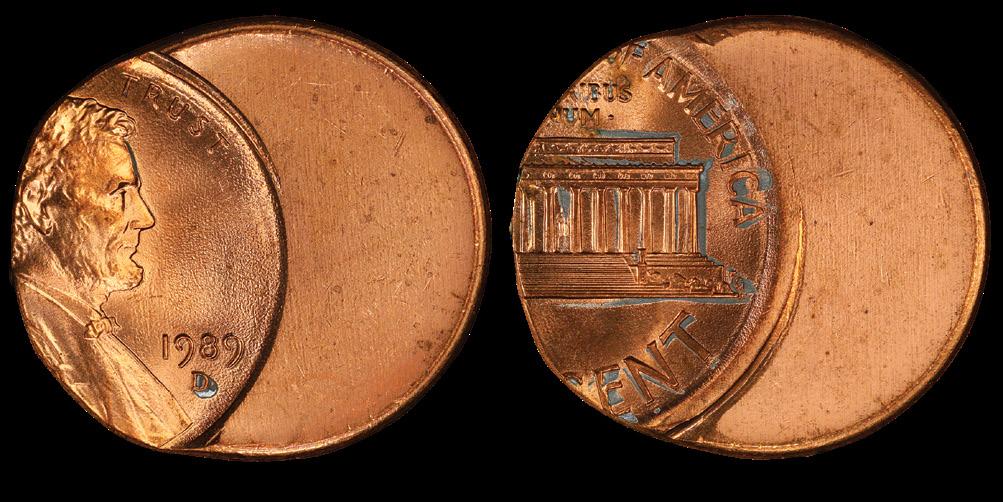
Off-center Lincoln Cents can be collected for prices usually ranging anywhere from $40 to $100.
Courtesy of PCGS TrueView.
For most U.S. coins, dated major off-centers struck since 2002 are rare and expensive. On the other hand, with the 19592001 era of Lincoln Cents most of the dates and mintmarks are relatively common. Still, acquiring such a collection can take a surprising amount of effort, namely, in locating examples in the desirable 25% to 75% off-center range, with coins bearing both a date and good eye appeal.
Building a quality, PCGS-graded set of off-center Lincoln Cents can be fun for a collector on a more modest budget. Most of the dates would be available for $40 to $100, with about 10 of the scarcest examples being in the $200 to $500 range. And finding every date and mintmark in nice condition is a challenge yet achievable.

Jon Sullivan is a dealer in mint error coins, with over 20 years of experience as a specialist in mint error coins under the company name Sullivan Numismatics and dealing primarily through the website www.sullivannumismatics. com. He also is the PCGS attributer and authenticator for mint error coins, providing authentication and attribution expertise.



away and left me her coin collection,” they explain. “I would occasionally go online and check out what was available or to try and help my aunt find a coin she was looking for.”
Speedysquirrel was initially attracted to China’s Silver Panda coinage based on their range of beautiful designs and relative affordability. “Then I discovered the Australian lunar coins and the Canadian wildlife coins. The fact that these coins were gold and in small weights made them affordable while at the same time adding the feeling of value and something to be treasured.” The designs were a natural fit for the former environmental education teacher, who says they are “passionate about nature and all the unique flora and fauna on this planet.”
Attending the Long Beach Expo helped give Speedysquirrel the motivation they needed to focus their collection on small gold coinage celebrating nature. “The diversity of my coin collection is due to the fact that so many countries around the world feature animals on their coinage,” they said, reeling off some of the countries represented in their PCGS Registry Set, including Australia, Canada, Congo, Palau, South Africa, Tokelau Island, and Ukraine. But the crux of the collection revolves around Chinese Pandas and Mongolian Tugriks.

“The Chinese Pandas were my first set that I focused on because the design on the coin changed every year, and they were the silver one-ounce coins. Now I am focusing on gold coins only, so this collection is in a transitional phase. The Mongolian Tugriks became a focus when I discovered websites where I could purchase them for a reasonable price.”
Among their favorite coins are the 2009 1/25 Crown Isle of Man Chinchilla Cat Crown and 2011 Mongolia 500 Tugrik Endangered Wildlife Ural Owl. But there are so many others they’re pursuing, including the 1/25 Crown 2012 Isle of Man Manx Cat. “It would be an awesome addition if I could find it and afford it!”
An enthusiastic collector, Speedysquirrel has found great reward in building sets on the PCGS Set Registry, which they joined in 2017. They have since earned Best of Registry and Gold Awards on the platform. “Pick a theme that excites you,” they tell collectors who wish to be successful on the PCGS Set Registry. “Research your potential set,” Speedysquirrel added. “Doing your homework is part of the fun and can send you on an unexpected treasure hunt.” And they advise against overstretching yourself financially. “I set an annual budget and stick to it. Patience can be rewarding.”

Joshua McMorrow-Hernandez has won multiple awards from the NLG and ANA for his work as a numismatic journalist and editor. He has been a coin collector since 1992 and enjoys all areas of United States coinage and U.S. minting history.
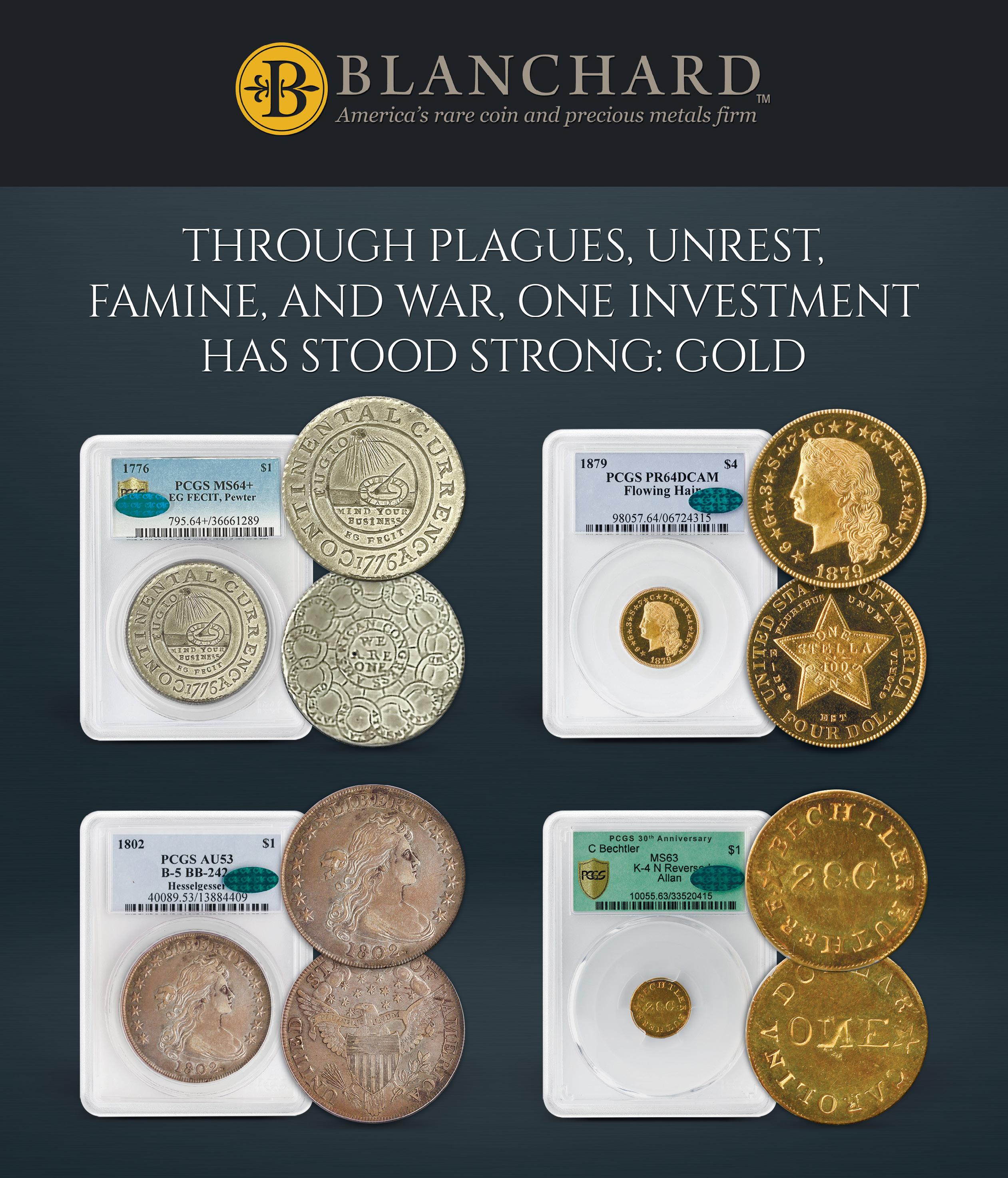

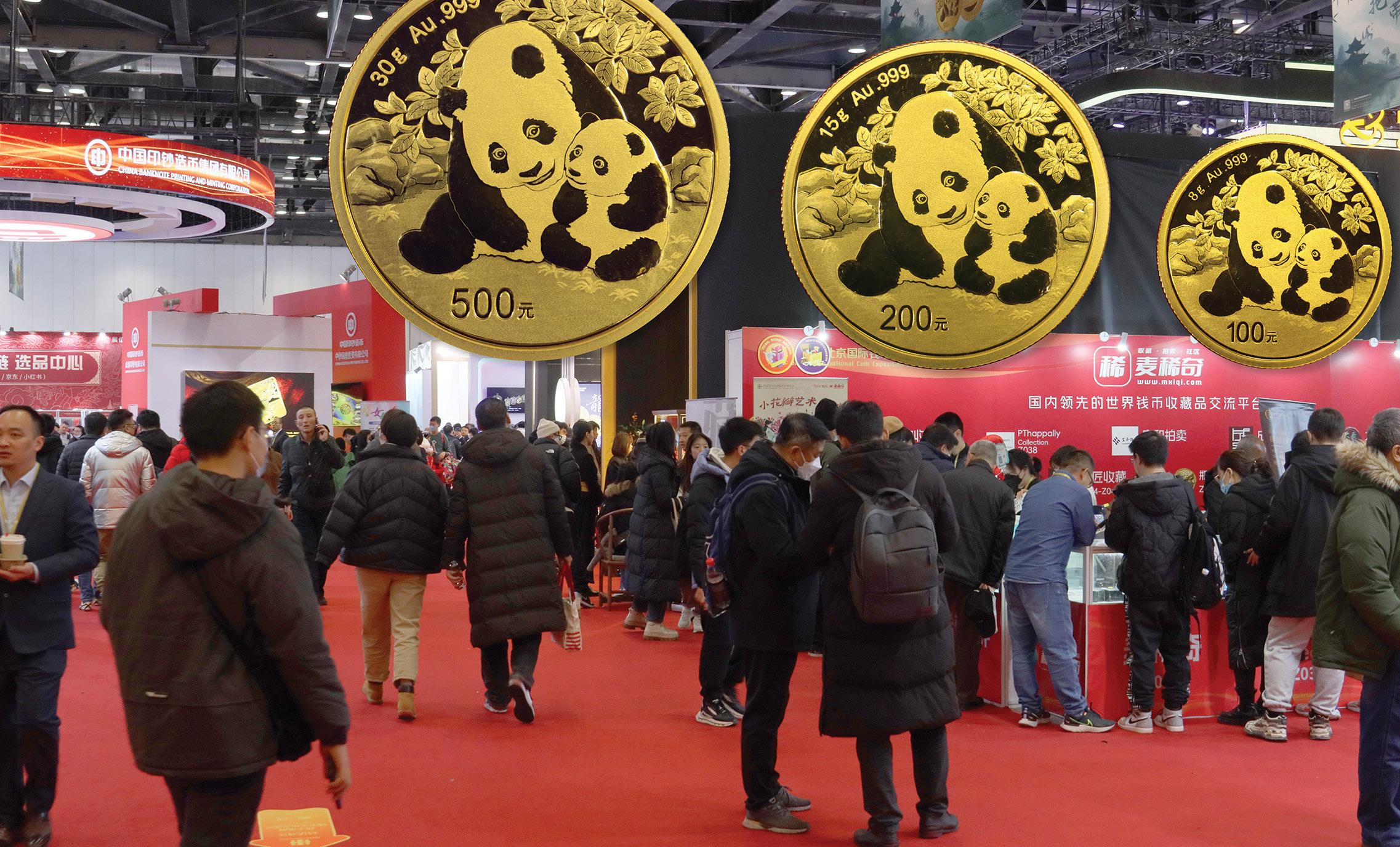
In unison, six dancers precisely turn a quarter circle. Then, one by one, the women slowly rotate back as their left arms sweep upward toward the high ceiling of the China National Convention Center. Their blue, green, and ochre-colored costumes swirl through the air. Behind the performers, a large screen displays images of mountains and valleys, painted in colors that match not only the costumes, but also the artwork on the four coins in the new 2024 Famous Ancient Chinese Painting series. The crowd grows larger and larger, a hundred phones held high to record the event. Above the din rises a traditional Chinese melody plucked on a zither.
“Are you going to the Panda Launch?” a friend yells to me from three feet away. The launch will mark the official release of the 2024 Panda coins.
“Do I need a ticket?”
“No, just be there.”
It is December 1, 2023, and we are standing on the floor of the 2023 Beijing International Coin Expo. This is the first in-person BICE since 2019. The building is filled with people excited by coins, banknotes, and the like. They hurry in past the showrooms hosted by institutions like China Minsheng Bank and the Agricultural Bank of China. These offer gold and silver bars, medallions, and cultural items like teapots for sale. Panda coins are a popular choice among gold buyers. These luxury bank “booths” are practically flats, large enough for clients to sit inside, drink tea and watch fairgoers stream by.
Down every aisle there are display areas for all types of numismatic-related companies that make coin and currency boxes and albums or that sell jewelry and precious metal objects of all sorts. One piece that catches my eye is a silver abacus pin that also holds a three-gram gold Panda coin. This is the work of Miss Tong Fang, the designer of the 2023 Panda coin, as well as many other Chinese coins. It is my pick as the prettiest gift of the show. Further on, a long line forms at the PCGS area, where people wait to play a coin-grading game in which a handsome, large canvas tote bag is the prize.
A short distance to the left of the dance stage, China Gold Coin displays a rare 1991 five-kilogram gold Panda coin along with other modern rarities. (Note: this particular coin puzzles me. There is supposed to be a serial number from 1-10 stamped on the rim. On this example, a steel band wrapped around the edge makes it impossible to see the rim. One coin was retained at the Shenyang Mint, where the mintage was struck. Is this that coin or a sample? When asked, the workers at the booth don’t know. Just across the walkway from the China Gold Coin exhibit, a spectacular complete collection of five-ounce Panda gold coins is on display. It is presented by the Yong Yin Coin Museum in Nanjing, a spot that belongs on every numismatic tourist’s itinerary.
Among the most popular attractions are the government mints like the Shenyang, Shanghai, and Shenzhen Guobao Mints. Mints that are less well known outside the country, like the Chengdu Mint and Zhongchao Guanghua Mint, also
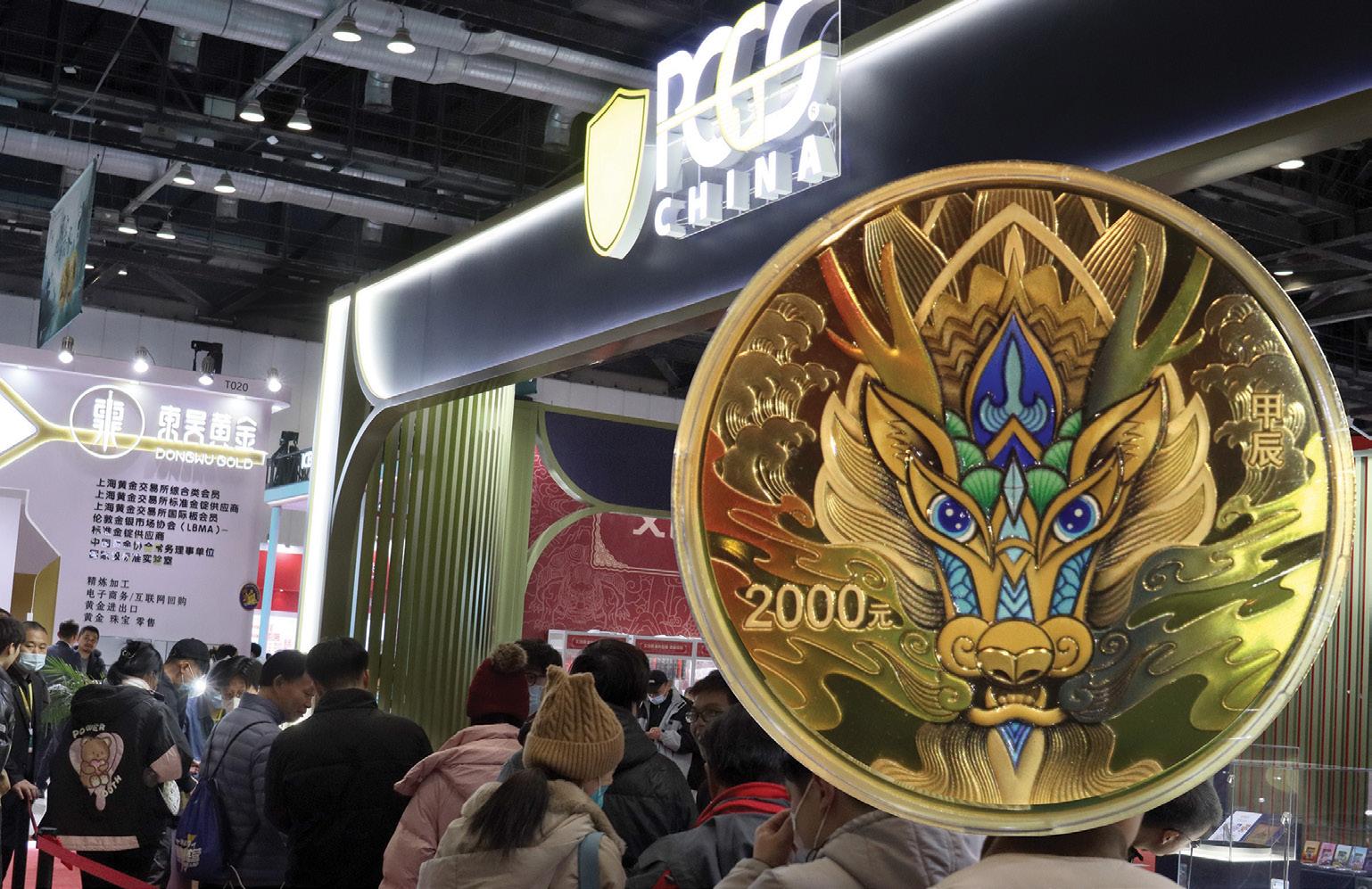
are busy. Foreign mints are popular, especially the Perth Mint and the French mint, Monnaie de Paris (which served hors d’oeuvres at lunch time the first day of the show). Foreign dealers like MDM from Germany and Panda America also get attention. Neil Vance of the Perth Mint receives an award from the show for his many years of contributing to the growth of Chinese Numismatics. Afterward, he tells me that the Perth Mint has always greatly valued its relationship with China and that he wouldn’t miss this show. Indeed, the Perth Mint struck platinum coins for China back in the 1990s.
The Panda Launch is held at the Intercontinental Hotel that is across the street from BICE but connected by a bridge. I hurry across it and arrive just in time to catch the start of the ceremony. Miss Huang Qin, the coin designer of the 2024 Panda coins, presents a detailed discussion of the history of the Panda series and the design process for the newest coins. Following her, half a dozen designers and engravers of previous coins are called on stage to receive awards.
One very special aspect of BICE is the opportunity it affords to meet the people who shape China’s numismatic program. For instance, at the Shanghai Mint booth, Mr. Luo Yonhgui — the designer of more than 100 Chinese coins — explains the technical processes of coin minting and design to a group of rapt collectors huddled around him. Most of the top coin designers in China make appearances — Mr. Zhu Xhihua, Ms. Tong Fang, Ms. Chang Huan, Mr. Liao Bo, Ms. Huang Qin, and many others — as well as top mint executives.
BICE, though, is much more than a numismatic trading venue. It has become an educational and cultural event in its own right. This places it among the world’s elite coin shows like the World Money Fair (held each winter in Berlin) and the American Numismatic Association’s World’s Fair of Money (United States). The basic trading show format was established centuries ago: it lasts for a limited number of days, exhibitors and visitors travel to reach it, and there is active trading. One medieval trade fair was described like this, “By river, by road, afoot through the forest traders of all kind began to make their way to (the town)… Once a year, they came to buy the fine wines, the luxury cloths, the gold and silver work — all the treasures that appeared for the fair and vanished three days later.”
Temporary festivals were a novelty in Medieval Europe. Unlike permanent markets, or bazaars, which existed since ancient times, trade fairs were short, intense, and reached an audience outside major cities. An important side effect was that they allowed common people to earn cash. That sparked economic growth and development that was stifled under the feudal system. The roving merchants further undermined feudalism with their support for strong central governments that made travel safer. The first recorded trade fair was held in Frankfurt, Germany, in 1150 A.D. There is no record of any coin traders there (although who can say?), but it was the distant ancestor of all coin shows.
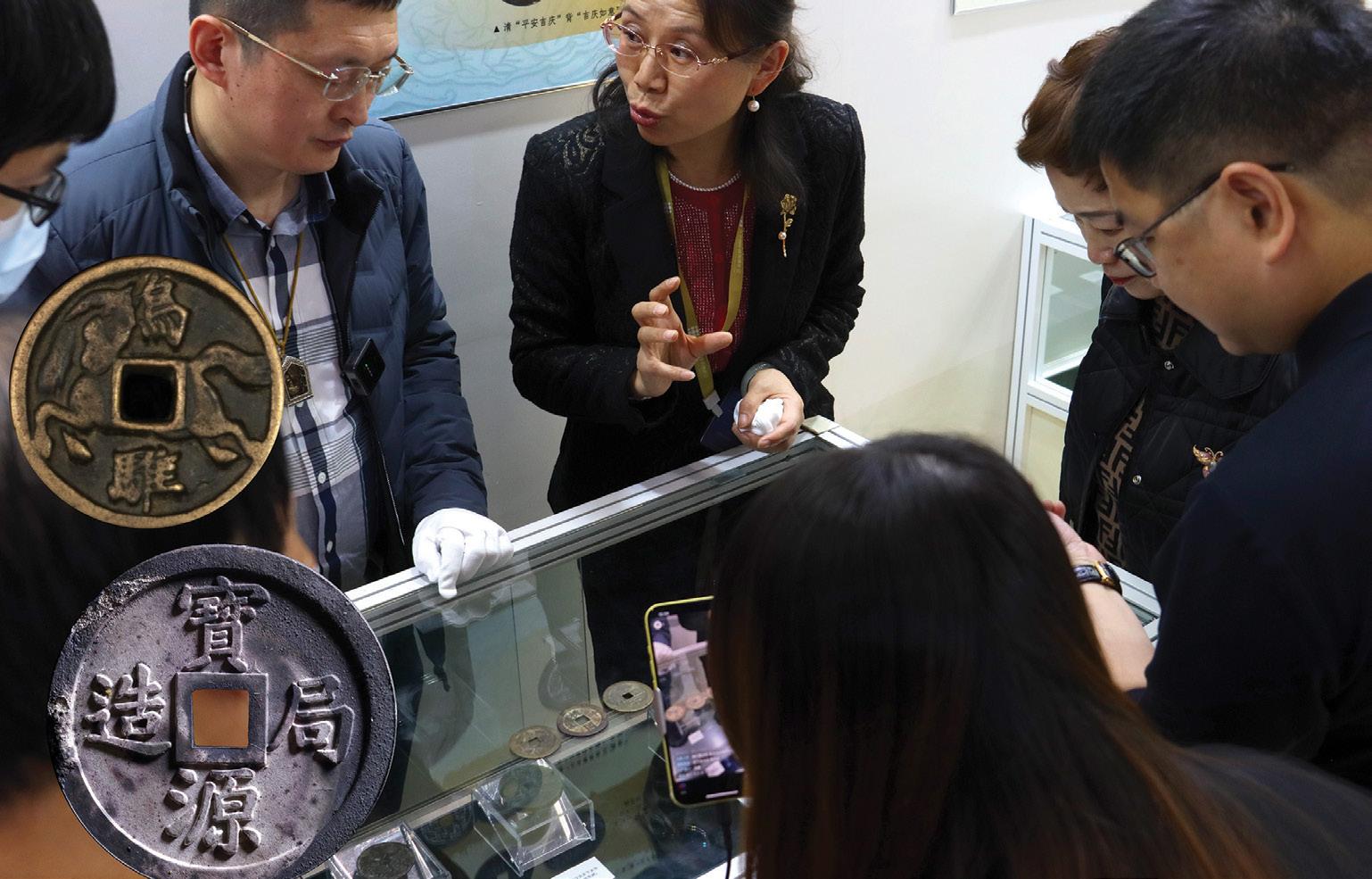
The first Beijing International Coin Expo was held in 1995 and is partly remembered today for its scarce one-ounce silver Panda commemorative coin, of which 18,000 were minted. During its early years, the excitement about the new show was extreme, the atmosphere filled with speculation and feverish trading. The show opened at a time when Chinese coins were rising in prominence internationally and drawing ever more interest at home.
In 2023, while there are many booths along the sides and back of BICE for the retail coin business — and China Gold Coin, itself, has a large retail sales area — a significant part of today’s expo is devoted to information.
One excellent example of this is the exhibit of the China Numismatic Museum. This year it features charms and amulets, not coins, through the country’s history. I stopped by there and met Mr. Lu Xin, who goes by the name Bob and curated the exhibit. As I looked down at one showcase, he explained, “These date from the Han Dynasty, more than 2,000 years ago. Unlike modern lucky charms, in those days most of these were meant to protect against bad luck, not bring good luck. That is what was on people’s minds.”
I look down at a thousand-year-old Song Dynasty (9601227) piece. It resembles a cash coin with a round hole in the center. Instead of being money, though, with the emperor’s mark on it, the characters form a prayer to eliminate disasters. Another charm from the Liao Dynasty in northern China wishes longevity to its bearer.
Charm designs evolved as Chinese art did. Poetry was the starting point, and some charms even have a poem on one side. Then, as art expanded from poetry and calligraphy to painting, charms became more visually creative, too.
My conversation with Mr. Lu is interrupted by the arrival of two outstanding coin designers who drop in to say hello: Mr. Luo Yong Hui and Miss Jin Yan Xuan of the Shenyang Mint. As everyone talks, several employees of the museum bring out uncut sheets of new souvenir banknotes for us to admire. The subject of the notes is a dragon. Its colors under room light are shades of maroon red and lemon yellow. When an ultraviolet light shines on the note the shape of the dragon instantly glows a stunning golden-yellow.
Coincidentally, a placard posted on the wall relates to the note. “The year 2024 is the Year of the Dragon. The dragon is the only animal in the Chinese calendar with a divine nature. It is both a cultural emblem and the spiritual symbol of the Chinese nation. It bears witness to the formation of the Chinese nation and serves as a bond of affection for the Chinese people… In many artistic works we can see various shapes of the dragon.”
Right below the sign two charms illustrate this, as both are decorated with double dragon designs. One is from the Qing Dynasty and another, well worn, is from the older Five Dynasties (907 to 979 A.D.) era. This was a time of political upheaval and strife when people needed all the good luck they could find. Incidentally, collecting these non-monetary numismatic relics is growing in China.


silver had a listed mintage of 2,800, the 10 yuan tenth-ounce gold is listed at 60,000 and the 10 yuan one-ounce silver piece had a planned mintage of 100,000.
Late in the day as I leave, a clang-clang-clang sound of metal-on-metal rouses my curiosity. Its source turns out to be the Shanghai Mint exhibit. A man wields a sledgehammer to hand strike souvenir medals for BICE. I chuckle that this antique Western method, in use at the time of the first trade fairs, is being used to turn out keepsakes for a Chinese coin exposition in the 21st century. Then again, it reflects how culture and knowledge spread and of the long history of trade fairs and shows like the Beijing International Coin Expo – and of coin collecting – itself.
Although not in this exhibit, the charms call to mind a set of four “Vault Protector” coins struck in 1998. These coins have a round form with a center hole like cash coins but sport a fantasy design that references the Tang Dynasty. In this set is a 2,000 yuan coin that contains one kilogram of pure .999 gold. Apparently 72 were struck, although the planned mintage was 68. The actual mintages of the other three coins are not definitely known, but the 200 yuan one-kilogram

Peter Anthony is a PCGS consultant on modern Chinese coins and is the author of The Gold and Silver Panda Coin Buyer's Guide 3, a two-time Numismatic Literary Guild winner. He is also the publisher of China Pricepedia , a monthly journal and price guide for modern Chinese coinage.

1882
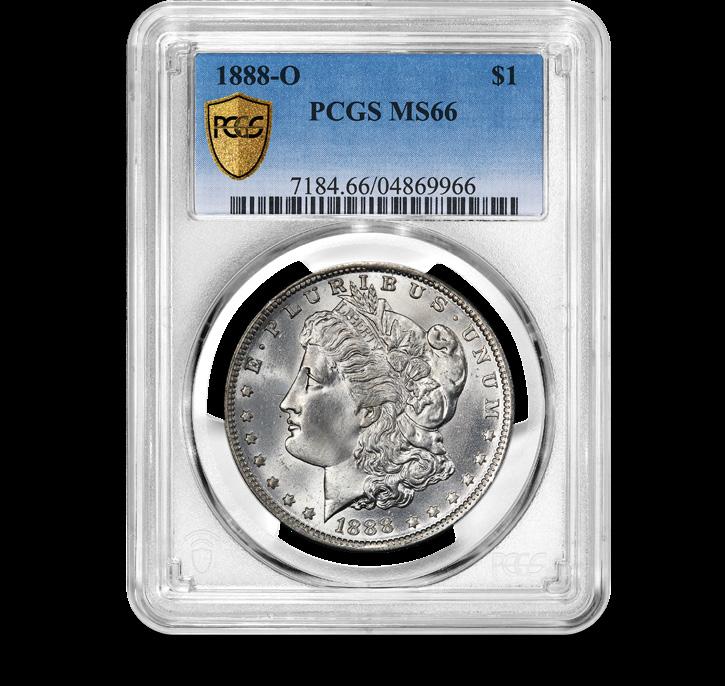

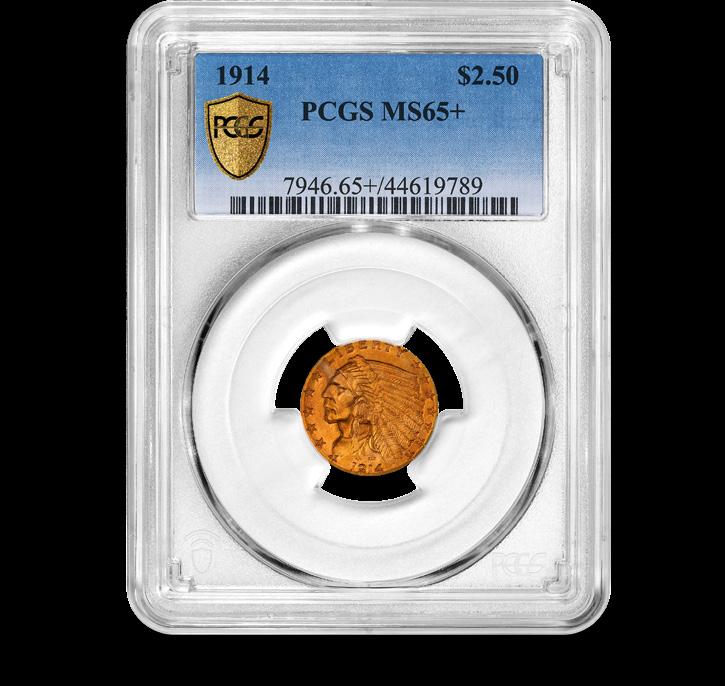
Dealers: If you're interested in selling your inventory on Collectors Corner,
We look forward to hearing from you soon!

Sophie Welch is a South East England young numismatist who is building her career around coins. Courtesy of Sophie Welch.
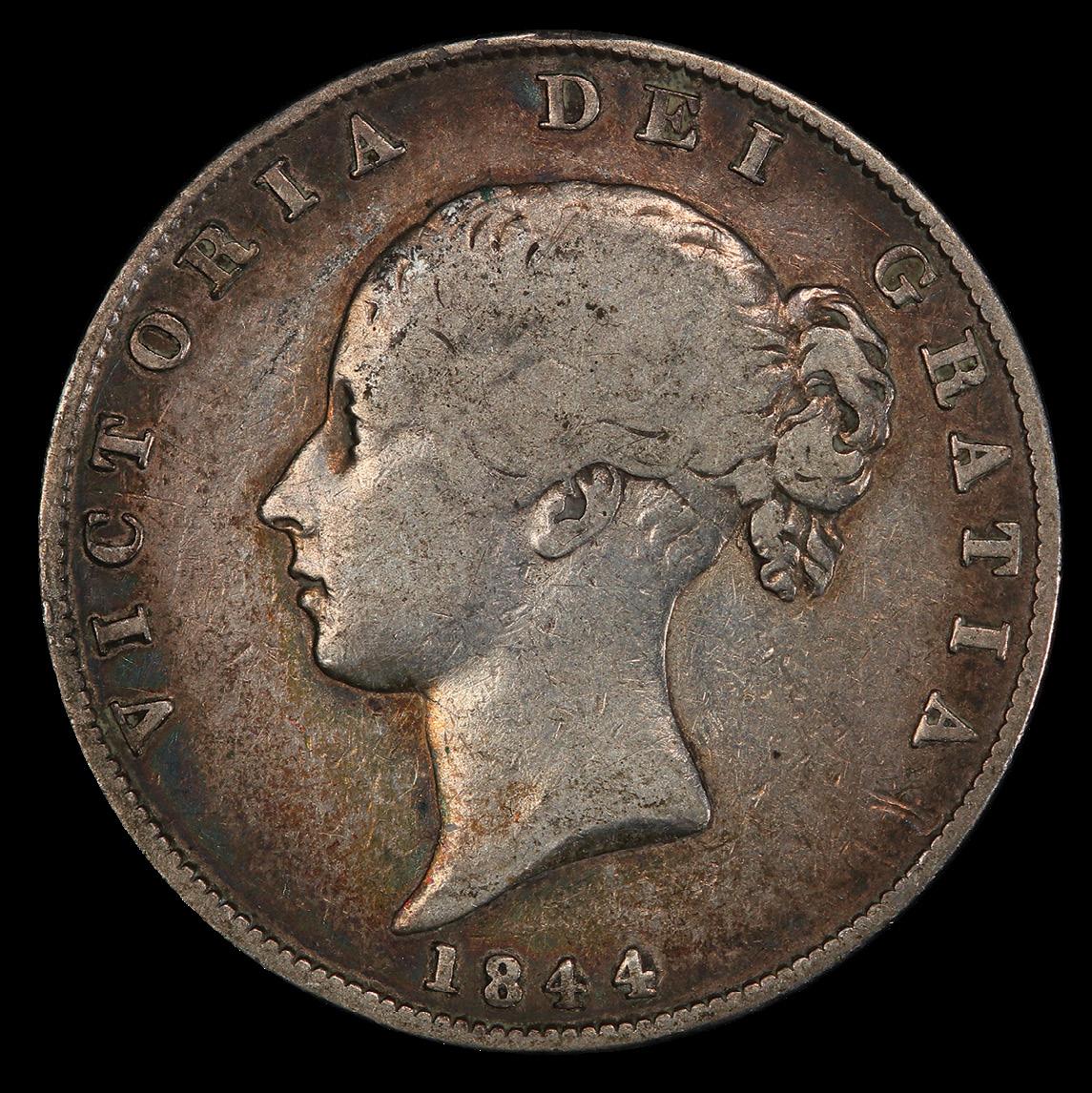

My name is Sophie Welch, and I'm a 20-year-old numismatist from South East England. I've been collecting coins since around 2015. My interest originated through different influences while growing up, such as getting a pressed penny at a theme park or finding a foreign coin in my change.
As many young British coin collectors begin their numismatic journey, I was always on the lookout for a commemorative 50 pence or £2 coin. My collection quickly
skyrocketed to what it is today, consisting of 1,500+ coins, banknotes, and medals from all over the world. My favourite coins are errors and anything unique that's coin related. It's difficult to say which are my absolute favourites, but among the ones I currently own, I'd say they're a 2008 British two pence struck on a one penny planchet, and the Van Gogh Starry Night 2022 10 Cedis from Ghana with the painting recreated in a stained-glass effect.
I've been working full time at the Heritage Auctions office in London since October 2022. As the London office is very small compared to most of the others, what I do varies a lot from day to day. I can be the go-to person onsite for coins, but I also handle comics, movie posters, video games, and many other items every day. I deal with the ins and outs of most elements associated with the whole auction process from both a consignor's and buyer's perspective. I also catalogue modern world coins, which resulted in me visiting the Dallas headquarters to spend concentrated time cataloguing coins in person and meeting the people I'd previously only communicated with virtually. I really enjoy being able to do a variety of tasks, and I think it's good to not have your fulltime job be identical to what you do as a hobby, as that could take the enjoyment out of it.
Having a job like this has also boosted my confidence
the people I'm speaking with are coming to me for guidance and assistance, so I no longer feel intimidated in these sorts of scenarios.
Another type of coin I really like is coinage featuring designs of other coins, such as the 2021 Decimal Day 50 Pence. I'm gathering many similar coins that are like this. However, they're difficult to look for as there's no specific term for such coins. So I coined my own word: idenumia. I wanted the word to be memorable and make sense for what it means whilst referencing the definition. The full definition is, “Coins, paper money, or exonumia of which the obverse and/or reverse design features an identical design from another coin, piece of paper money or exonumia of a different denomination.” My hope is that over time, people will begin using this word to define such items, making it easier to find and collect idenumia currency. I mean, coins with the image





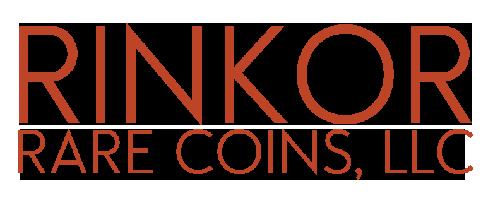







APMEX boasts a wide range of new precious metals products from around the world. We offer rare numismatics, graded and certified products, and unique modern collectibles. Our inventory is frequently updated with ancient, vintage, and modern products so APMEX is bound to have what you are looking for!
Be sure to check out our newly listed rare coins and collectibles: APMEX.me/newrare or call (800) 375-9006

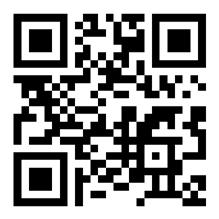




There’s no doubt that some amazing coins came to light in 2023, and we can only imagine what coins will make appearances as we continue tracking through 2024. There are way too many highlights to mention, with about a dozen or so coins realizing over a million dollars each at auction in 2023.
Let’s highlight just a few of the notable pieces that were recently sold at auction.
Shockingly, this circulation-strike coin has a reported mintage of 100. Yes, you read that correctly – not 1,000, not 10,000 or more, but 100. Today, no more than seven examples are believed to exist, and two of those are in the National Numismatic Collection at the Smithsonian Institution, leaving only four or five specimens out there in collectors’ hands. Owning an example in any condition is a great privilege, and needless to say this issue seldom appears in the market. PCGS CoinFacts auction archives show only four ever selling at public auction. So, any time an example shows up at auction or anywhere in the marketplace, it is a special treat for the numismatic industry. On August 10, 2023, Heritage Auctions sold a PCGS AU53 example that fetched an amazing $1,980,000.
This is one extremely cool coin... It is a 1974-S Lincoln Cent Struck on a Nepalese Aluminum Cent. As many folks know, the United States Mint produced experimental aluminum 1974 Lincoln Cents that were later destroyed by the U.S. government. Some examples escaped and have been
confiscated because the government deems them illegal to own. However, the 1974-S Lincoln Cent struck in aluminum is legal to own given it’s not one of “the” 1974 aluminum cents but rather an error struck on a foreign coin planchet. The 1974S Lincoln Cent struck on a Nepalese aluminum planchet is currently known to be unique, as there are no others struck exactly like this example. Regardless, any legally obtainable 1974 Lincoln Cent struck in aluminum is considered rare. In January 2023, GreatCollections sold the 1974-S Lincoln Cent struck on a Nepalese planchet and graded PCGS PR68CAM for $199,687.
This $1,000 1880 Legal Tender Banknote with the Fr-187k variation and with the two signatures of Treasury officials William Tecumseh Vernon and Charles Henry Treat is rare. Experts estimate that only about five examples exist. Of these, one is housed at the Smithsonian Institution and another is held at the Federal Reserve Bank of New York. With so few examples available to the public, this treasure is rarely seen in the marketplace. When one does appear, it definitely stirs excitement. Collectors were buzzing on August 15, 2023, when Stack’s Bowers Galleries offered a PCGS VF25 example that hammered for $252,000.
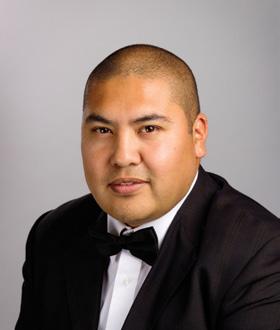
Jaime Hernandez is an editor for the PCGS Price Guide and has been a proud member of the PCGS team since 2005. By the time he reached his early 20s, Jaime was successfully buying and selling coins with some of the most prominent dealers and collectors in the country. Email: jhernandez@collectors.com
1950 Lincoln Wheat Cent 4% Straight Clip at 10 o’clock. The clip is from the blank being punched from a planchet strip’s edge. Courtesy of PCGS TrueView.



defective area in the central area of the planchet strip, or if the blank is punched from one of the four sides of the strip that was not trimmed properly and has a “ragged” edge to it.
edge area. The missing metal makes the coin look like it has been “clipped” of some of its metal.
Blanks are the round disc of metal that will eventually be turned into a struck coin. These blanks are made when a roll or section of planchet strip is fed into a blanking press. The press has round, cylinder-shaped punches, which move up and down as the strip is fed into the press. With each downward stroke, blanks are “punched out” of the blanched strip. When all goes according to plan, the blanks will be perfectly round, and the shape of a normal blank for the respective denomination of coin.
However, if the planchet strip is fed into the press improperly, or if a press operator is not paying attention, a clip can occur. A curved clip can occur when the blanking dies can overlap previously punched-out holes in the strip, resulting in clips.
Sometimes, the punches can overlap either the “front,” “sides,” or “end” of the planchet strip, resulting in a “straight clip.” Straight clips have smooth, straight clips on them. Another clip type is the ragged clip, which comes from a blank being punched out so that it has a “ragged” edge in the clip area. This can occur when a blank is punched out from a
Although there are other kinds of clipped planchets, these three types – the curved, straight, and ragged clip – make up perhaps 99% of all clipped coins in existence. Some of the other clip types are actually just some version of these three clip types (and are effectively a “sub category” of these three types). Examples include crescent clips, which are just curved clips missing 60% or more of their planchet. Bowtie clips, which are coins with two or more large curved clips, are close together and opposite each other, and they make the clipped planchet visually resemble a “bowtie.”
Another clip type, which will have no metal “missing” on it, is the incomplete clip. This clip type occurs when the blanking die fails to fully punch out a blank, and then when the strip is moved forward to punch fresh blanks, it is not advanced far enough, and the blanking dies overlap the previously partially punched-out areas in the strip. This results in a blank with a curved line across its obverse and reverse (the line being where the first blanking die punch failed to punch out the blank). Incomplete clips are scarce, but they are not rare except within certain coin series (namely those from larger-denomination coins.) Cents and nickels are the most common coins to have incomplete clips. Some coins will even have two or three incomplete clips, or an incomplete clip in combination with another clip type.
A few other clip types exist, but most of them are rare. The outside corner clip, for example, is exceedingly rare and occurs when a blanking die overlaps one of the four corners of
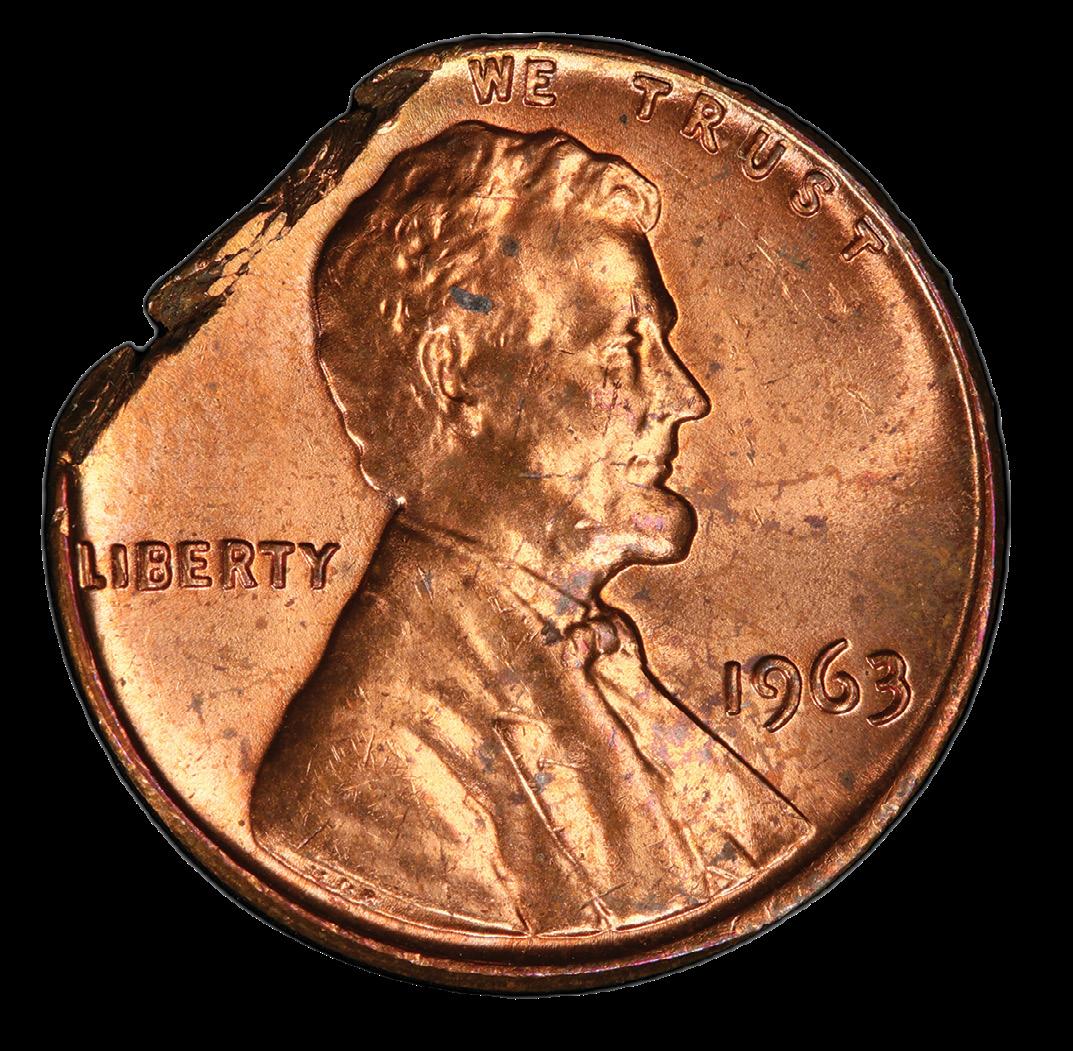

a roll of planchet strip, resulting in a “right angle”-shaped clip. The rarest type of clip is the inside-corner clip (also known as the “assay clip”), which occurs when a piece of planchet is “snipped” from the roll of planchet material. If a blank is punched out of that area, there will be a “snipped” area of planchet missing from it. Very few are known.
Clipped planchets can be collected by date and mintmark for a particular coin series, such as Lincoln Memorial Cents or Jefferson Nickels, or they can be collected as a type set, with a collector acquiring an example of every clip type.
Find examples which have clips that are large enough to be easily seen. In terms of grade, search for circulated or uncirculated coins that look nice – the same as you would with “non-mint error” coins. Clips that are in Mint State grades and boasting good eye-appeal with an easily visible clip are popular. A PCGS-graded example will be far easier to build into a set since the holder’s label will contain important information about the coin. And as an added bonus, a PCGSgraded example will be easier than a raw piece to sell down the line.
Most clipped planchets are worth more the larger and more visible they are, and also the higher the grade of the coin. A 75% clipped planchet Washington Quarter will be worth

clip type. Courtesy of PCGS TrueView.
perhaps $200, versus a 5% clip on that same Washington Quarter garnering maybe $5. Lustrous, Mint State clipped coins will always be more desirable over low-grade circulated coins.
Pick a series, clip size, and grade that fits your budget, then have fun building your clip collection!

Jon Sullivan is a dealer in mint error coins, with over 20 years of experience as a specialist in mint error coins under the company name Sullivan Numismatics and dealing primarily through the website www.sullivannumismatics.com. He also is the PCGS attributer and authenticator for mint error coins, providing authentication and attribution expertise.






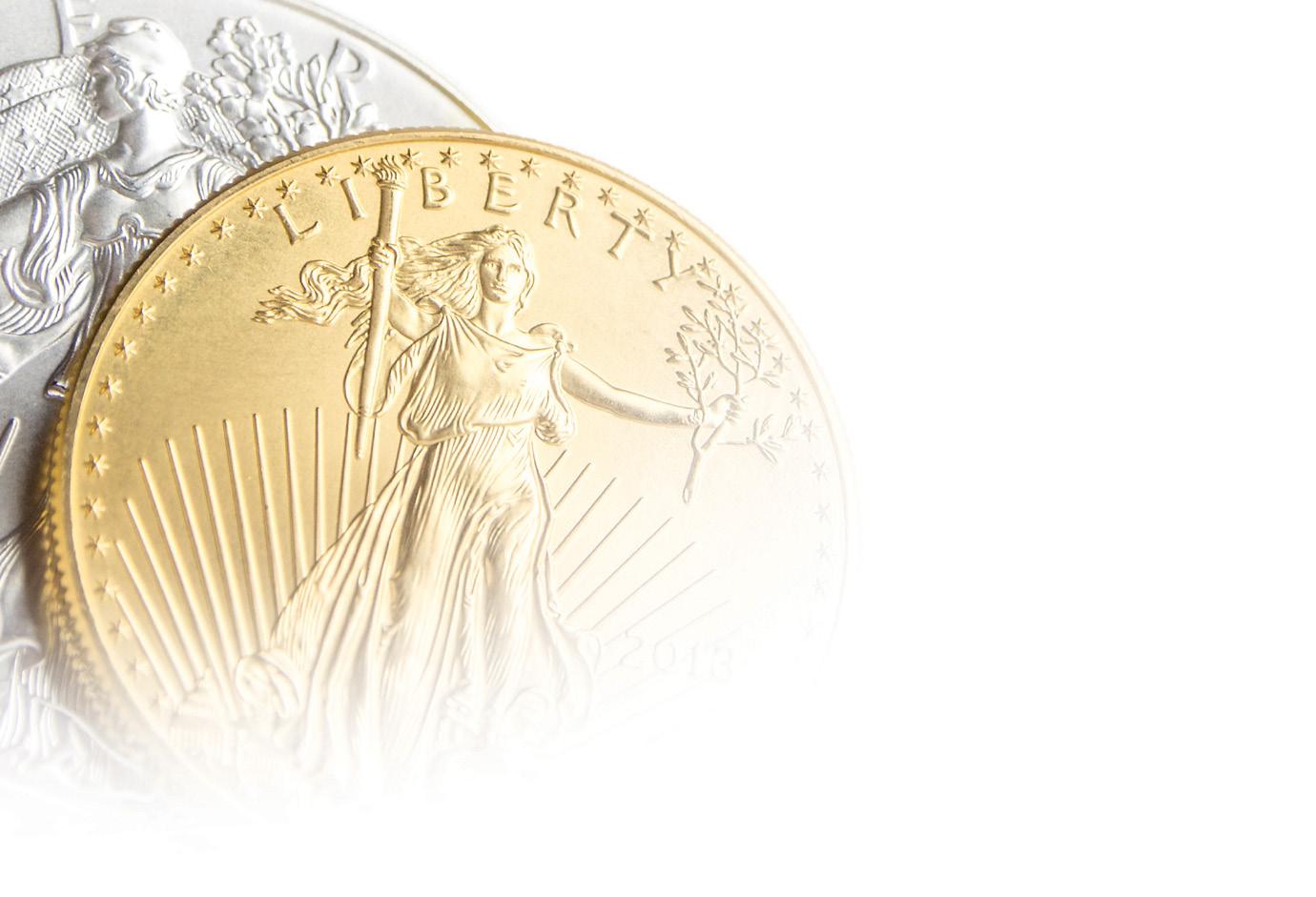




The Saint-Gaudens Double Eagle, a gold coin with a denomination of $20 and named after designer Augustus Saint-Gaudens, is considered by many to be one of the most beautiful and iconic United States coins. The series, which continues to be very popular and heavily collected, is tough to complete because of the number of rare-date examples commanding a substantial price.
One of the most difficult to acquire is the 1930-S. For the year 1930, only the San Francisco Mint produced double eagle coinage, and with a mintage of 74,000 coins it’s one of the lower-mintage circulation issues. However, with gold coinage, mintage is only part of the story. Surviving coins are a more significant aspect toward rarity and demand, and for the Saint-Gaudens series, the 1930-S stands out as a rarity dwarfed only by the higher-mintage 1927-D that boasts a far lower number of survivors. The legendary 1933 is a rarer coin than both, but it’s not considered collectable due to the legal issues surrounding private ownership of the coin and its absolute rarity.
Just under 1,173,000 Saint-Gaudens Double Eagles have been encapsulated by PCGS during the company’s nearly 40year history. This figure includes the only legally obtainable 1933 “Saint.” There are several other dates that have fewer than 100 examples graded by PCGS. These dates are the 1931-D with 97 examples, 1931 with 85 examples, 1932 with 83 examples, 1930-S with 53 examples, and 1927-D with just
the grading room.
The recently submitted 1930-S Double Eagle profiled here is among the top 20 examples graded by PCGS. It is tied with only eight other examples in MS65, with two in MS65+, six grading MS66, and just three in MS66+. With the 1930-S still considered a sleeper for the series, valuation range can be dramatic. The PCGS Price Guide currently values a PCGS MS65 example of the 1930-S at $360,000. The last sales record for a PCGS-graded MS65 was recorded in a May 2023 Heritage Auctions sale, where the coin sold for $288,000.
With more than a million Saint-Gaudens Double Eagles graded by PCGS, locating a date with fewer than 53 examples graded and notching a top 20 showing is of significance. It makes one wonder what more is still waiting to be discovered around the world.

Jay began collecting coins at the age of 13, when he inherited his uncle’s coin collection. Turner is proficient in U.S. and world coins, token and medal variety attribution, grading, and counterfeit detection. In 2017, Turner joined PCGS as a grader specializing in world coins. He is stationed at the PCGS U.S. headquarters and grades onsite for the Shanghai, Hong Kong, and Paris offices.





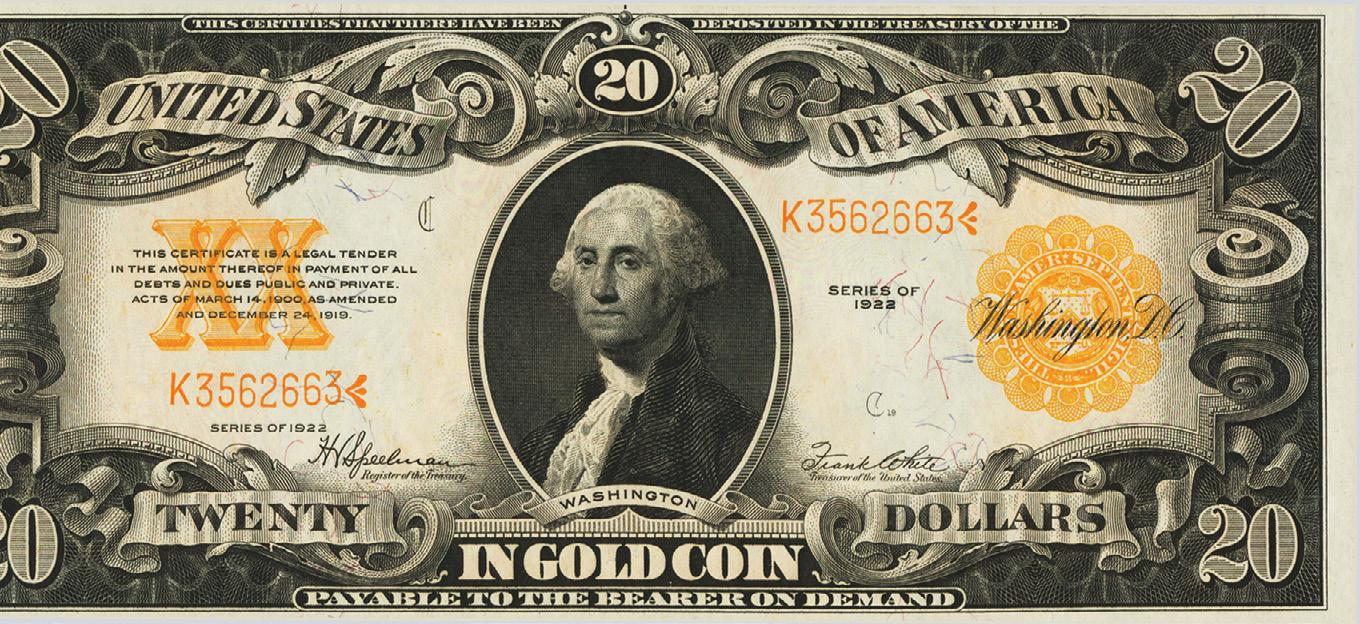
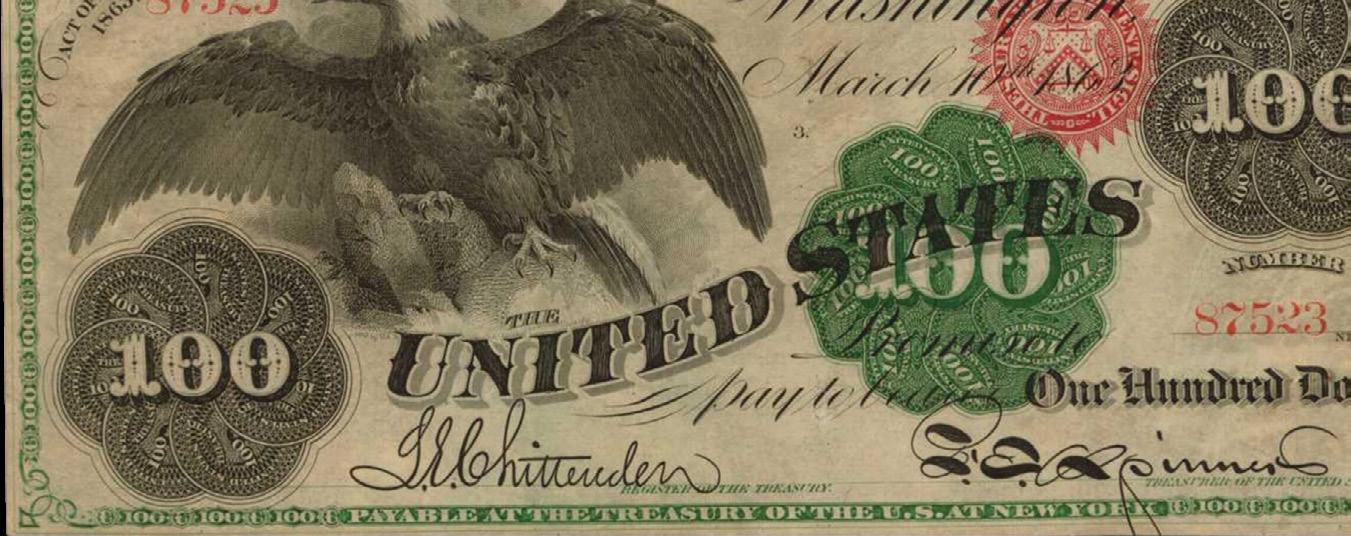

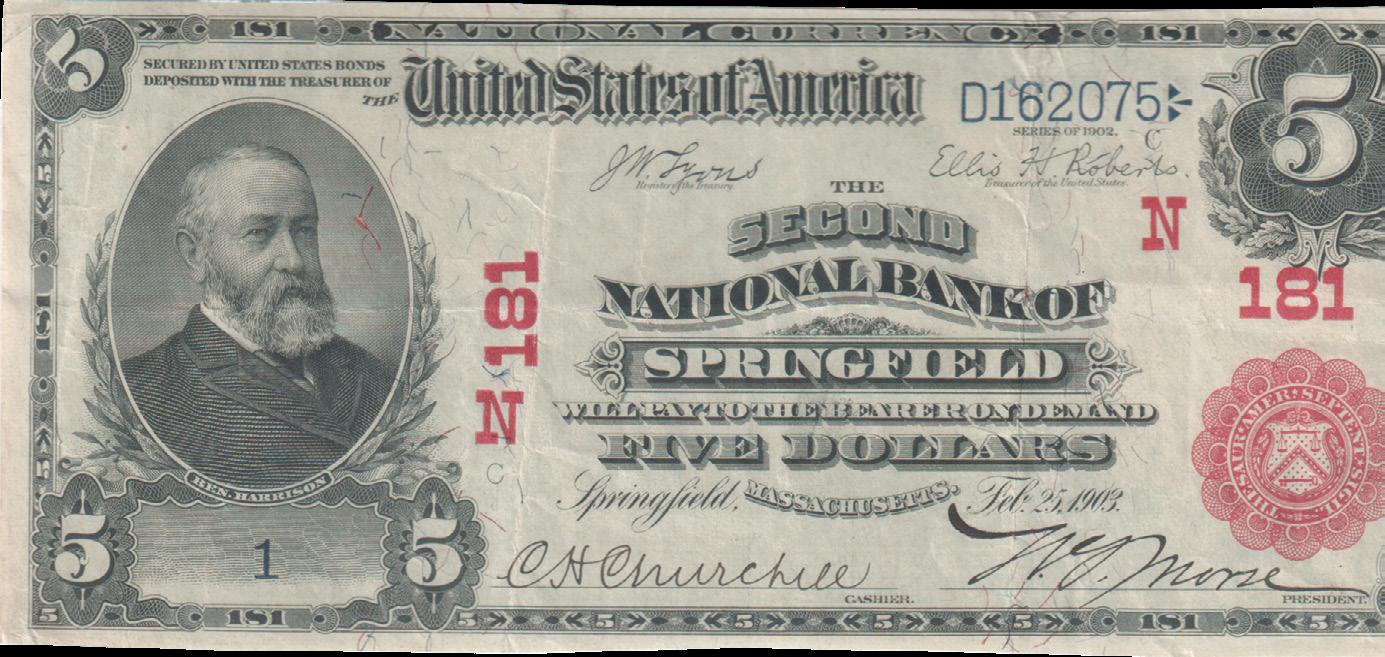
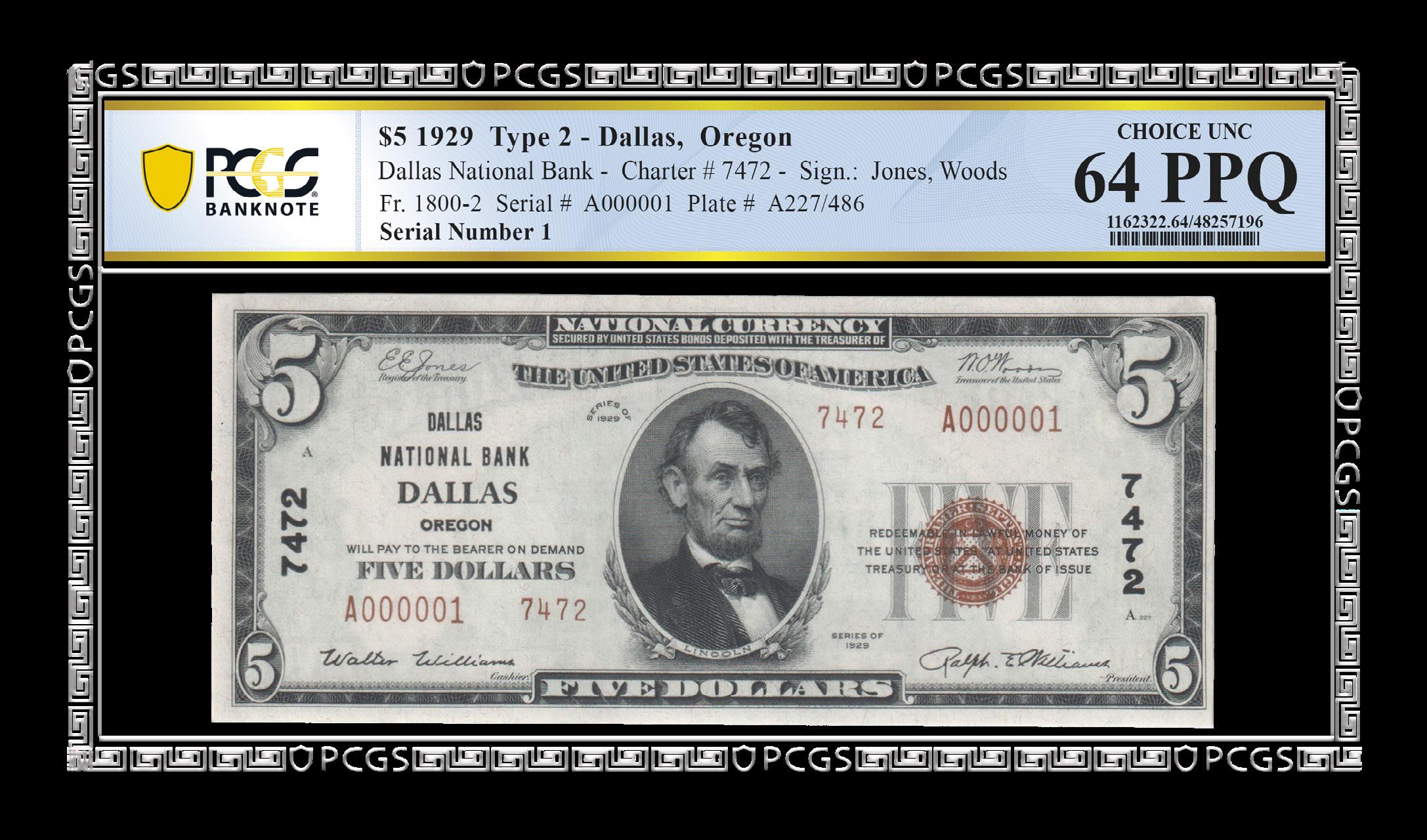

Because of the steady flow of astounding banknote submissions received from our loyal, valued collector and dealer base, every day in the PCGS Banknote grading room possesses the potential to surprise and delight. That is just one of the employment benefits enjoyed by our banknote staff, composed of team members who are truly enthusiastic about and grateful for the cherished numismatic collectibles with which they are entrusted to handle daily.
The day that the subject of this issue’s Noteworthy Notes column reached the grading stations was a particularly gratifying one for the team. This 1929 $5 Type 2 National Bank Note from Dallas National Bank with serial number 1 –certified and graded as Choice Uncirculated 64PPQ (Premium Paper Quality) – certainly surprised and delighted.
Assessing a National Bank Note’s desirability, as well as determining its estimated value ahead of an actual freemarket transaction (which always has the ultimate say) can be a challenging, inexact science involving multiple factors of nebulous exactitude. The issuing bank’s location (both town and state), scarcity, type and variety, other prestige-elevating factors such as a low serial number or printer error status, and finally condition all combine to form its appeal profile. This specific National Bank Note ranks pretty highly among all of these considerations.
Let’s start with the matter of geography. Very generally, the more obscure the town, the scarcer a banknote is expected to be, although banknotes from larger, more prominent cities (but from smaller banks within them) can be scarce as well. And while scarcity doesn’t always translate directly into value, as certain geographies are simply more popular and heavily collected than others, it can be a solid initial indicator of a precious banknote. At first glance, this banknote’s issuing financial institution appears to have been in one of the nation’s largest and best-known major metropolises – the “Big D,” otherwise known as Dallas, Texas. But a careful reading of the fine print of the note at center left will quickly reveal otherwise: this is Dallas, Oregon – not Dallas, Texas!
The state of Oregon is considered to be a “better” state for Nationals, being in the latter half of the 1800s U.S. westward expansion endeavors and maintaining a population of under one million throughout the National Bank Note era. Compared to the geriatric Pennsylvania, for example, the nascent Oregon hardly had the population, infrastructure, and investment support to justify larger print runs of circulating banknotes. Dallas was located 15 miles west of Salem, occupying fewer than five square miles in footprint and maintaining less than a 3,000-person population when this banknote was printed. So, it required just a tiny fraction of the statewide totals.
This isn’t just any Dallas, Oregon, National either. Out of the 474 Type 2 $5 notes printed, this was the very first, demonstrated by the brown ink overprinted serial numbers at lower left and upper right, which proudly exhibit “A000001” as the prima facie evidence. Additionally, the Type 2 variety – identifiable by the busier overprint configuration of serial plus charter number in tandem at both ends – adds another dimension of desirability. Unlike Type 1 Nationals that can have up to six serial number 1s available to collectors (all six subjects on firstly printed sheets of Type 1s sport the number 1, differentiated only by their letter prefixes A through F), the Type 2 variety saw only one serial number 1 on that premier sheet, with its sheet mates getting the less-impressive numbers 2 through 6. According to the current National Currency Foundation census statistics, the ratio of available Type 1 to Type 2 serial number 1s is – unsurprisingly – around 5:1 (5,344 to 1,089), just about the proportion that we would expect based on said variance in production protocol.
The final noble attribute involves its grade. This bona fide blazer is super gemmy in every way but for its tighter right margin, a victim of the BEP down-the-middle cut job of the initially printed sheet of 12. Born of the left-side vertical panel
of six, the right-side subjects were granted a little more of the margin meat. But who in their right mind would care about that?

Because banknote lots were hung on Southern California coin shop bid boards eye-level with a first-grader, a young Philip gravitated toward collecting notes versus their circular metal numismatic cousins in the mid-1980s. He has maintained his passion for banknotes ever since and joined PCGS in his current role as banknote specialist and research manager since the launch of PCGS Banknote in early 2020.



The Smithsonian Institution is seen in silhouette on the left as the Washington Monument reaches for the skies over Washington, D.C. Courtesy of Joshua McMorrow-Hernandez.
Many of those familiar with the coin “biz” know about the great coin shows held in Baltimore, but what about the action in neighboring Washington, D.C.? Are there any coin shows in D.C.? I’ve been to shows in lots of D.C. suburbs and dozens of shows in Baltimore, but I’ve never attended a coin show in D.C. itself.
It’s on my list…
I have to laugh. I lived less than three hours from Washington, D.C., for nearly a decade, I visited but once, yet spent nearly two weeks in total in Baltimore less than an hour away every year for decades attending coin shows there. Of course, the “show” was in Baltimore, but I regret not spending more time in the District of Columbia, especially at the Smithsonian Institution, over the years.
From my one visit decades ago, I can still recall the sense of awe and wonder upon seeing both the Washington Monument and Lincoln Memorial for the first time. But what really got me was the Vietnam Veterans Memorial. I don’t have any personal friends or family listed on the wall, and yet, try not to cry… The memory is poignant.
You have to go. Consider this your invitation. No need to RSVP – just come.
If the luxury of serendipity presents itself, one should take
advantage, right? Included in the events PCGS is sponsoring this year are two East Coast Members Only Shows this spring in both Philadelphia and Washington, D.C. Both of these cities offer dozens of significant historic sites and venues.
Why not plan a “two-fer” trip? Combine your trip to either Philadelphia or Washington, D.C., with a visit to one of our nation’s historical sites. PCGS has been to Philadelphia before, but other than the nearby Baltimore expos, PCGS has never staged an event in the nation’s capital. PCGS is sponsoring their first Members Only Trade and Grade at the MGM National Harbor Hotel and Casino in Oxon Hill, Maryland, from April 2 through April 6. Oxon Hill is a suburb of Washington D.C., and is east of Alexandria, Virginia – very close to the Capitol Building itself.
Many dealers from all over the U.S. attend PCGS Members Only Shows to buy and sell rare coins. In addition, at PCGS Members Only Show you can meet some of our friendly staff and learn how to submit your coins and banknotes for authentication and grading. PCGS Customer Service Representatives will be onsite to help with starting or renewing a PCGS Collectors Club membership or to assist with submissions. If you’re not already a member of the PCGS Collectors Club you could join today to gain submission privileges.
Please come – we would love to see you!

Vic Bozarth is a familiar face on the bourse floor to many who have attended coin shows over the last five decades. He’s a self-described “coin wheenie” who has attended more than 1,000 shows and vast experience both buying and selling many of the finest PCGS coins. His numismatic knowledge as a dealer and collector provides a unique perspective on our industry.
There are 30 grades used by PCGS to grade coins, 1 being the lowest grade and 70 being the highest grade.
For a description of all the grades and designations used in the PCGS Market Report, refer to the PCGS Grading
Standards listed in this issue. Space does not permit us to show a comprehensive photographic grading guide here, but those interested in a detailed look at virtually all U.S. coins in all grades are referred to PCGS’s Photograde section, found at www.PCGS.com/photograde.


For regular strikes, the primary attribute for circulated grades, i.e. Poor (PO01) to About Uncirculated (AU58), is the amount of wear or the amount of the original design detail that is still evident. Other attributes contributing to the grade for circulated regular strikes are surface preservation and eye appeal, either of which can be positive, negative, or neutral and which affect the grade accordingly. For regular strikes in Uncirculated condition (MS60 to MS70), there are four primary attributes that determine grade: marks, strike, luster, and eye appeal.
A PCGS MS70 is a modern coin in "as struck by Mint" condition. Minor mintmade imperfections may be present. No damage or imperfections caused after minting. Not known in vintage coins.
Strike
The completeness/incompleteness of a coin’s intended detail when originally struck.
Luster
The strength and pattern of light reflected off a coin.
Surface Preservation
The condition of the surface of a coin, notably marks and/or scratches.
Eye Appeal
The element that “grabs” the viewer. The overall look of a coin. Often manifested as “toning.”
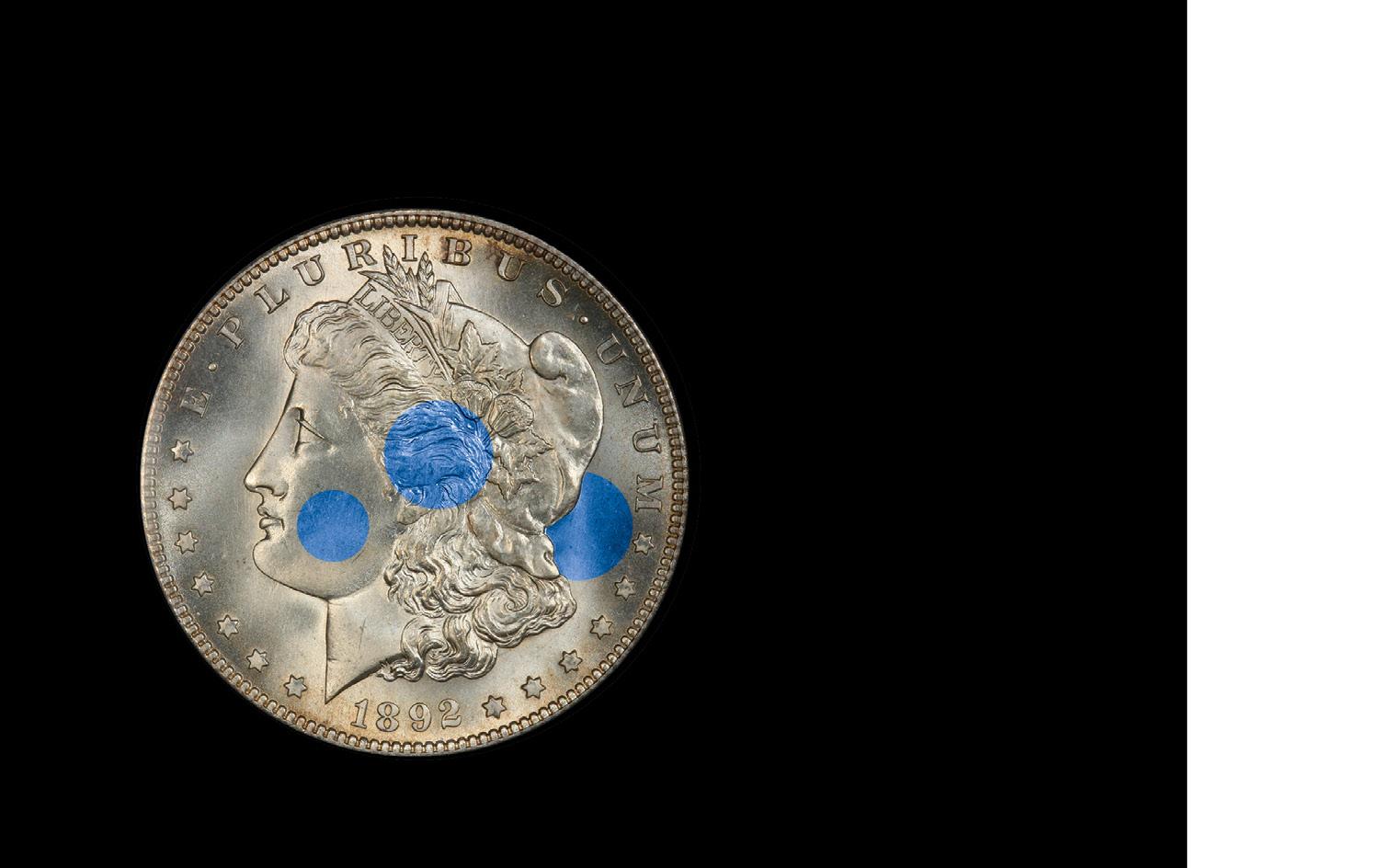
A PCGS MS69 will show only one or two miniscule imperfections. Must be fully struck and have full original luster and eye appeal.
A PCGS MS68 will have some extremely minor imperfections. Must be sharply struck, have full original luster, and good eye appeal.
A PCGS MS67 will have some minor imperfections (marks, abrasions, etc). Must be well struck and have good luster and eye appeal.
A PCGS MS66 will have a few marks and/or abrasions. The strike, luster, and eye appeal must be good.
A PCGS MS65 will have some marks and/or abrasions, but they will be minor. The strike must be above average, and
A PCGS MS64 will have some marks and/or abrasions, and they may be significant. The strike and eye appeal should be average or above and must not be negative. Luster may be somewhat subdued.
A PCGS MS63 will have marks and abrasions that are moderate in number and/or size. Strike may not be full and eye appeal can be slightly negative. Luster may be somewhat dull.
A PCGS MS62 will have no wear on high points. There may be considerable marks and abrasions and some may be severe. Strike may not be full and eye appeal may be negative. Luster may be dull.
A PCGS MS61 will have no wear on the high points. There may be multiple heavy marks and abrasions. Strike may not be full, luster may be dull, and/or eye appeal may be negative.
will have no wear on the high points. There may be many heavy marks and abrasions. Strike may not be full, luster may be very dull, and/or eye appeal may be quite negative.
A PCGS AU58 will show full detail with minor friction on only the highest points.
A PCGS AU55 will show full detail with friction on less than 1/2 of the surface, mainly on the high points.
A PCGS AU53 will show full detail with friction on 1/2 or more of the surface. There may be a very slight flatness on high points.
A PCGS AU50 will show full detail with friction over most of the surface and slight flatness on high points.
XF45 Detail is complete with most high points slightly flat.
XF40 Detail is complete with some high points flat.
VF35 Detail is 80 to 85% complete.
VF30 Detail is 70 to 80% complete.
VF25 Detail is 60 to 70% complete.
VF20 Detail is 50 to 60% complete.
F15 Detail is full in recessed areas. All lettering is sharp.
F12 Detail is evident in deeply recessed areas. Lettering is mostly sharp.
VG10 Design is worn with some detail evident.
VG08 Design is worn with only slight detail evident.
G06 Detail is flat, but rims are complete. Peripheral lettering is full.
G04 Detail is flat. Rims slightly worn. Peripheral lettering nearly full.
AG03 Rims are worn but most lettering is readable though worn.
FR02 Mostly worn, but some design details are visible.
PO01 Barely identifiable as to date and type.
For proof strikings, the primary attributes of grade are hairlines and/ or marks (or lack of), reflectivity (for brilliant proofs), and eye appeal. Note that nearly all proofs are fully struck, thus strike is usually not a factor. Strike only comes into play
when a proof shows a partial strike, resulting in a downward adjustment of grade. Note that for toned brilliant proofs, the reflectivity is as perceived under toning.
A PCGS PR70 shows no imperfections under five-power magnification. Brilliant proofs must be 100% fully reflective.
A PCGS PR69 will show only one or two miniscule imperfections. Brilliant proofs must be 100% fully reflective.
A PCGS PR68 will have some extremely minor imperfections. Eye appeal must be outstanding. Brilliant proofs will be fully reflective.
A PCGS PR67 will have some minor imperfections (hairlines or perhaps an extremely minor mark or two). Eye appeal must be very good. Brilliant proofs must be fully reflective or virtually so.
A PCGS PR66 will have a few hairlines and/or very minor marks. Eye appeal must be very good. Brilliant proofs must be fully reflective or nearly so.
A PCGS PR65 will have minor hairlines and or minor marks. Eye appeal must be positive. Brilliant proofs must show good reflectivity.
A PCGS PR64 will have noticeable


hairlines and/or small marks. Eye appeal must not be negative. Brilliant proofs may have subdued reflectivity. A PCGS PR63 will have obvious hairlines and/or marks. Eye appeal may be somewhat negative. Brilliant proofs may be dull.
A PCGS PR62 will have numerous hairlines and/or marks. Eye appeal may be quite negative. Brilliant proofs may be dull.
A PCGS PR61 will have lots of hairlines and/or marks. Eye appeal is negative. Brilliant proofs may not be reflective.
A PCGS PR60 will have no wear on the high points, but will be very hairlined and/or marked. Eye appeal is negative.
Brilliant proofs may not be reflective. Proofs below PR60 for proof strikings grading below PR60, the grading is based on the amount of wear and the standards are the same as for regular strikes.
In addition to grade, certain coins have characteristics that collectors recognize as important and PCGS designates these characteristics using the standards that follow.

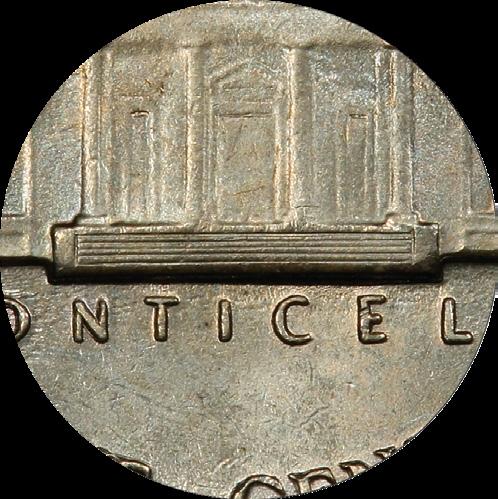
Full Steps (FS) PCGS designates Full Steps for Jefferson Nickels that grade MS60 or better and show a full five or six steps in the portrait of Monticello (Thomas Jefferson’s home) on the reverse. To qualify for this designation, a coin must also have no major disturbances, including cuts and marks, to the separation of the steps.
Full Bands for Mercury Dimes

Full Bands (FB) PCGS designates
Full Bands for Mercury Dimes that grade MS60 or better and show full separation of the central crossbands on the crossbands on the reverse. To qualify for this designation, a coin must also have no major disturbances, including cuts and marks, of the separation of the crossbands.
Full Bands for Roosevelt Dimes
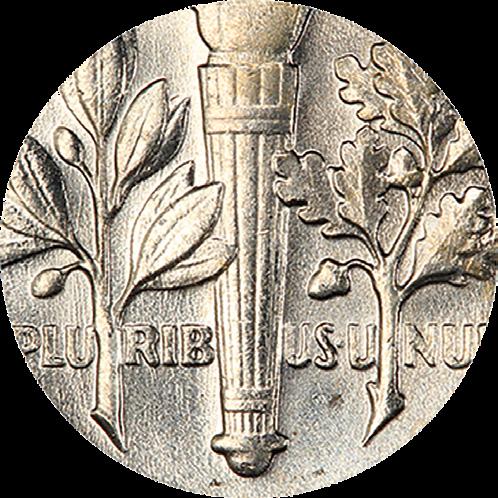
Full Bands (FB) PCGS designates Full Bands for Roosevelt Dimes that grade MS60 or better and show full separation of the upper and lower horizontal bands of the torch on the reverse. To qualify for this designation, a coin must also show no significant cuts or marks across the horizontal bands.
Full Head for Standing Liberty Quarters

Full Head (FH) PCGS designates Full Head for Standing Liberty Quarters that grade AU50 or better and show full detail of Miss Liberty’s hair (on Type Ones) or helmet (on Type Twos); Type Ones (1916-1917) must show a distinct separation between the hair cords and the cap. Type Twos (1917-1930) must show three complete and distinct leaves to the helmet, a complete outline to the bottom of the helmet, and a distinct ear hole. Note that on the ultra-rare 1918/7-S, PCGS will designate Full Head on coins that grade XF40 or better and that meet the Full Head criteria.
Full Bell Lines for Franklin Half Dollars

Full Bell Lines (FBL) PCGS designates
Full Bell Lines for Franklin Half Dollars that grade MS60 or better and show full separation of the lines on the bottom of the Liberty Bell on the reverse. To qualify for this designation, a coin must also show no major disturbances, including cuts and marks, of the separation of the bell lines.
Prooflike Surfaces
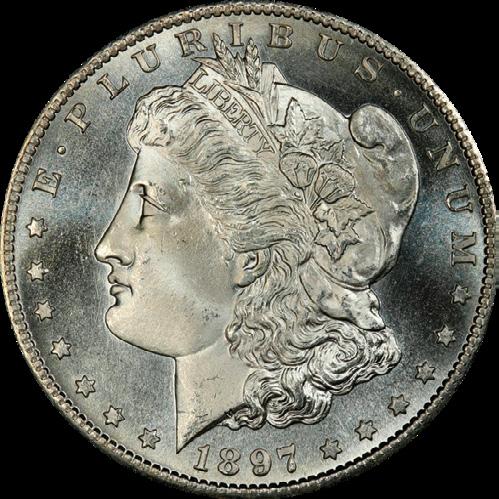
Prooflike (PL) PCGS designates
Prooflike for coins that grade MS60 or better and show clear reflectivity, i.e. mirrored surfaces at a distance of two to four inches. If the cartwheel effect or striations cause an area to lose clarity, the designation will not apply.

Deep Mirror Prooflike (DMPL) PCGS designates Deep Mirror Prooflike for Morgan Dollars that grade MS60 or better and show deep reflectivity, i.e. deeply mirrored surfaces. The differences between PL and DMPL is one of degree.
No Grade Coins
PCGS does not grade coins that are counterfeit, have been artificially toned, have had their surfaces altered, have been environmentally damaged, have been abrasively cleaned, have extremely large scratches, or have been repaired. Some allowances are made for ultra-rarities, Colonials, and Territorial gold coins, in which there are some instances when “net grading” is used by PCGS as a service to the numismatic community.
Cameo Proofs

Cameo (CAM) PCGS designates Cameo for brilliant proofs that show light to moderate frosting of the devices. Both sides of a coin must have frosted devices to earn the Cameo designation.
PCGS Holder No Grade coins are returned to the
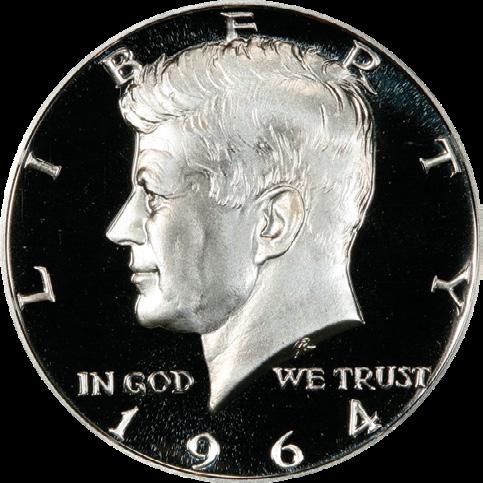
Deep Cameo (DCAM) PCGS designates Deep Cameo for brilliant proofs that display deep, even frosting on the devices of both sides of the coin.
No Grade coins are returned to the submitter without encapsulation.
Would you like further information about the PCGS Grading Standards, Designations, and No Grade Standards? View high-resolution images and in-depth videos for each at www.PCGS.com/grades. For PCGS Banknote grading standards visit www.PCGS .com/banknote/grades.
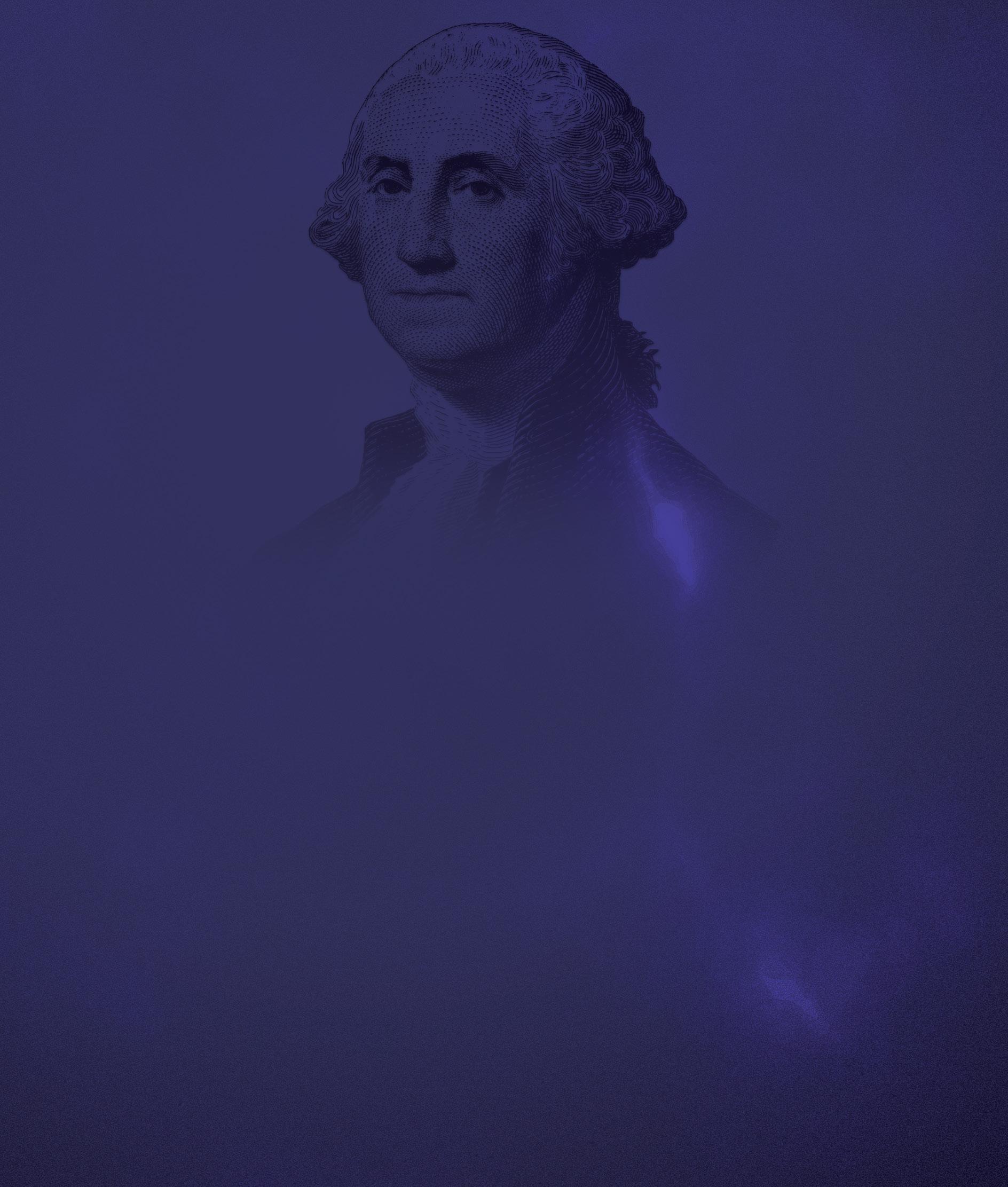
Few non-coin numismatic treasures are as rare and fascinating as this American treasure heading to auction via Stack’s Bowers Galleries. Hearkening back to the person many consider the “Father of His Country,” this medal honors the memory of George Washington, the Revolutionary War general who became the first president of the United States. Known as a Washington Funeral Medal, this exonumia memento was created as a tribute to the Founding Father in the months after his death.
Millions grieved when George Washington died on December 14, 1799, at the age of 67. Perhaps his single greatest living legacy is the young nation he helped establish. Yet, amid the promise and hope of the fledgling United States was the gaping hole left by his passing. As news of Washington’s death spread through the nation over the next weeks, tributes and memorials arose, including the creation of various medals depicting the fallen American hero. Among these, the Washington Funeral Medals of the Urn and Skull and Crossbones types, created by Massachusetts inventor and metalworker Jacob Perkins, became the most popular.
Not as often seen is Perkins’ oval-shaped, uniface Funeral Medal, intended for women to wear encased in a locket or other jewelry setting. The featured example is magnificent, completely intact, and encased in original jewelry housing. This Washington Funeral Medal was originally advertised with the headline “FOR THE LADIES” and described as, “A new impression of General Washington […] in the form of a miniature, calculated for the ladies and may be worn in any common size locket. Considered by those acquainted with him a very striking likeness; executed in gold, at the low price of a dollar and fifty cents.”
These oval-shaped Washington Funeral Medals, with their uniface design and gorgeous gold finish, were intended for encasement within a jewelry setting. The fact that any of these pieces survive, regardless of condition, is itself a numismatic miracle. But the exceptional state of preservation in which this piece has been lovingly kept for more than 220 years seemingly defies plausibility, let alone probability. This type of Washington Funeral Medal, with its oval shape and gold
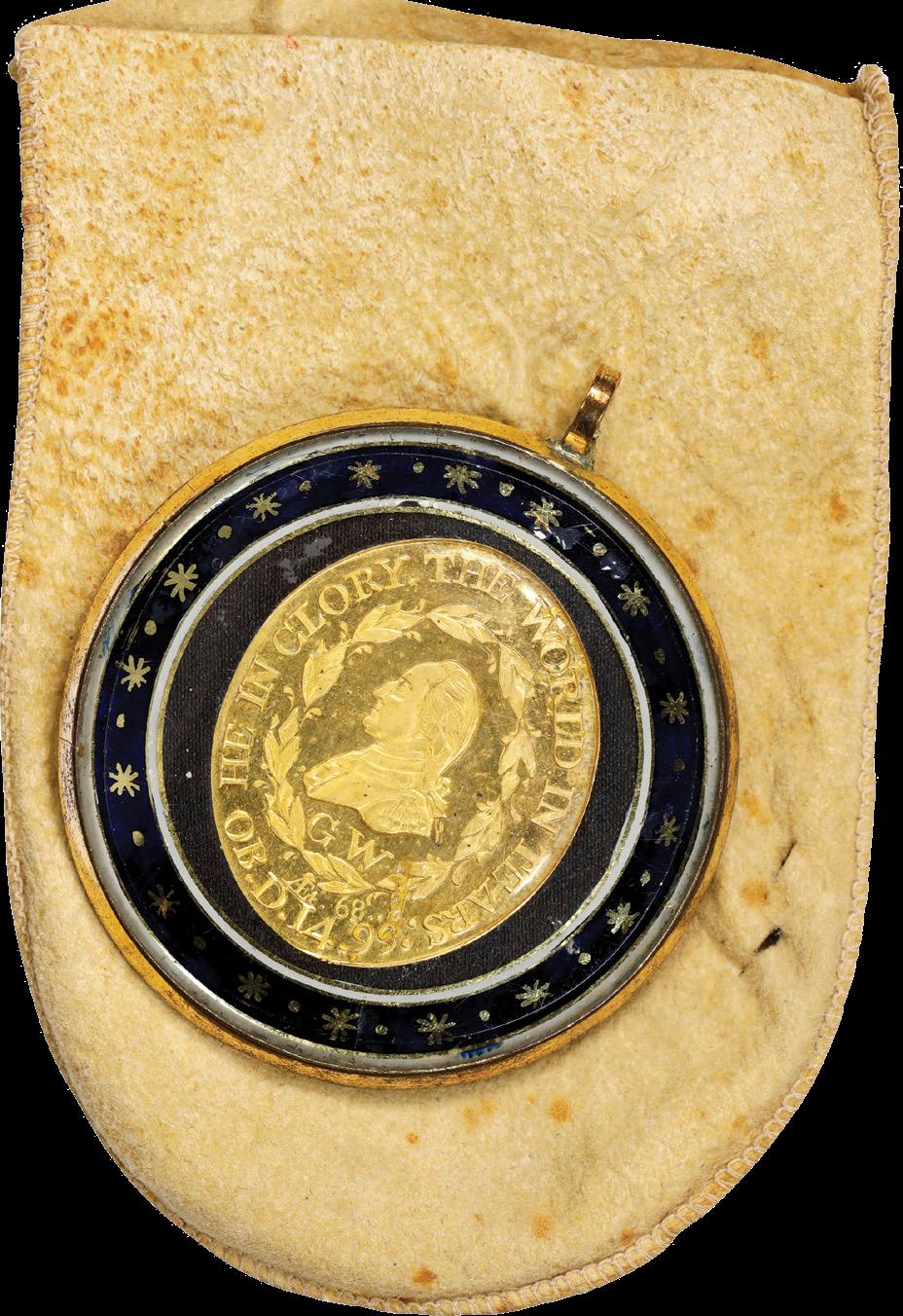
This magnificent circa 1800 George Washington Funeral Medal is graded MS65 by PCGS and is miraculously still intact in its original jewelry housing, meant to be worn by women mourning the death of the first United States President. Courtesy of Stack’s Bowers Galleries.
composition, were rare to begin with, and with its jewelry housing rarer still. Fewer than six are believed to exist; one survived until the mid-20th century, when the owner broke the jewelry housing to scavenge the gold within. Indeed, the piece offered by Stack’s Bowers Galleries is substantially rarer than even the “King of American Coins,” the 1804 Draped Bust Dollar, with its 15 known examples.
An unlikely survivor against the perilous hands of time, this exquisite Washington Funeral Medal in its original jewelry housing grades a remarkable PCGS MS65. It is a gem among gems, a piece of virtually perfect quality and vintage character, cataloged by expert scholars as “GW-75, Baker-169.” The pendant features glass faces and a gilt brass frame measuring 44.8 millimeters in diameter, with the medal itself centered against a dark fabric background and enveloping enamel-gilt border with 16 stars and 16 circles. The medal is believed to have been untouched by human hands since shortly after it was minted in 1800.
It serves as one of the last specimens of its kind, with four examples ever having been numerically graded; four others are holed, with a further four impounded in institutions and thus inaccessible to private collectors. Another example exists in a
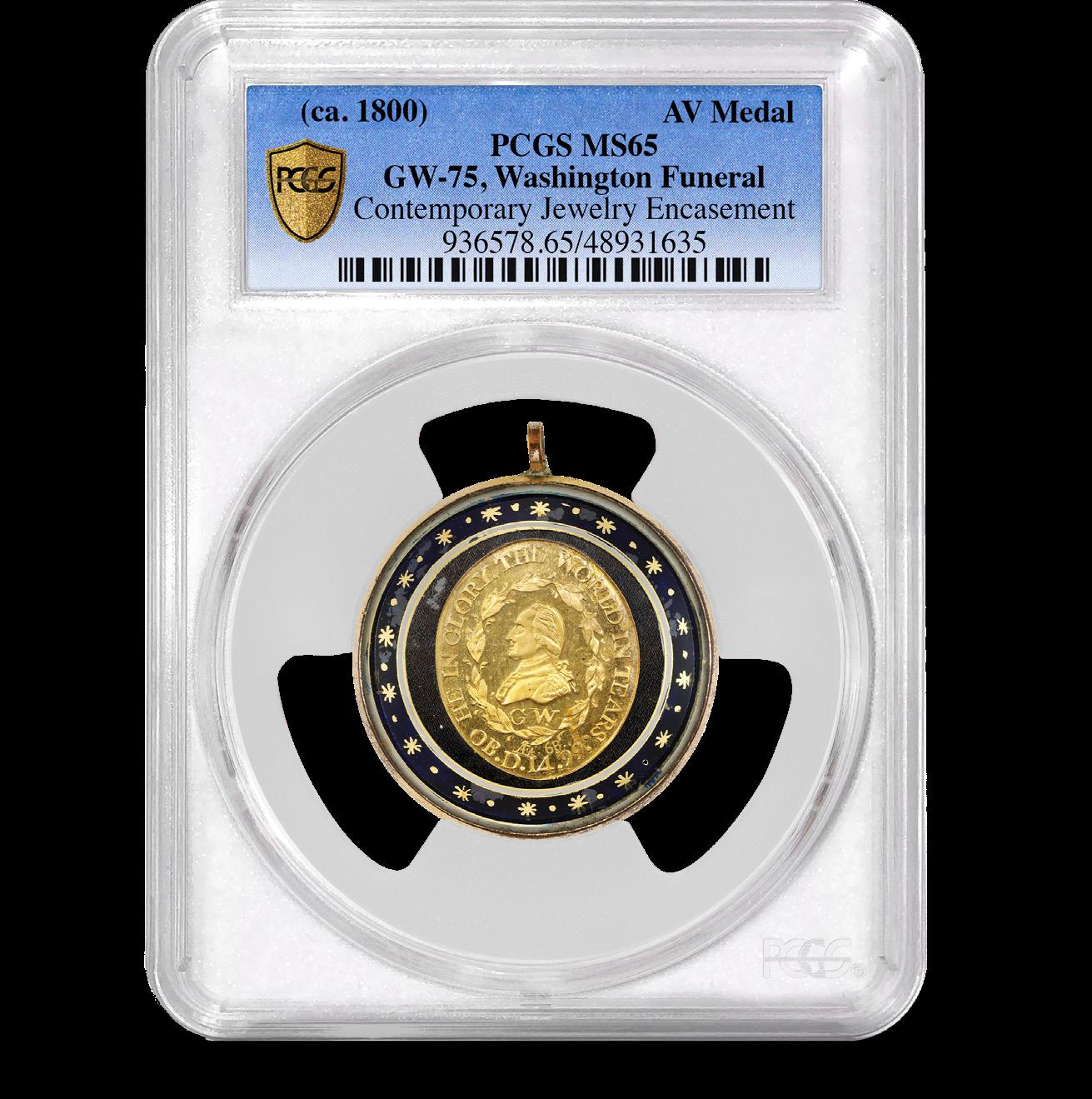

book. But this tells only part of the survivorship story. One must also understand that the rarity of a piece such as this is inherent in the fact that gold medals of the time were rare from the onset. Few were ever made.
Furthermore, the oval-shaped design of this piece tells another story: it was patently designed for women in a form that would have been seen by many at the time as “feminine,” with its terrific detail and delicate features. When most medals were being issued for purchase by men or for cabinet display, this piece was created as a wearable accessory by women mourning Washington’s death. It is categorically unique.
It stands to reason that this piece has multiple audiences today as a collectible item. While it will pique the interest of individuals who enjoy owning “trophy rarities” it would just as well find a natural home in the collections of numismatists. It also appeals to other groups. Chief among these is the body of collectors who pursue rare jewelry. Then there are collectors of Washingtoniana, the society of collectors who pursue any and all memorabilia relating to the life and times of George Washington.
Yet, this remarkable Washington Funeral Medal in its lovely jewelry housing transcends the boundaries of marketplace settings. It belongs to the sacred realm of national treasures –rare, early federal-era artifacts that tell the magnificent story about the birth and infancy of the United States. It’s therefore little wonder that the plurality of surviving examples is homed in museums and institutions. This offering may represent a once-in-a-lifetime opportunity for someone to become the curator of this extraordinary piece of American history.

Joshua McMorrow-Hernandez has won multiple awards from the NLG and ANA for his work as a numismatic journalist and editor. He has been a coin collector since 1992 and enjoys all areas of United States coinage and U.S. minting history.




and perhaps even a little profit made, by paying attention to the oft overlooked “third side” of a coin, token, or medal. In this article, we’ll review a small sample of pieces wherein what is found (or not!) on the edge is of utmost importance to the informed collector, authenticator, or specialist.
Unsurprisingly, the majority of variation in edge devices is found among the early federal coinage, as the nascent U.S. Mint experimented with suppliers and manufacturing techniques. The year 1797 saw copper deliveries from two separate vendors, one arriving just as the U.S. Mint closed due to the resurgence of a yellow fever epidemic that terrorized the city’s inhabitants in 1793. Though the precise reasoning is unknown, several batches of these planchets were marked with notching at irregular intervals on the edge, partially or completely. This creates an unusual and highly collectible edge variant amidst the otherwise plain-edged Draped Bust Large Cent issues. The completely reeded versions are Sheldon 120b and 121b.
Following the cessation of silver dollar production in 1804, the only federal issue struck with edge lettering was the half dollar, which bore its denomination spelled out along its third side. A minority portion of those struck in 1809 feature an
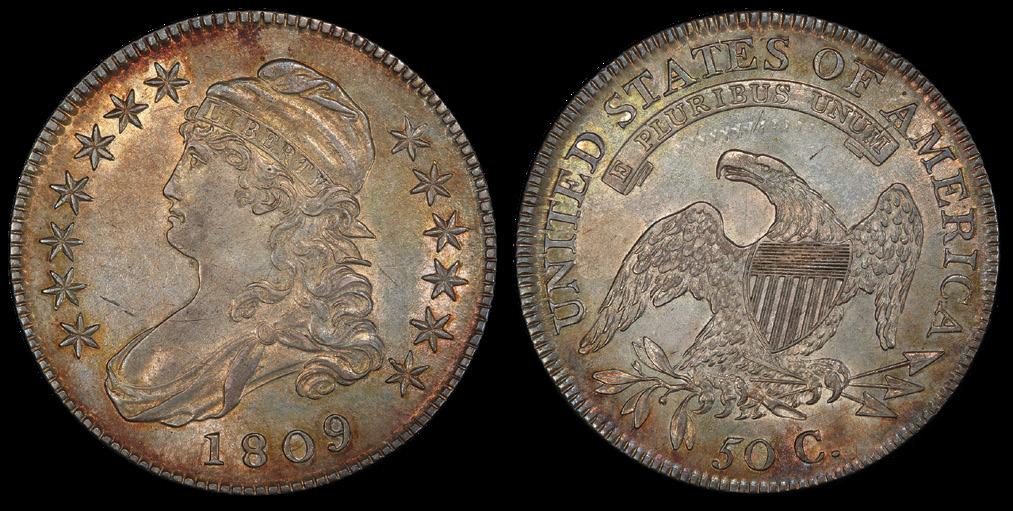
unusual additional marking that comes in two forms: either a group of vertical lines (known as the “III” edge) or a repeating crosshatch (known as the “XXX” edge). Both variants are scarcer and more valuable than their unadorned brethren, with the “XXX” being the premier issue. The impetus behind these varieties is also unknown, though it may have assisted the workman imparting the lettering. The “XXX” edge is seen on Overton 101, 102, 108a, and 110. When searching for examples, collectors can pay special attention to pieces exhibiting the series of uniform clashed segments above the eagle’s head seen in the plated image, versions of which are characteristic of Overton 102 and 110.
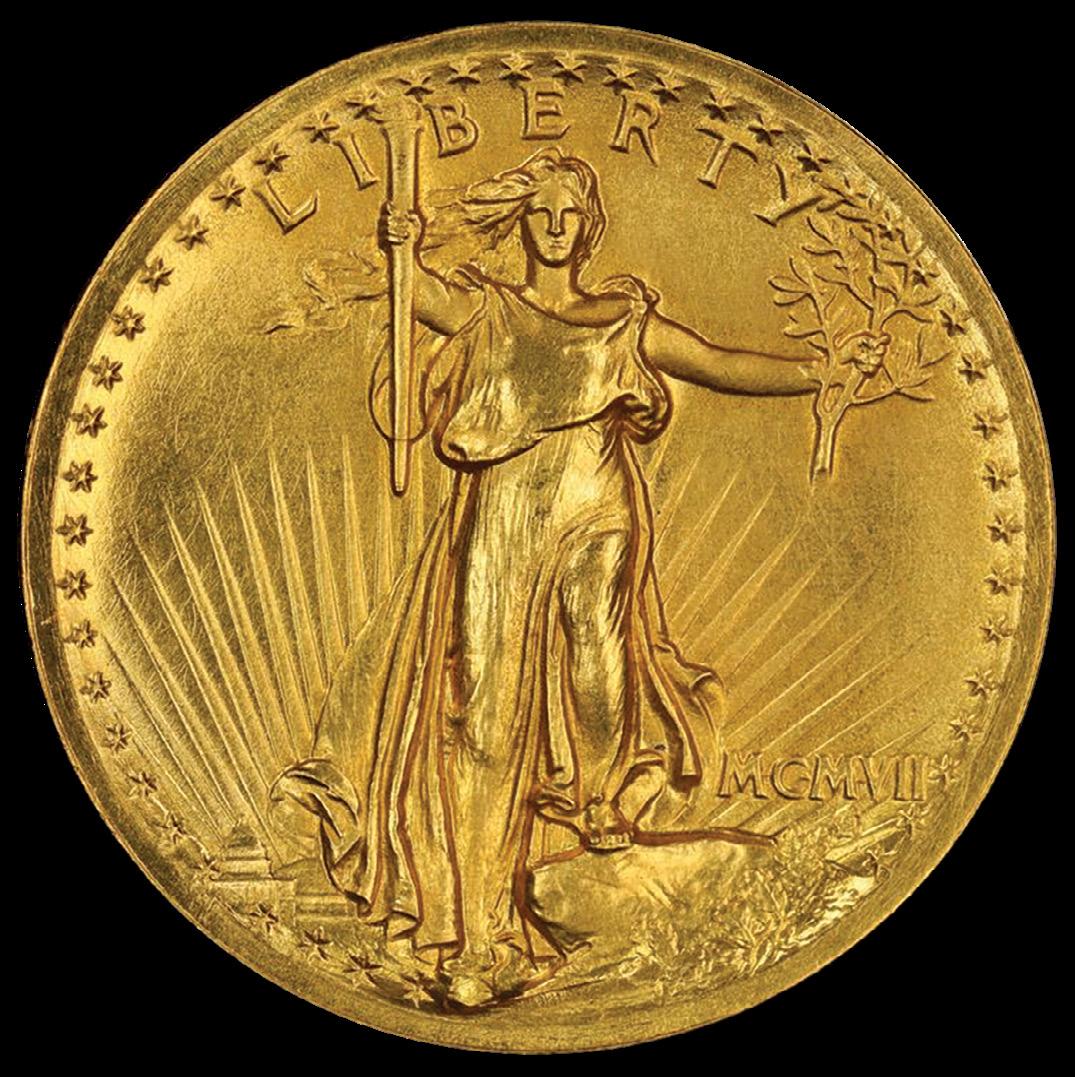
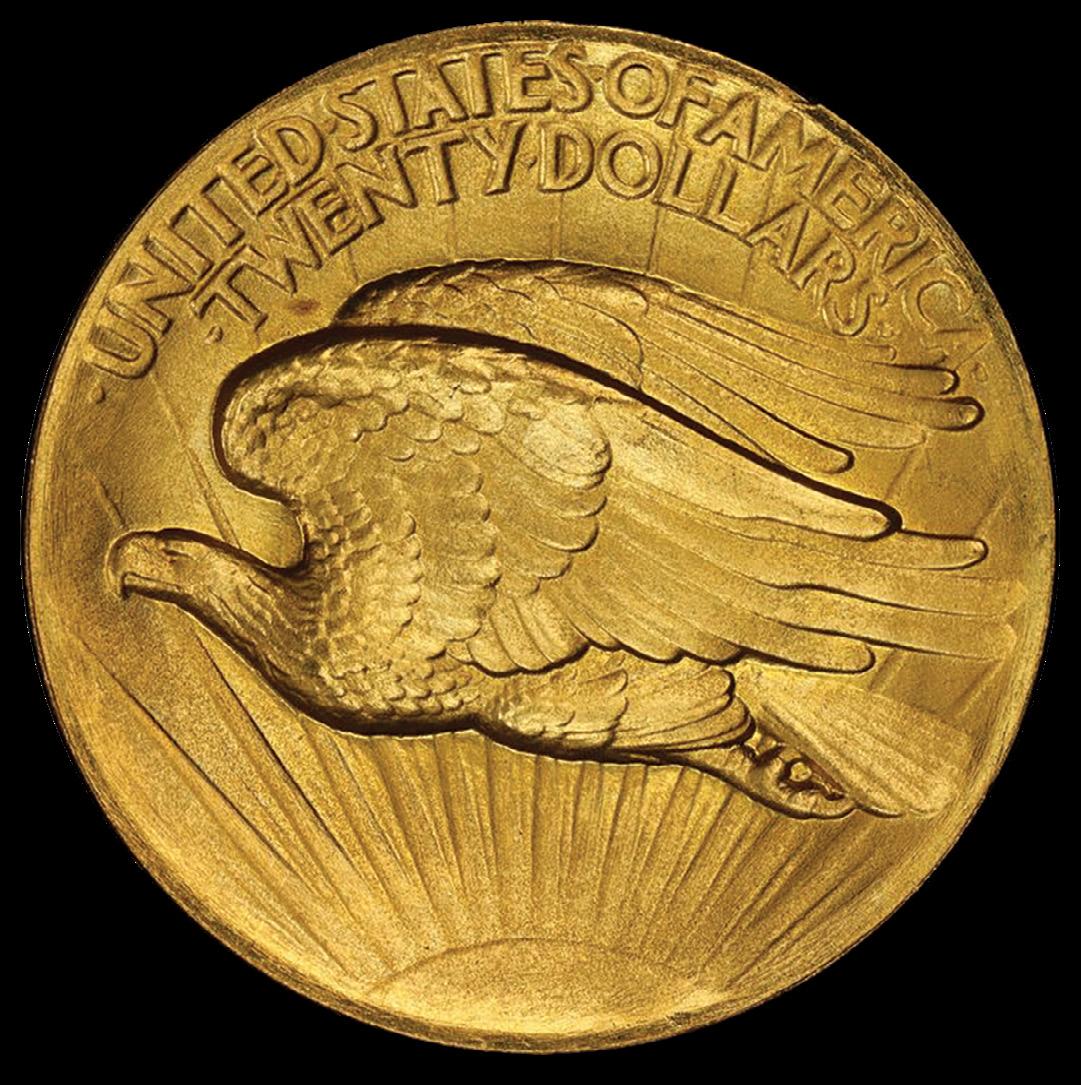
Not limited to the mysterious or experimental variations coming out of the early U.S. Mint, edge differences can be numismatically significant even to some of the most important and valuable of United States coins. While the specially struck High Relief Double Eagles of 1907 have extensive and unique die polish in the obverse fields, which can be used to distinguish them from their flat- and wire-edge counterparts, all three varieties of this famous issue were in fact struck with distinct collars, making the edge an important attribution point – especially for pieces with impaired surfaces.

Moving outside the bounds of sovereign production, tokens offer an even wider array and greater diversity of unusual edges to be searched for. While the Talbot, Allum, and Lee Cents popular amongst colonial enthusiasts typically bear an edge
inscription noting the denomination, a few unique pieces have been discovered with alternate lettering. Most likely the result of overstriking or inadvertent mixing of planchets in a facility striking tokens for multiple clients, the piece imaged here is the only example known with an edge reading “Cambridge Bedford Huntington X.X.” (presumably this represents a list of places where the intended token could be redeemed). It realized more than 10 times the value of a typically inscribed example as part of the Sydney F. Martin collection sold at auction last year.
These (and many more) examples underscore the importance of examining all sides of the coin, token, or medal under one’s loupe. PCGS recognizes and attributes all documented edge varieties of United States coins, and in 2011 introduced the Tri-View holder, which allows the edge of an encapsulated piece to be clearly viewed and inspected.

This J-1008 pattern is one of several types of early 1870s United States Mint patterns featuring the Indian Princess motif of United States Mint Chief Engraver James Barton Longacre. Courtesy of PCGS TrueView.



contributed artistic work for our nation's coinage at measure that is nothing short of legendary. Numismatic researchers and collectors alike are well-acquainted with the fact that William Barber, just a year after Longacre's passing in 1869, brought the Longacre Indian Princess design patterns to life.
The U.S. Mint embarked on a remarkable journey to craft a series of pattern coins as a tribute to the great James Longacre. These coins were destined for select collectors, esteemed government officials, and even foreign dignitaries. Among these, the inaugural pieces were the dollars, featuring various renditions of Longacre's iconic Indian Princess design. This departure from the conventional Greco-Roman portrayal of Lady Liberty, instead depicting her as a Native American woman, was a truly revolutionary and pioneering choice. This choice was influenced by the mid-19th-century fascination with Native American culture and the desire to forge a uniquely American identity. This spectacular dollar series comprises 12 distinctive issues, each bearing its own Judd number, ranging from J-1008 to J-1019.
The first of these distinctive designs graces the obverse with an Indian Princess seated beside a globe, adorned with a headdress inspired from Native American culture. The word
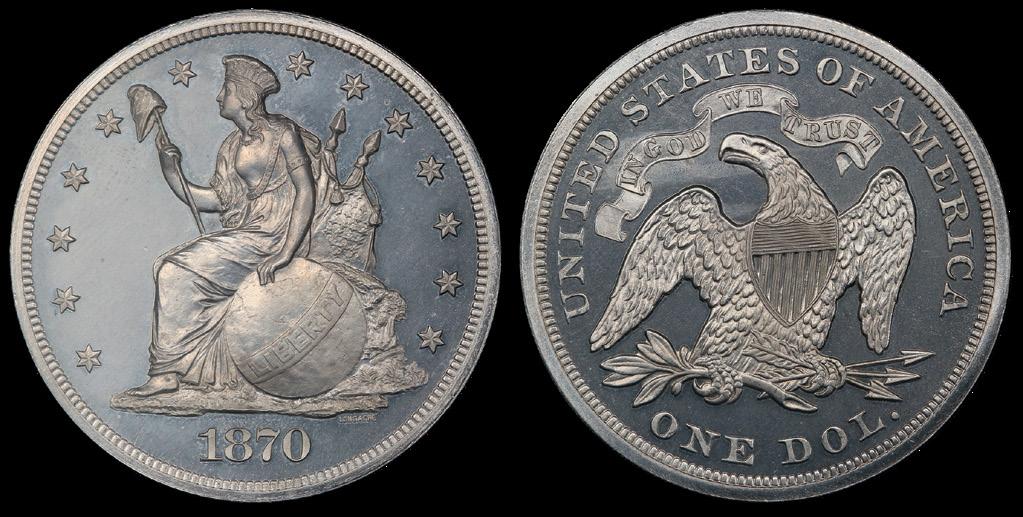
This J-1019 is the final type of the 12 patterns depicting Longacre’s Indian Princess motif on a dollar piece. Courtesy of PCGS TrueView.
“LIBERTY” gracefully arcs across the center of the globe, and in her hand, Liberty holds a pole crowned with a Phrygian cap. The reverse proudly displays the word “STANDARD” at the top, with “1 DOLLAR” encircled by a wreath of cotton and corn.
Among the examples of these dollars, we find rare combinations:
• J-1008, in silver with a reeded edge, boasting only three or four known specimens
• J-1009, in silver with a plain edge, with a mere three confirmed specimens
• J-1010, in copper with a reeded edge, with only four or
• J-1011, in copper with a plain edge, with around eight known
• J-1012, in aluminum with a reeded edge, counts about three specimens, including one in the Farouk collection
• J-1013, in aluminum with a plain edge, offers fewer than three confirmed examples (Notably, specimens were found in the collections of King Farouk and Lenox Lohr, though it remains uncertain if these listings represent the same or distinct coins. The recently sold PCGS PR65 specimen at Superior September 2005, Simpson-Heritage August 2021, Heritage January 2022, and Heritage July 2022 graded PCGS PR66, although lacquered, is almost certainly the coveted Farouk coin.)

The J-1013, pictured here, is a rare type once belonging in the collections of Egypt’s King Farouk and legendary numismatist Lenox Lohr. Courtesy of PCGS TrueView.
The second rendition of the Indian Princess Dollar retains the same obverse design but takes a bold departure from tradition on the reverse of the Liberty Seated Dollar. This version of the dollars boasts examples in various combinations:
• J-1014, in silver with a reeded edge, with fewer than a dozen known
• J-1015, in silver with a plain edge, also with fewer than a dozen specimens
• J-1016, in copper with a reeded edge, accounting for over a dozen known pieces
• J-1017, in copper with a plain edge, with a similar count of over a dozen known specimens
• J-1018, in aluminum with a reeded edge, with only four known
• J-1019, in aluminum with a plain edge, with at least three confirmed examples
These remarkable coins have been sought after and cherished by renowned collectors from the moment they were struck. Among these collectors are names that resonate through the numismatic world, including King Farouk, Bob R. Simpson, William R. Sieck, and Wallace Murphy, to name but a few.
It should be noted that there is also a series of pattern dollars struck in 1871 with a variation of the Indian Princess design not mentioned in this article.
Before these remarkable pattern coins, Longacre's most celebrated Indian Princess design graced the obverse of the Type 2 gold dollar coin in 1854, replacing the earlier Liberty Head design. Additionally, his Indian Princess design found its way onto the newly minted $3 gold piece, a coin believed to have been crafted for the convenience of purchasing a full sheet of 100 stamps, priced at 3 cents each in 1854. James Longacre's Indian Princess design marked a bold new direction reflecting the evolving times and cultural influences of mid-19th-century America. Despite initial controversy, it has since become an iconic and cherished facet of American numismatic history.

The $3 gold coin, struck for circulation from 1854 through 1889, features another example of Longacre’s designs inspired by Native American symbolism. Courtesy of PCGS TrueView.
Longacre's groundbreaking approach to coin design left an indelible legacy that transcended his tenure at the United States Mint. Among Longacre’s myriad designs, the Indian Princess motif stands as a testament to American coinage’s capacity to evolve and embrace the cultural and artistic influences of each era. As a result, it remains a cherished favorite among collectors and numismatists, who hold it dear for its historical significance and artistic splendor alike.
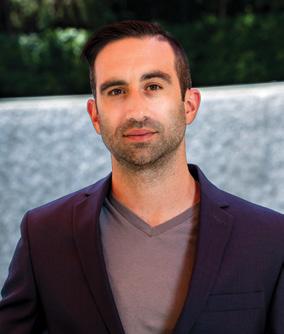
Charles Jonath is the President & Chief Numismatist of VCD Auctions. His passions lie with Pioneer Gold, U.S. Patterns & Collectible Ingots. Visit Vegascoindealer.com.
The Walking Liberty Half Dollar, Morgan Dollar, and Saint-Gaudens Double Eagle are among the popular pieces still boasting much market strength even as conditions shift in some sectors of the industry.
Courtesy of PCGS TrueView.
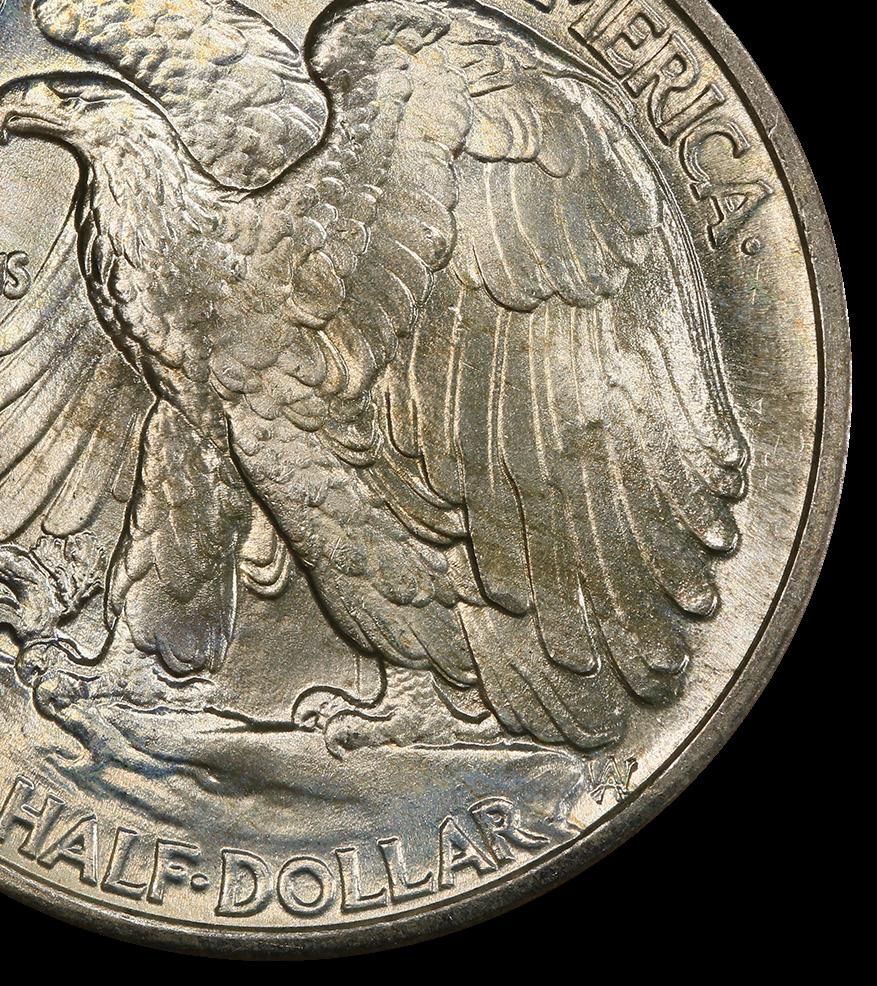

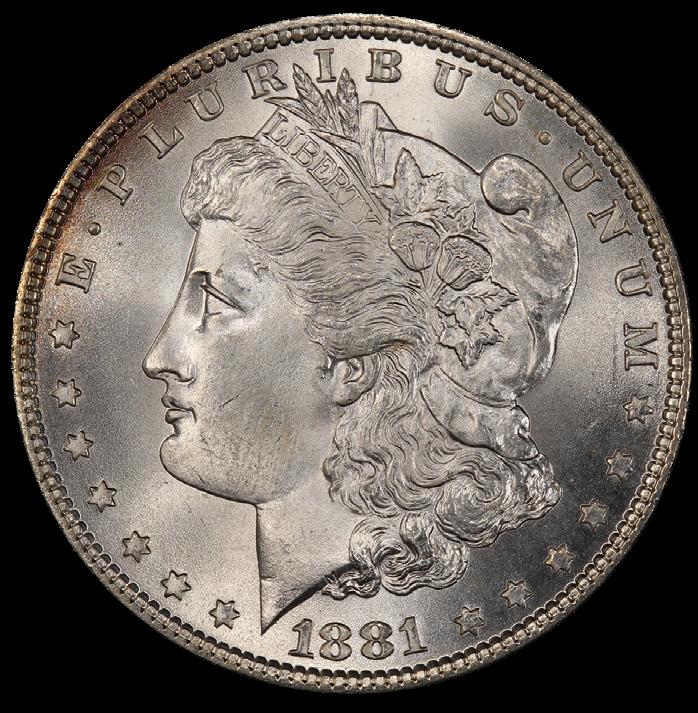


Rare coins remain strong for the scarcest and highest-indemand items. Coins with low populations in the highest grades will continue to garner strong prices because of their underlying scarcity and demand. Common and generic items are soft unless there is a bullion play involved. Do not buy problem coins with “bargain” prices; especially in speculative markets, avoiding any pitfalls, like problem coins, is crucial too.
Dealers expect higher bullion levels, but all remain reluctant due to past bullion market losses. They’re buying, but… Well, let me give you an example. While a dealer might play on a deal involving gold or silver coins, much of the price paid will reflect how easily the dealer can “layoff” the product if needed. Two deals walk into a shop: 1) collector coins requiring a large capital outlay and substantial work selling the items, or 2) PCGS-graded coins with some underlying bullion value on which a constant market exists to both buy and sell.
Deal number one is a neat offering with some collector coins, some generic type coins, a couple of coin sets, and a few silver dollars. None of the coins have a value of more than $500, but most pieces are in the $1 to $20 range, with a lot of the low-end type coins worth 25 to 50 cents each. That dealer should make a fair profit on this purchase after selling the coins, but it will involve a lot of time to inventory, evaluate, and sell.
Deal number two is a group of PCGS-graded Morgan Dollars and gold type coins. Deal number two is different right off the bat. The dealer knows they can make an offer sight unseen on these coins before they are ever physically
examined. (Note: back when I was a dealer, I always required a seller to text me an image of the coin in the holder with the PCGS spec and serial number. This is good practice to protect the buyer and seller.)
When I was a dealer making offers for PCGS coins, I had the ability to make a cash offer and then incentivize the potential client to bring them to me because I would pay “at least” what I offered minimum, but a “little more” if the coin/ coins were particularly pretty.
Not only was this a huge advantage to me as a dealer, but the customer had the ability to get other bids! This allowed the seller to get other offers and compare them to mine. Frankly, if it was an item I was interested in, why wouldn’t I make a strong offer? I bought a lot of coins in those days!
While the coin market is healthy, dealers aren’t chasing deals requiring a lot of work. The bottom line is that PCGSgraded coins in general, rarities, and bullion-related items are quite healthy right now, but there is softness in other areas.
Stuff is stuff, and cash is king.
Interestingly, one of the biggest disparities I see currently is the disappearance of premiums on numismatic gold in the MS61, MS62, MS63, and even MS64 grades. Generally, PCGS-graded gold type coins carry a premium over their melt value based on the market for these items. Currently, and most likely a result of the higher gold-bullion levels, premiums on many common Liberty Head and Saint-Gaudens Double Eagles are quite modest. This is also true of Liberty Head Eagles.
Yes, these prices will fall if bullion levels tumble. Yet,
interestingly enough there is generally some cushion because they are, after all, numismatic gold items.
Generic coins are trending softer, but there are major dealers stockpiling generics because of the belief in their underlying value. When I’m talking about “generic” coins here, I’m mostly discussing PCGS-graded Morgan and Peace Dollars, as well as Walking Liberty Half Dollars. Not only are these items still traded frequently in roll quantities, but PCGS-graded genericdate coins are often sought in large lots. It isn’t unusual for a dealer to have an order for 500 PCGS MS64 Morgan Dollars or 250 PCGS MS65 Walking Liberty Half Dollars.
While a lot of the market for similar items such as these is often determined by large orders, the basal value is most often pretty stable. In other words, dealers with plenty of capital believe in the underlying value of these high-demand U.S. numismatic items and are willing to stockpile large quantities for higher price levels later. Most medium-sized and smaller dealers don’t have the capital available to stockpile these coins. Any softness in these markets currently is transitory.
The most anticipated items of the year are the new 2024 Morgan and Peace Dollars. The Mint State issues of both the Morgan and Peace Dollars will be available for sale in the summer, while the proof issues of both will be available in the
fall. The 2024 Proof Gold Eagle and Mint State Silver Eagle will be available in the spring, while the Mint State 2024 Gold Eagle and Proof Silver Eagle will be available in the summer.
Using the original designs of Augustus Saint-Gaudens, George T. Morgan, and Anthony de Francisci in the American Eagle and new silver dollar designs, combined with modern minting technology, is a numismatic twofer. No wonder these modern U.S. Mint coins are so popular. While modern coinage is quite lovely, and there is usually some underlying bullion value, a buyer must always weigh the premiums paid (over melt value) for the “pretty design” when determining if the price paid will ever be recouped.
The market for rare coins is constantly changing. Always focus on underlying value and the security of authenticity and quality with a PCGS-graded product.

Vic Bozarth is a familiar face on the bourse floor to many who have attended coin shows over the last five decades. He’s a self-described “coin wheenie” who has attended more than 1,000 shows and vast experience both buying and selling many of the finest PCGS coins. His numismatic knowledge as a dealer and collector provides a unique perspective on our industry.
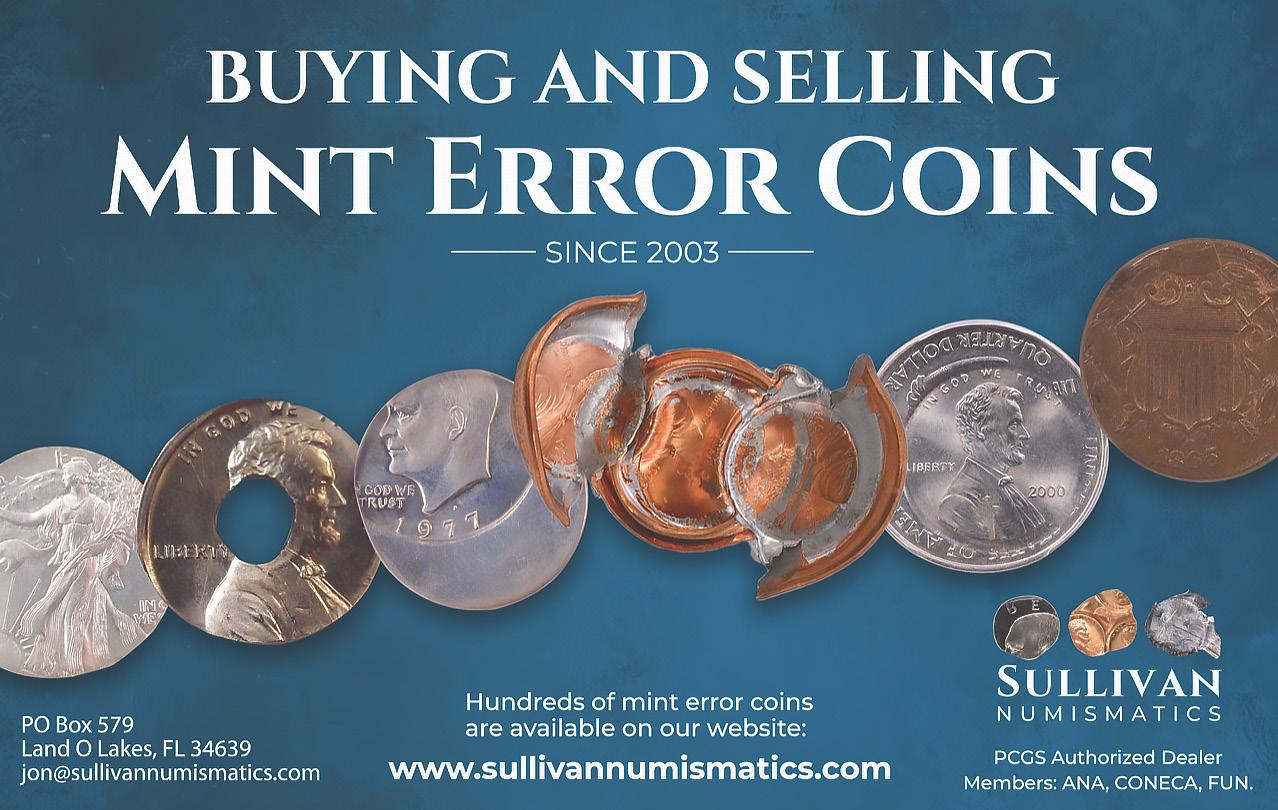
The 1969-S Doubled Die Lincoln Cent in the grade of PCGS MS66RD saw tremendous price appreciation in 2023. Courtesy of PCGS TrueView.



The year 2023 was exciting for the coin market. Many great coins performed well over the year. Of course, not all collectors collect coins for investment – many acquire coins for sheer enjoyment. However, it’s a great treat to be in a hobby where you can collect, have fun, and at times see some of your coins appreciate in value. Multitudes of coins performed well last year, but let’s highlight the top 10 biggest gainers of 2023 based on changes reflected in the PCGS Price Guide.
The first coin on our list is an 1856 $3 graded PCGS PR62. It’s an extremely rare issue, with only five or six examples believed to exist. The coin is so rare that if someone would like to own one, they’d likely have to wait several years before a specimen shows up in the marketplace. And even then, there’d be no guarantee that the potential buyer would win that coin at auction.
Prior to 2023, the last such piece that sold at public auction was in 2017, and the last that crossed the block before that was in 2012. So, even if a collector had the funds to buy a specimen, they cannot just go out and buy one. On February 9, 2023, Heritage Auctions sold a PCGS PR62 for $90,000. The previous auction sale for a PCGS PR62 sold for $12,650 at auction in 1996. Before the sale of the PCGS PR62 example that was sold in 2023, the PCGS Price Guide had this coin listed at $30,000. So, with data stemming from the most recent sale, the PCGS Price Guide listing for the PR62 grade was raised to $95,000, representing a 216% increase.
The coin bringing the second-highest gain in 2023, based on the PCGS Price Guide, is the 1969-S Doubled Die Lincoln Cent. This coin is now over 50 years old, but it remains as one of the most nostalgic and exciting coins to come to light in the
past half century or so. This coin is responsible for bringing many collectors into the hobby, as so many dreamt of landing an example of their own when the news of this spectacular variety came to light in the 1970s. Even though most of these incoming collectors never found one in circulation, this coin still managed to attract many numismatic newcomers over the past several decades.
In January 2023, GreatCollections sold a PCGS MS66RD for $601,875, which was a record price for the 1969-S Doubled Die Lincoln Cent in any grade. Before the auction, the PCGS Price Guide listed the coin at $200,000 in PCGS MS66RD. Following the aforementioned January 2023 sale, we moved the price of the MS66RD to $605,000 on the PCGS Price Guide to reflect the current state of the market for this coin in that grade, which shows a 202% gain.
The third coin in the Top Gainers list for 2023 is the 1914-D Saint-Gaudens Double Eagle graded PCGS MS67. Although this issue is not rare in lower grades, it is scarce in the grades of MS66 to MS66+. They’re virtually unheard of in MS67, with the exception of one lone example graded by PCGS at that lofty grade. In January 2023, Heritage Auctions sold the only PCGS MS67 specimen for $204,000. Prior to the sale of the coin in 2023, the same piece traded in 2005 for $43,125. This

appreciation in value warranted pricing changes for this coin in the PCGS Price Guide, which saw the listing increase from $85,000 to $250,000 – a 194% increase.
The featured chart also reveals the top 10 coin gainers for the year. To view many more coin price changes for the year as well as market data for other date ranges, you can visit the PCGS Price Guide and click on “Price Changes.” Once there, you can view many more coins listed on the PCGS Price Guide Gainers list, including the top daily gainers, weekly gainers, three-month gainers, one-year gainers, two-year gainers, three-year gainers, five-year gainers, and even the leading 10year gainers. We can’t wait to see what other extraordinary coins will show up on the Top Gainers list in 2024!

Jaime Hernandez is an editor for the PCGS Price Guide and has been a proud member of the PCGS team since 2005. By the time he reached his early 20s, Jaime was successfully buying and selling coins with some of the most prominent dealers and collectors in the country. Email: jhernandez@collectors.com


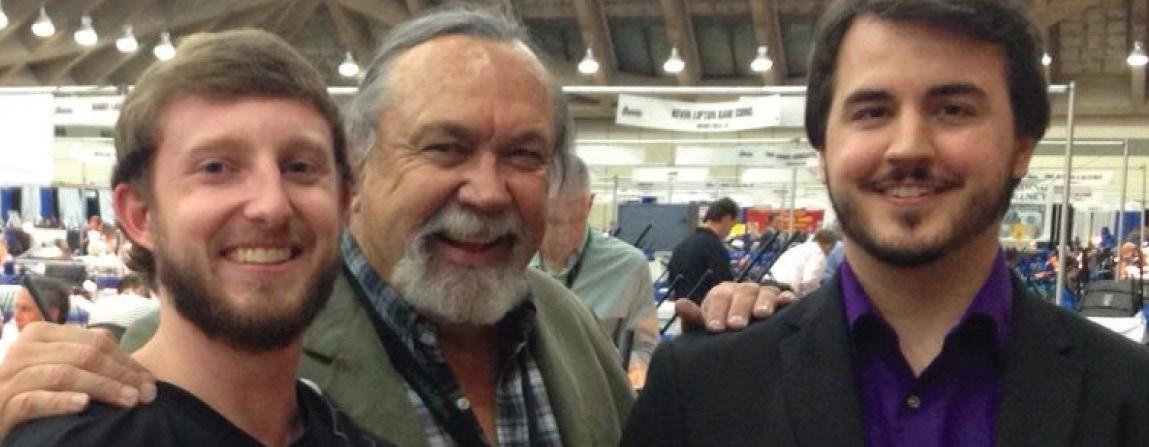 — Chris Victor McCawley
— Chris Victor McCawley
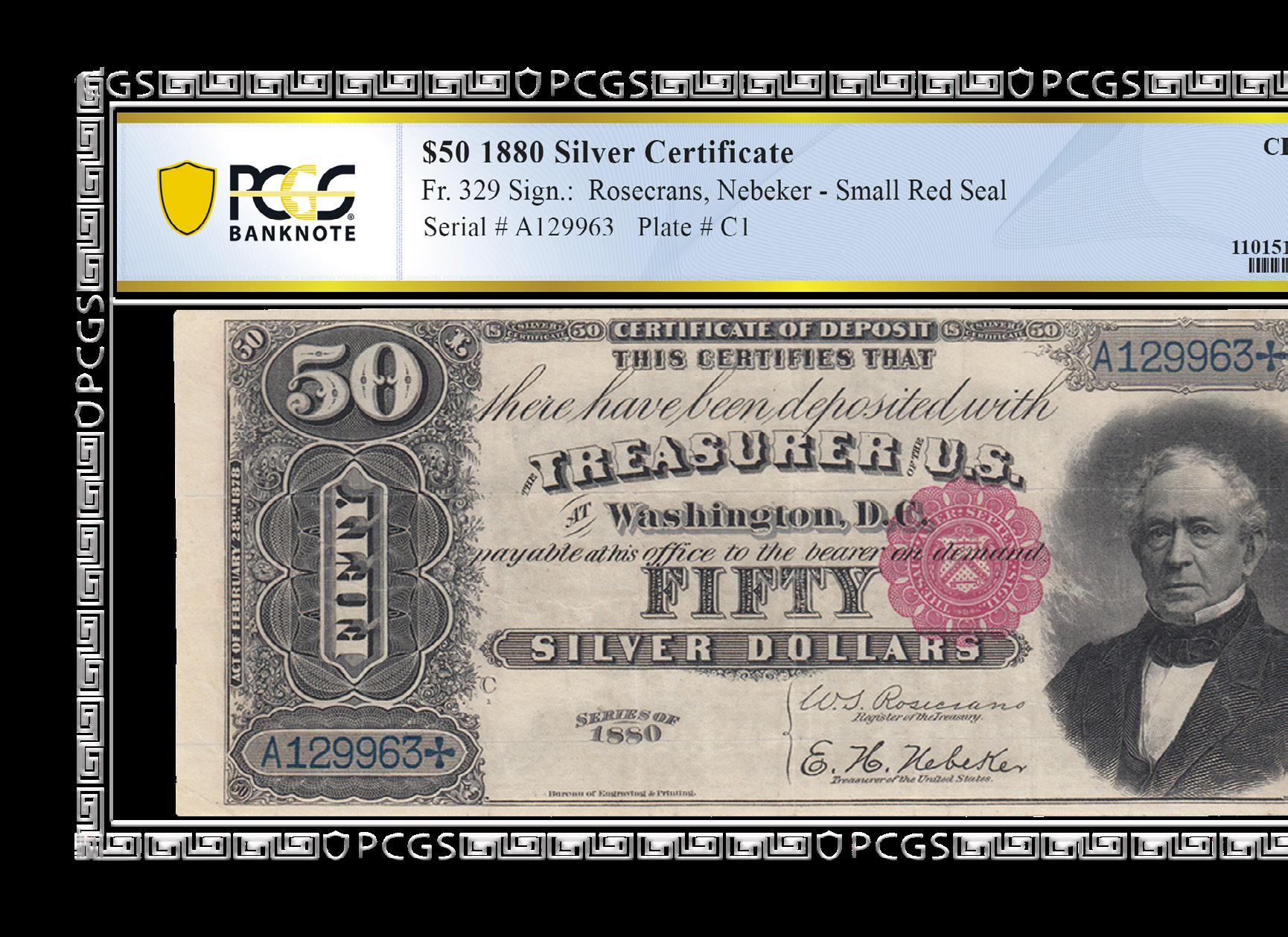
Plenty of paddles will rise when seldom-seen rarities, like this 1877 Indian Cent graded MS66+RD representing the finest grade for a coin of its kind, hit the auction circuit. But will bidders be as enthusiastic for more commonly seen pieces? Courtesy of PCGS TrueView.
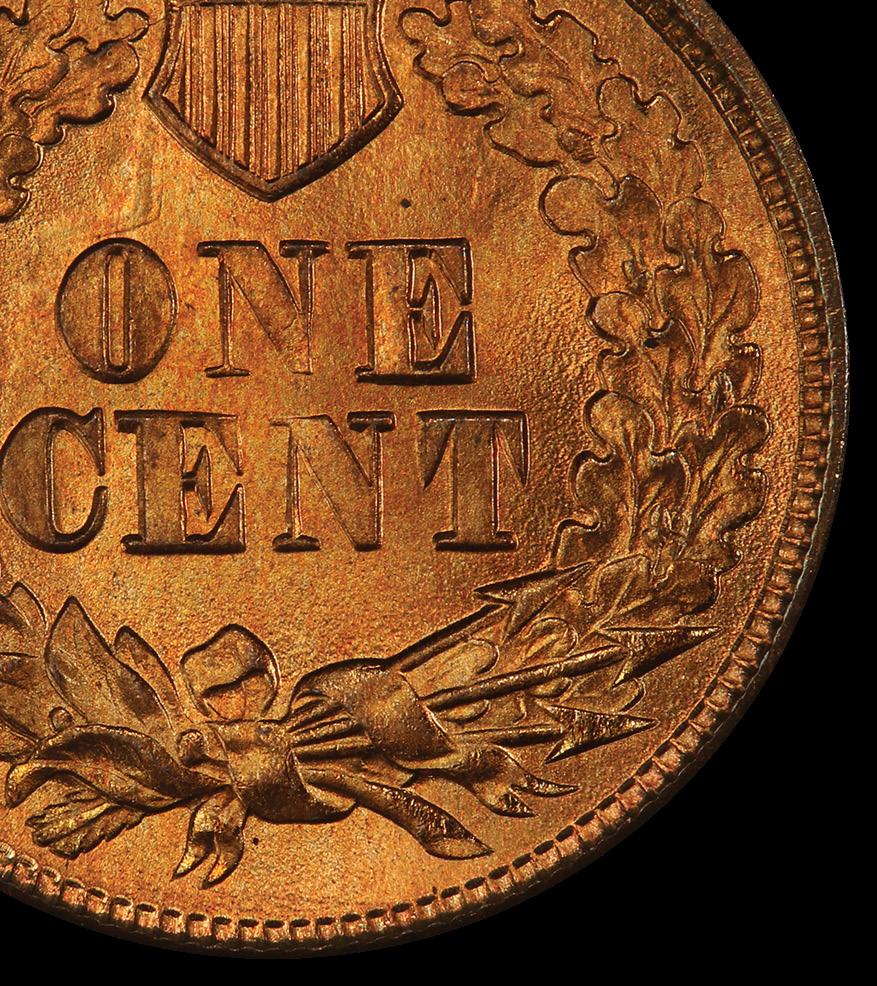


The numismatic markets include rare coins, bullion coins, and modern coins, among others. All of these sectors of the market differ in terms of availability and demand. The thought that struck me recently was just how different each of these markets can be. Interestingly, the difference most often comes down to patience and timing.
There’s a difference between collectors and dealers. Collectors generally pursue coins for the sheer joy of collecting them, while dealers handle coins in pursuit of profit. Many, including myself in the past, have been on both sides of the coin (or bourse table), so to speak, because so many of us are both collectors and dealers.
The ability of a collector to be patient is a distinct advantage… To a certain extent, dealers can’t be too patient. Their livelihood is dependent on buying and selling something.
What are dealers saying now in regard to the rare coin market?
“I can always buy coins, but not the coins I want to buy,” is the common sentiment among several of the dealers recently interviewed. A well-known dealer who specializes in betterdate gold coins stated, “I have to pay full PCGS Price Guide levels for many dated and mintmarked gold coins if available. Although there are exceptions, most sell immediately.”
The “if” in this statement reflects the difference (in value) between coins that are always in demand and other coins. Scarce, not-often-available coins almost always have a buyer willing to pay a premium.
We are experiencing maturity in many areas of the rare coin market. Sure, nicer, key-date, low-population coins are still garnering great (and even record) prices, but many desirable and scarce coins have “topped” out.
Gold bullion price levels reached an all-time high in late 2023. Many times, dealers walk a tightrope between the amount of capital they allocate for rare coin inventory versus bullion and/or modern inventory. Generally, rare coin inventory is more stagnant than bullion and/or modern material. And yet, depending on the capital available, some rare coins are worth stocking regardless of market timing.
Take, for example, the two magnificent cents sold recently by GreatCollections: an 1856 Flying Eagle Cent and an 1877 Indian Cent in PCGS holders – the finest-known examples for their dates. Not surprisingly, these two key-date coins brought record prices. While many collectors pursue both of these incredible coins, most can’t afford them. Regardless, there were many with the financial wherewithal to buy these rarities, especially since neither had been on the market for several years.
Key-date, low-population coins are always in demand. The big question is whether you are patient enough to wait for the coin that is right for you. Here’s the second part of this “tip”: If you are fortunate to find the coin you really like, do not hesitate, even if it’s a little too pricey! Most often, rare coins deserve both your patience and the price you paid.
What about other coins, like bullion and modern pieces? While patience is still important, timing is much more crucial to the success of your transactions.
Interestingly, while premiums for many popular bullion items, including U.S. gold and silver eagles and U.S. 90% silver coinage, were quite substantial through most of 2023, the premiums have by and large more recently dissipated. Your bullion purchasing and sales decisions should always include both the current price level and the premiums charged in relation to the melt price. Currently, bullion premiums over their melt value are smaller on many popular items than they had been for the bulk of 2023.
Dealers can’t always stock the coins they would like to stock. Indeed, dealers walk that proverbial tightrope in terms of inventory. Not only do dealers have to worry about what they stock, but they also have to worry about inventory valuation levels.
We take for granted that most dealers won’t pass on a truly good deal involving rare coins. What most don’t realize is that demand and the price dealers are willing to pay drop sharply if a dealer has too many pieces on hand or is cash poor because of too much inventory. Marginal (or generic product) coin deals not only lose value, but they also become much more difficult to sell in terms of the effort involved. Successful dealers keep an eye on the liquidity of their inventory, too.
Modern coinage, often bullion related, is relatively easy to stock, with logistics (availability) often being the “if” factor. Much of modern merchandise, while bullion-price dependent, is often date sensitive. Demand for a new issue is often quite high, resulting in highly speculative pricing. Many times, the aftermarket price for an item will be more modest once the hype has dissipated.
Remember, you have to ask yourself this question: are you buying the item because you want the item, or are you more interested in the bullion price play? If you are prioritizing the bullion aspect, use a bullion medium with the smallest premium over the melt value.
The U.S. Mint has successfully produced and marketed hundreds of fabulous products over the decades, but the American Silver Eagle and American Gold Eagle programs and the additional issues their success has spawned has been truly amazing. Most recently, the new Morgan and Peace Dollars have been quite popular. These are gorgeous oneounce silver issues that sell for between $76 and $80 each as of this writing.
Remember, the numismatic and bullion markets are two different markets.
Dealers, if they want to stay in business, don’t chase
marginal or bad deals. When the market is mature, dealers value their cash position more than their inventory position. Over the decades, many successful dealers have used their cash position when the market is softening to cherry pick great coins at lower prices.
Depending on the cash position of a dealer, many times these coins are not available for sale until the market heats back up. These dealers actually prefer a poor market because they perceive it is much easier to buy good coins. The critical difference between these “bargains” is the quality factor. Buying any coin with an issue because it is discounted means the coin will have to be discounted when sold.
Did that issue disappear just because you bought it? Ah, hmmm…
Patience and timing aren’t absolutes, but when talking about rare coins, bullion coins, and modern coinage, you are wise to employ these two attributes accordingly. Be patient with your rare coin purchases as well as sales, but don’t procrastinate when making your purchase or sales decisions for bullion or modern coins – especially if the market conditions are favorable.

Vic Bozarth is a familiar face on the bourse floor to many who have attended coin shows over the last five decades. He’s a self-described “coin weenie” who has attended more than 1,000 shows and vast experience both buying and selling many of the finest PCGS coins. His numismatic knowledge as a dealer and collector provides a unique perspective on our industry.
•In-Depth Market Analysis
•Collector Spotlight
•From The Grading Room Feature
•And More!

•
• Six Month and Annual Contracts are O ered. Inquire Today!


March
March
APRIL
April


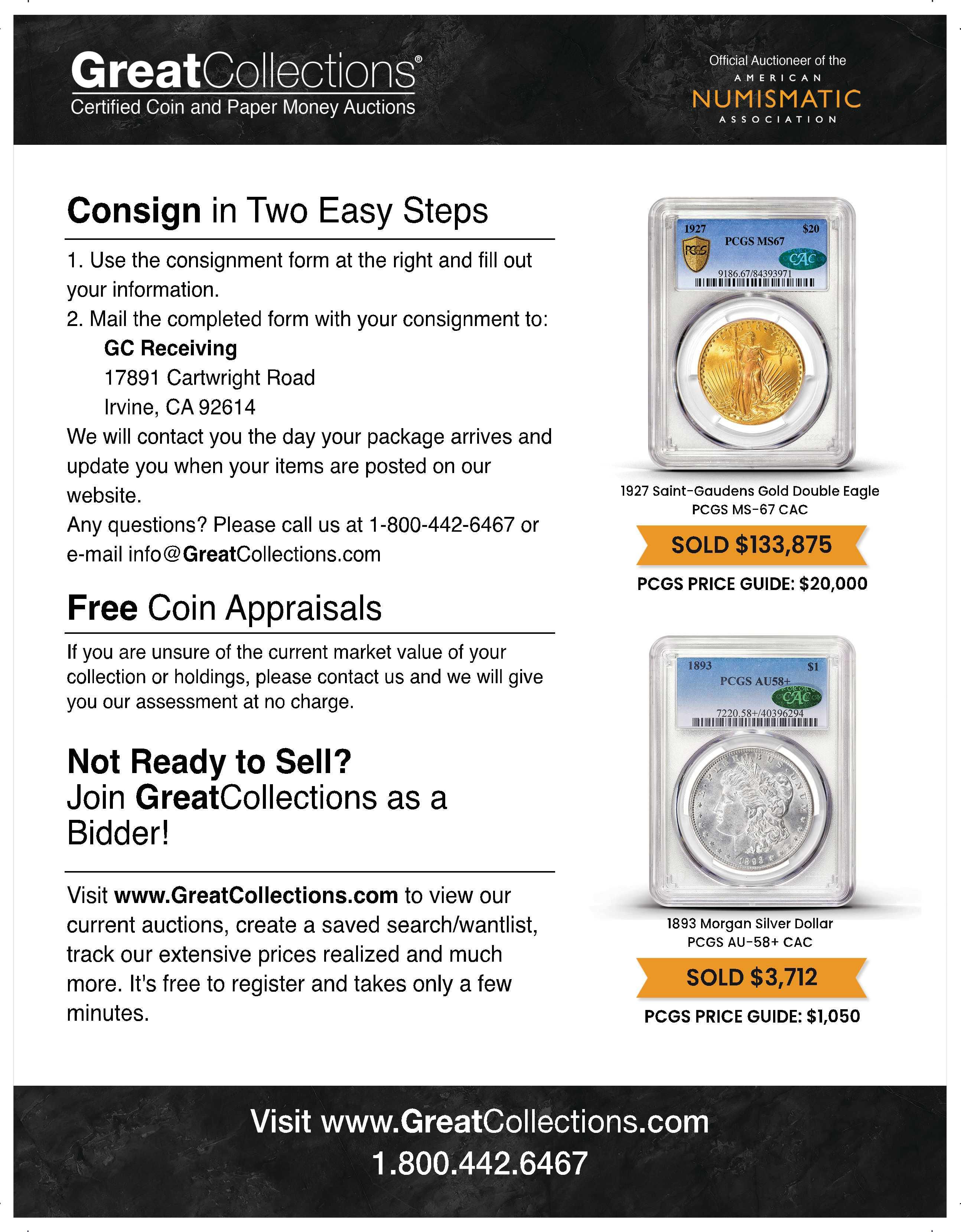
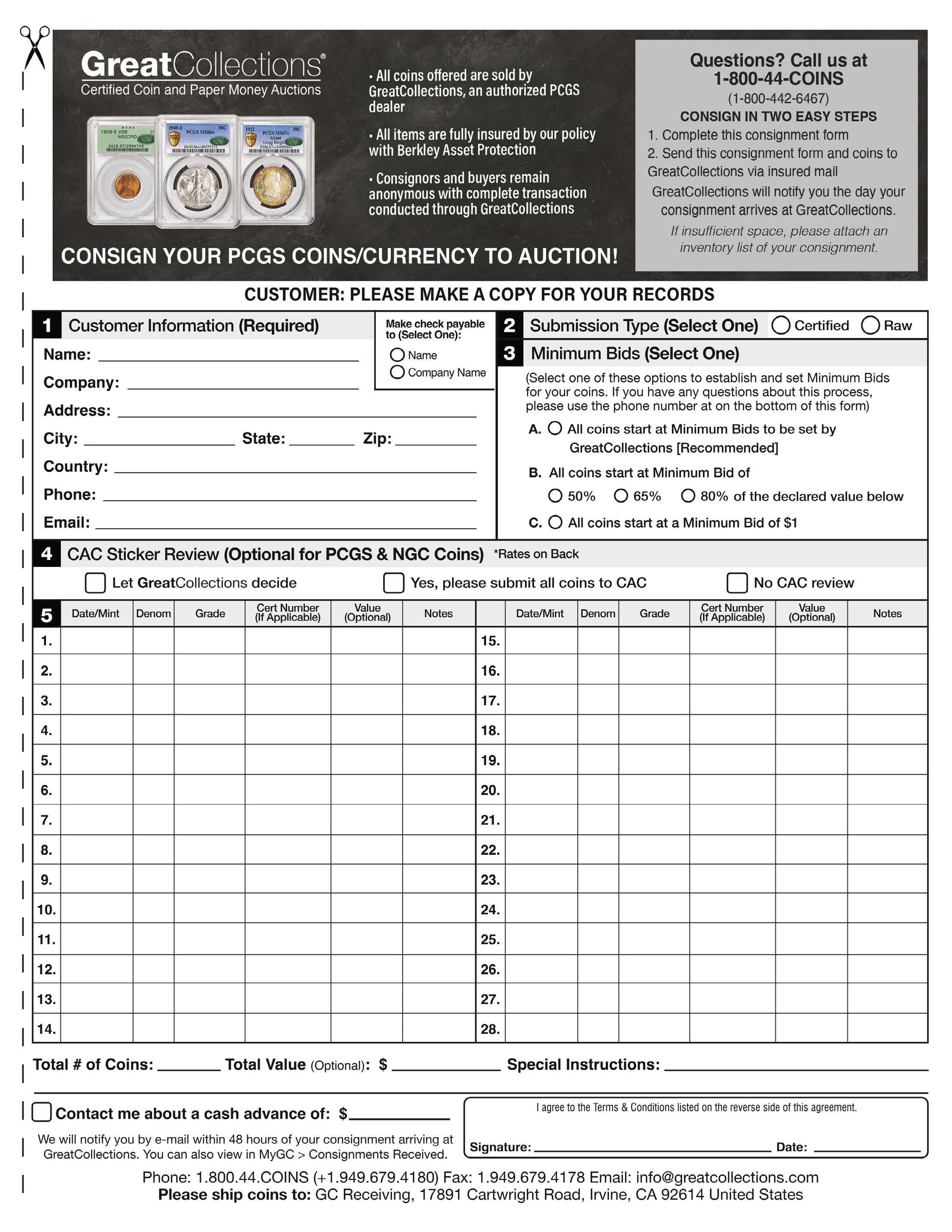

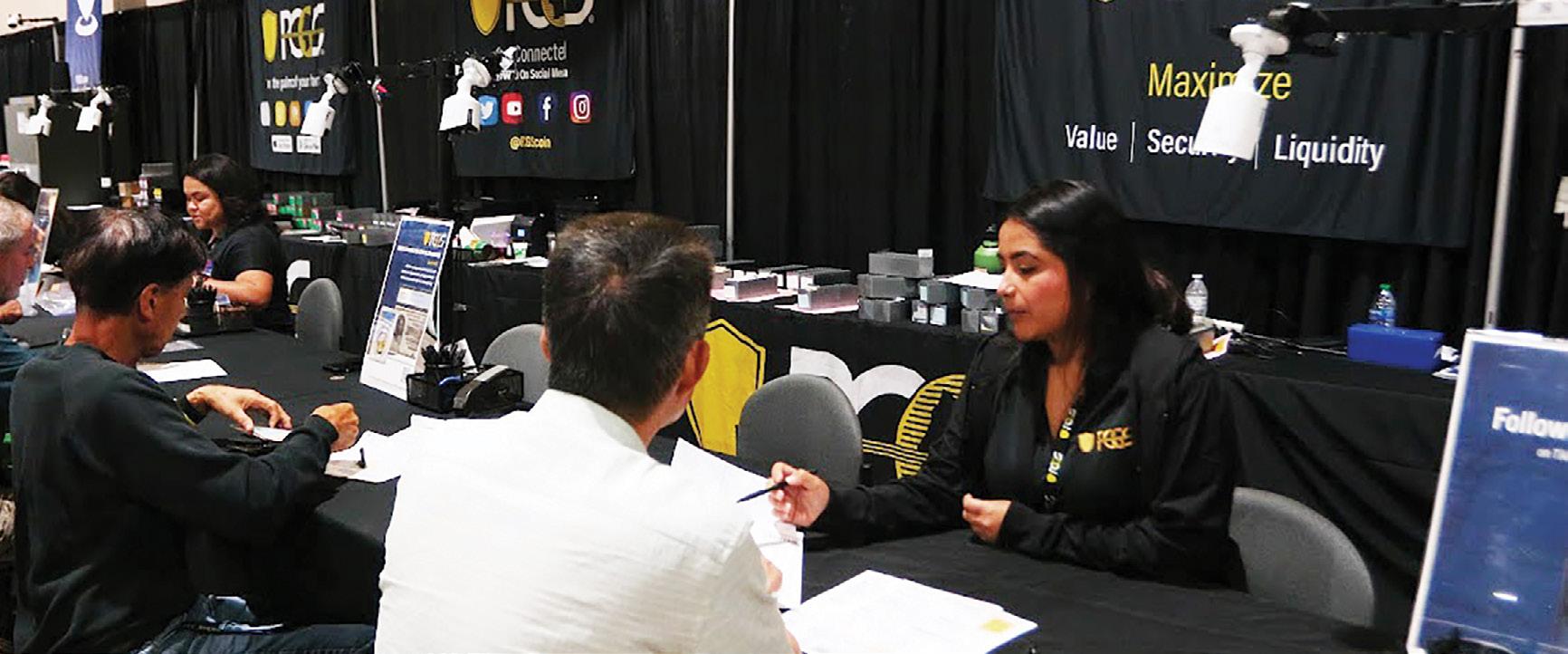
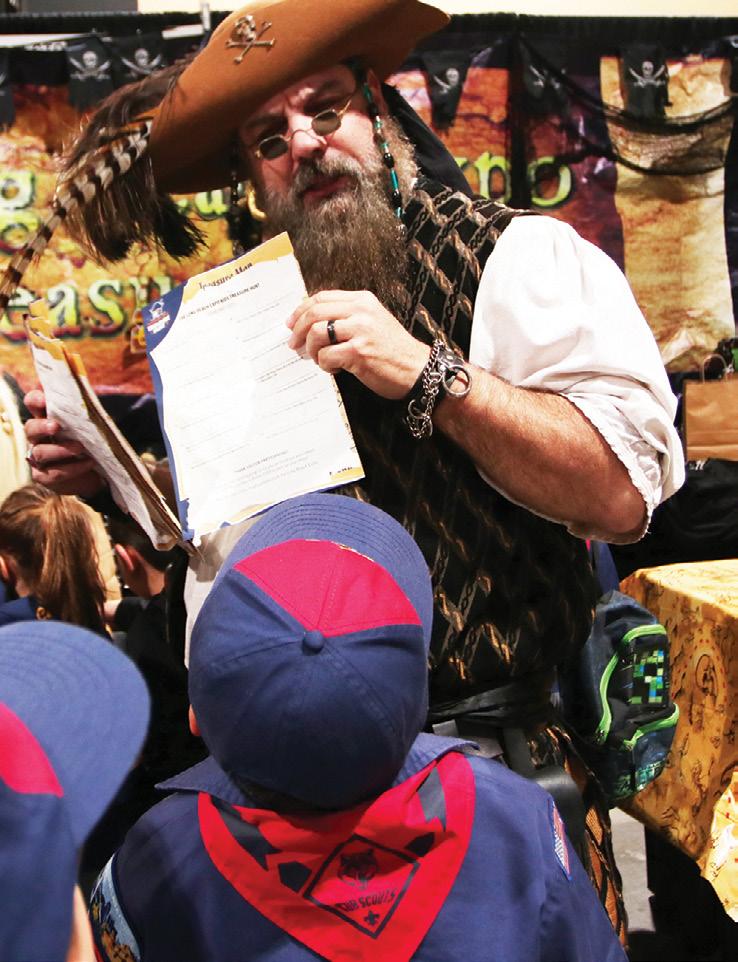

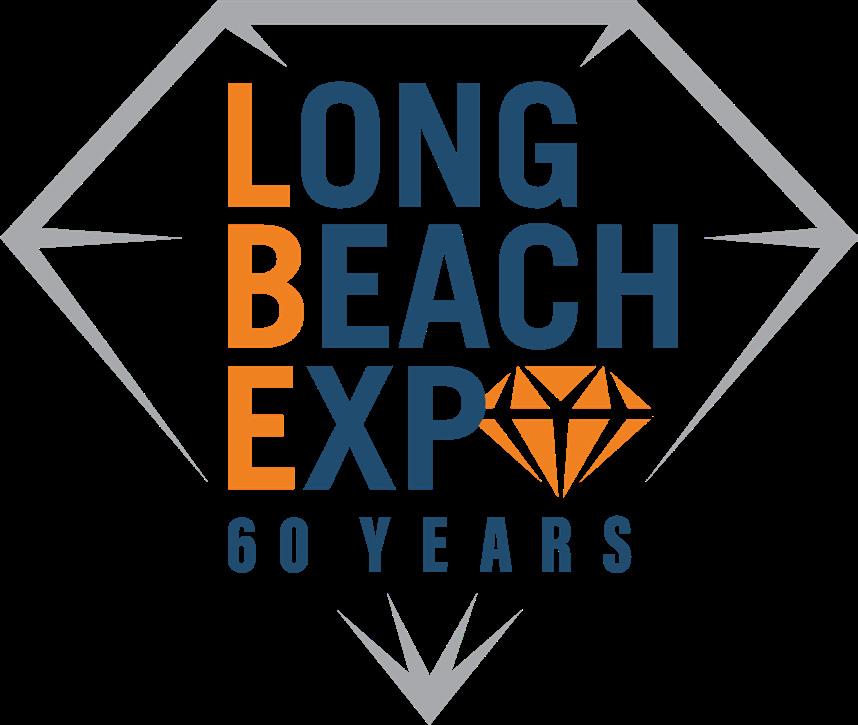


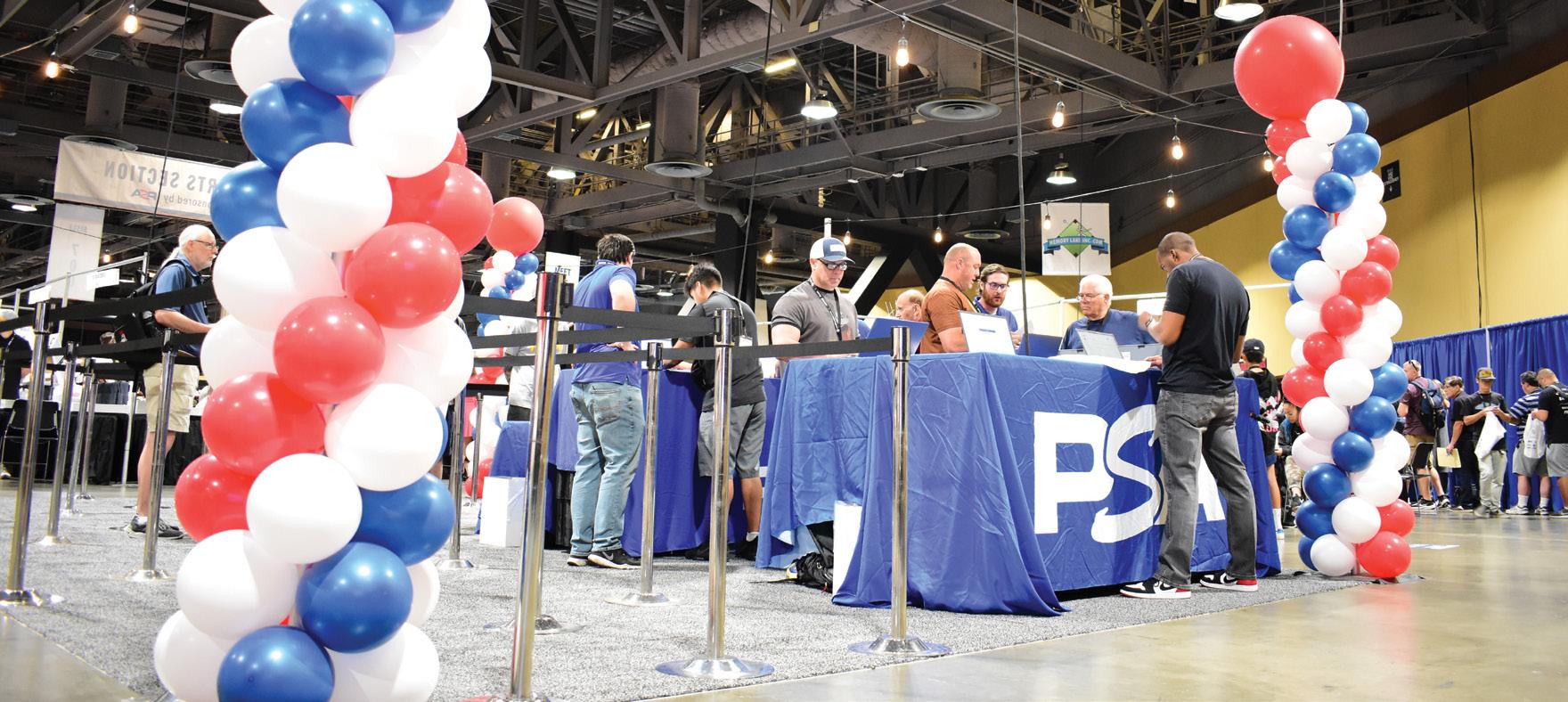





1864
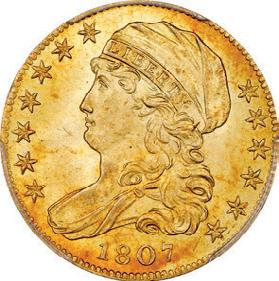
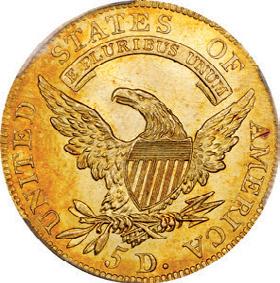


Presented to Dr. Herbert E. Gregory of the Captain Cook


